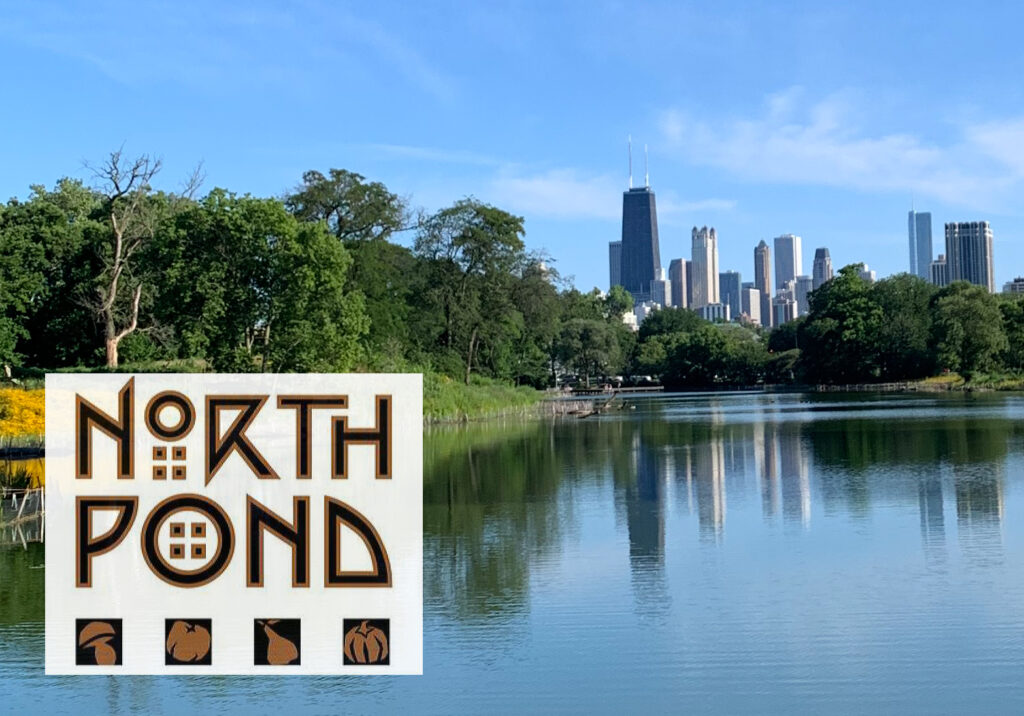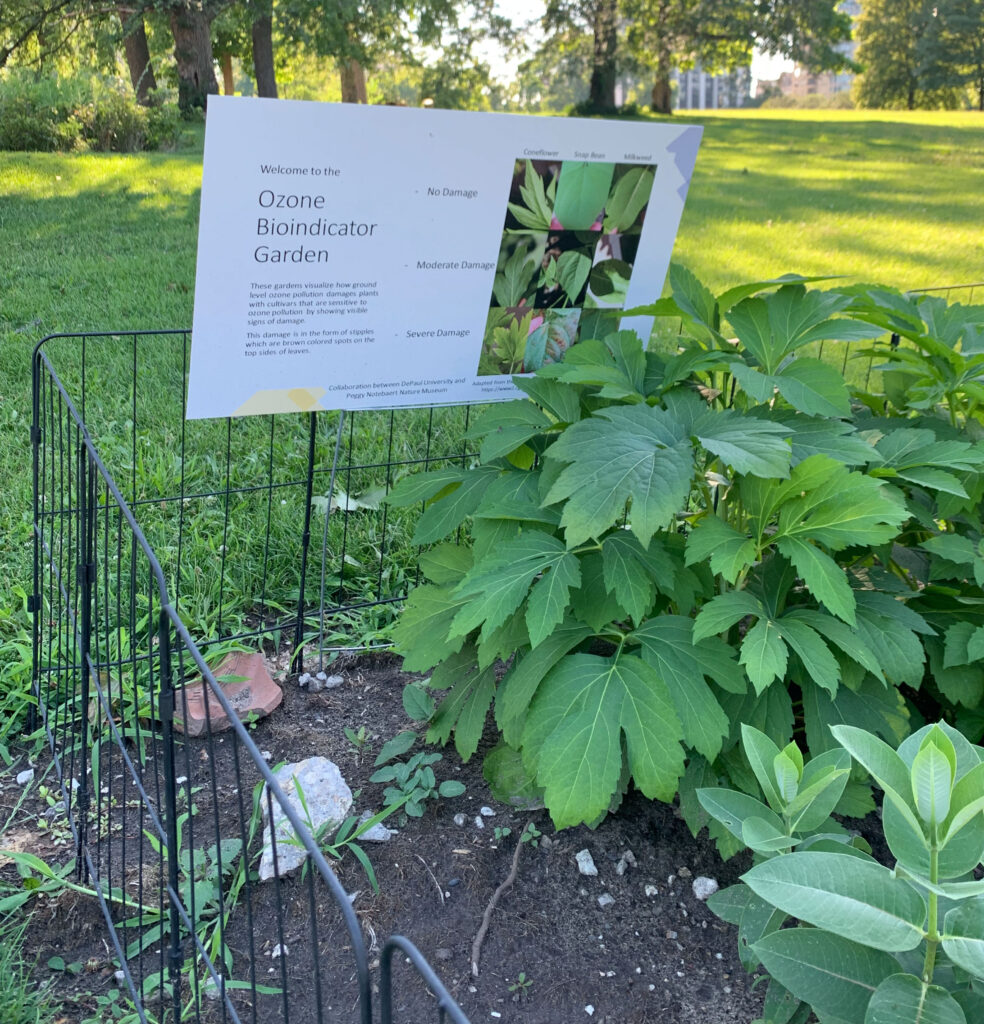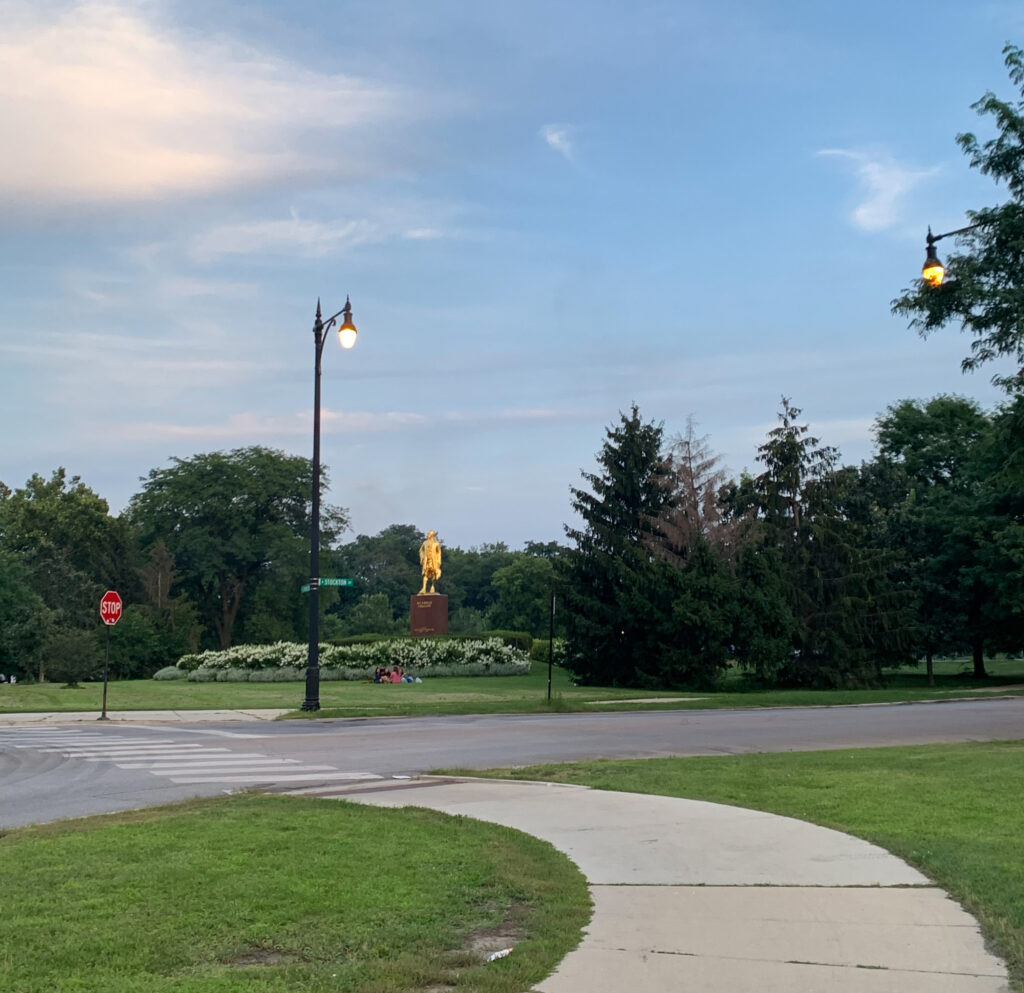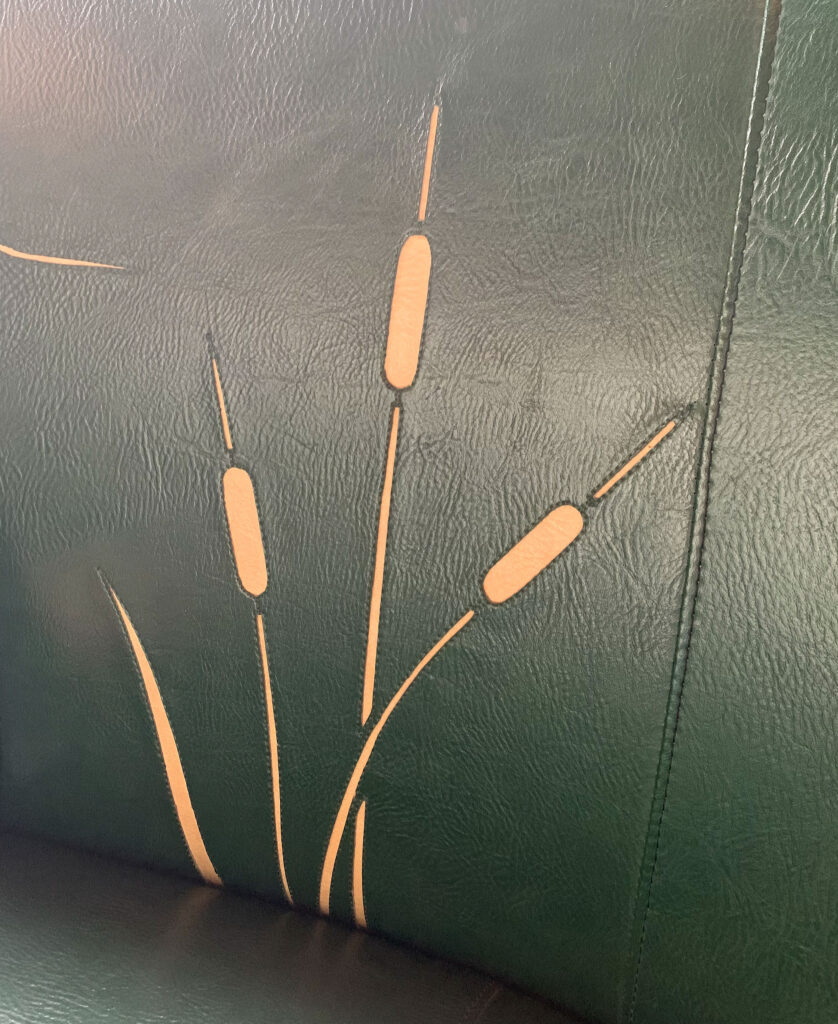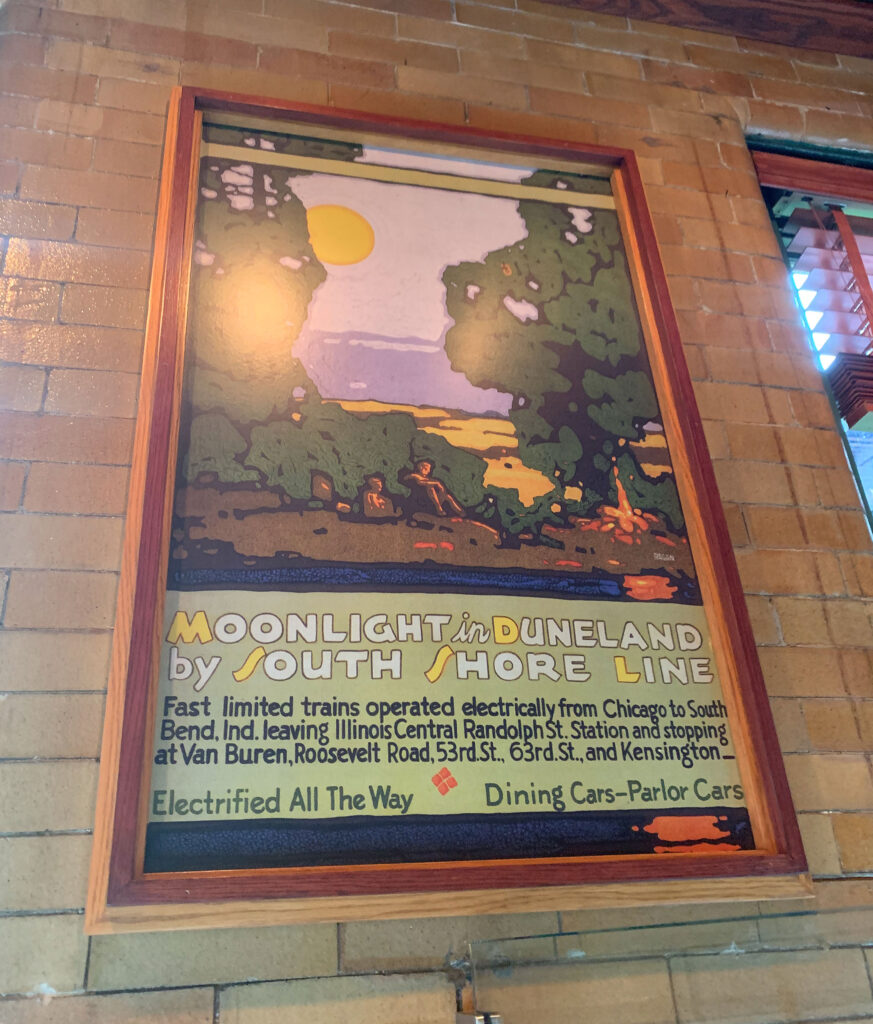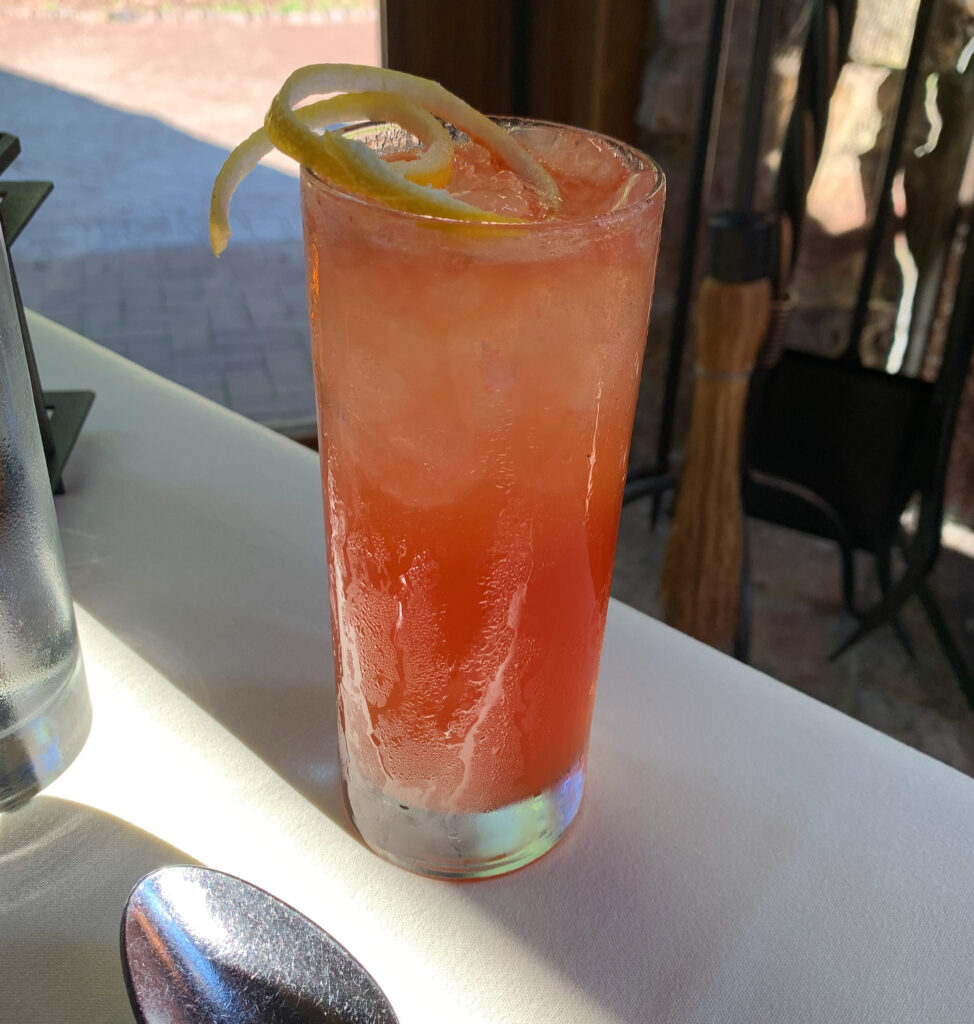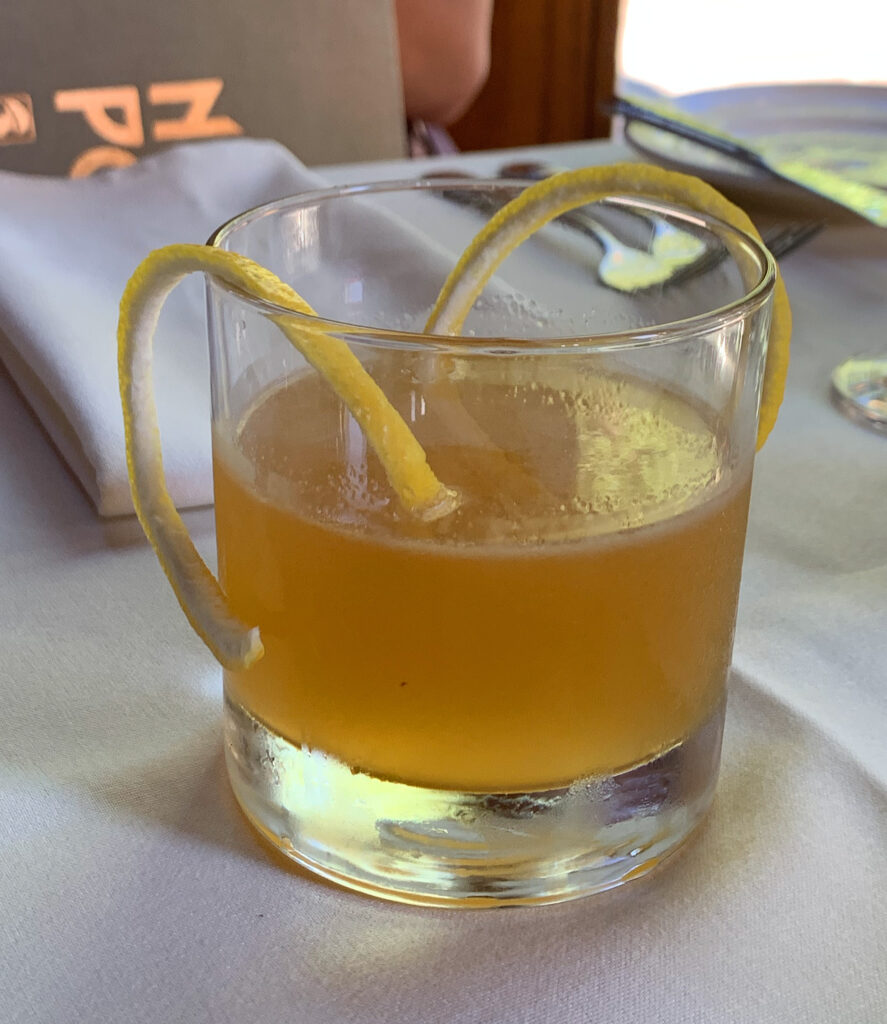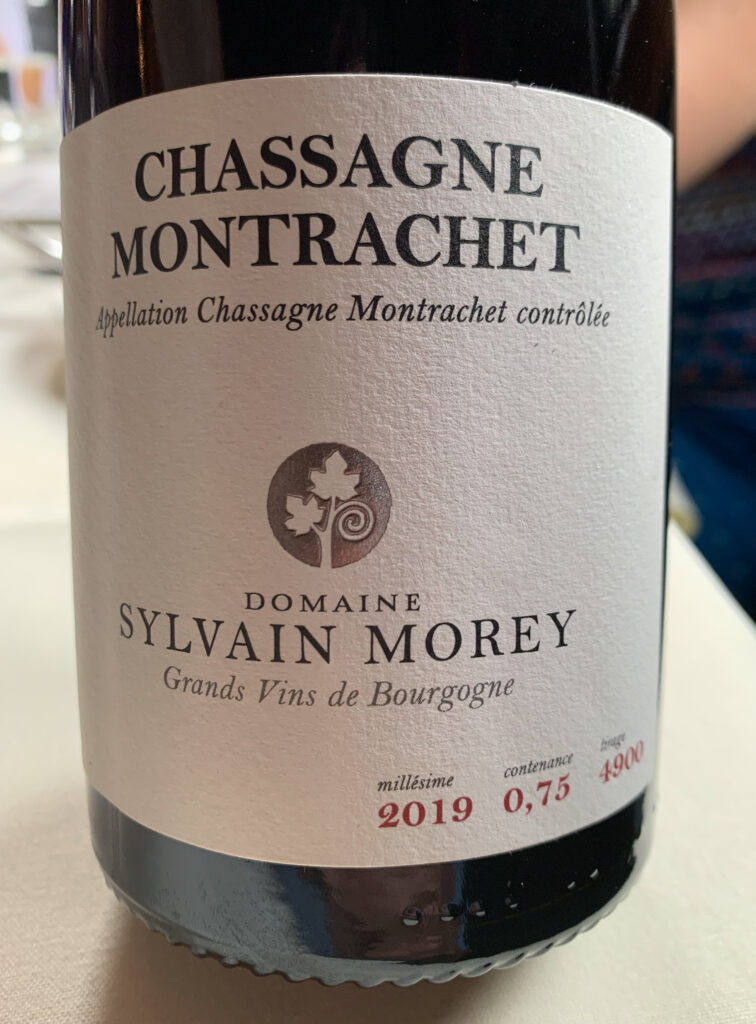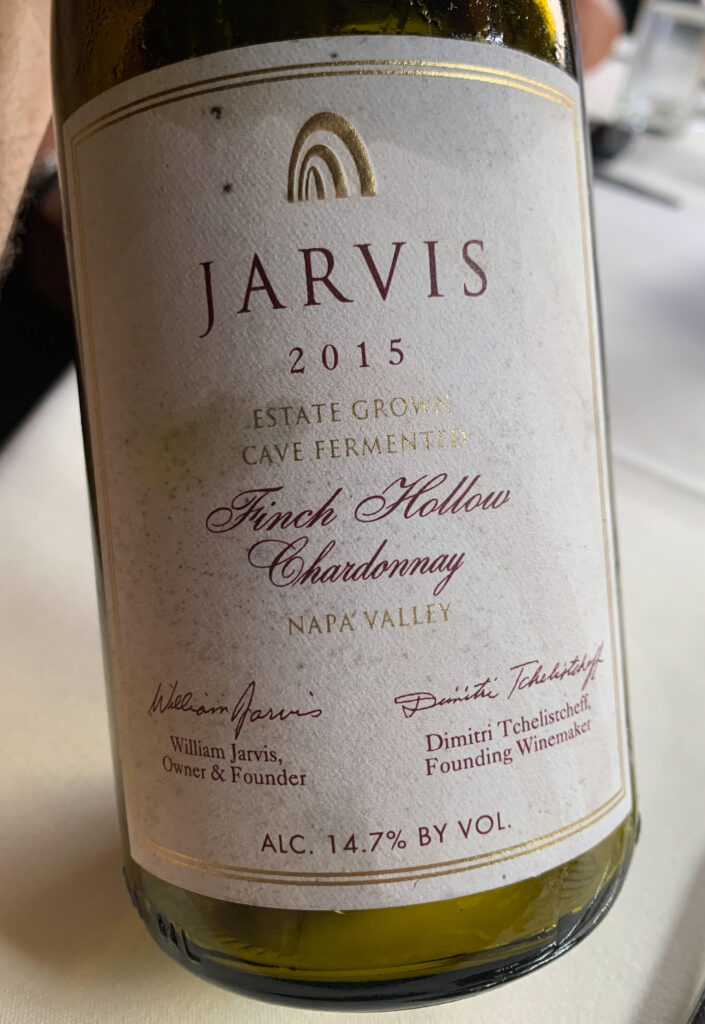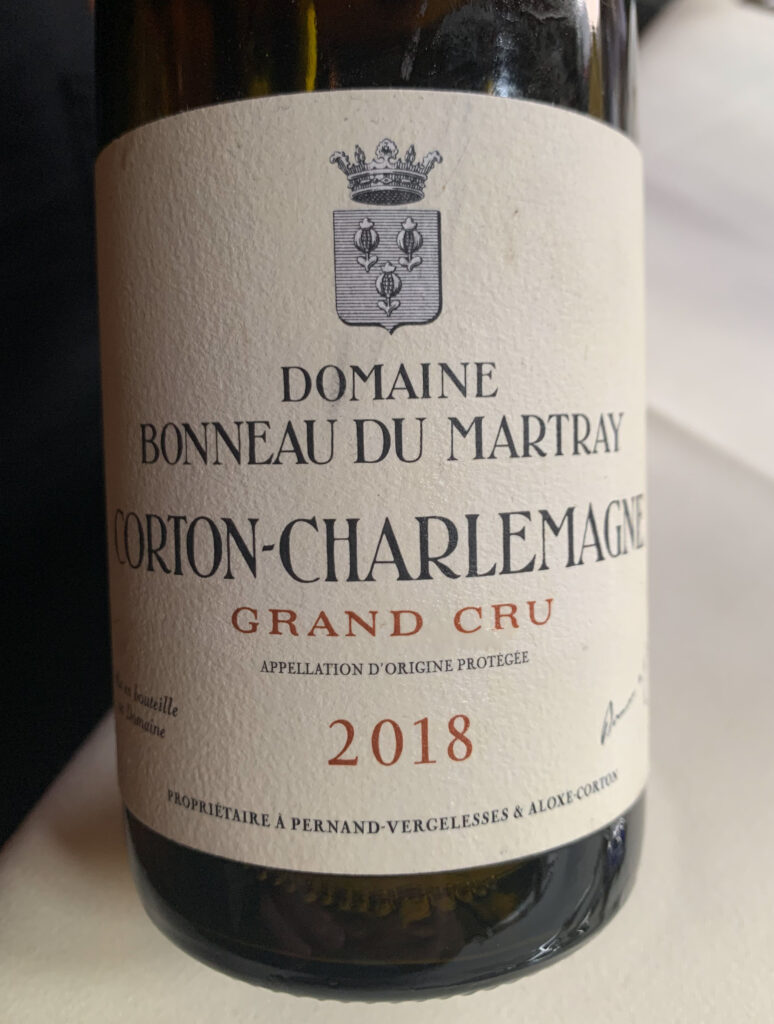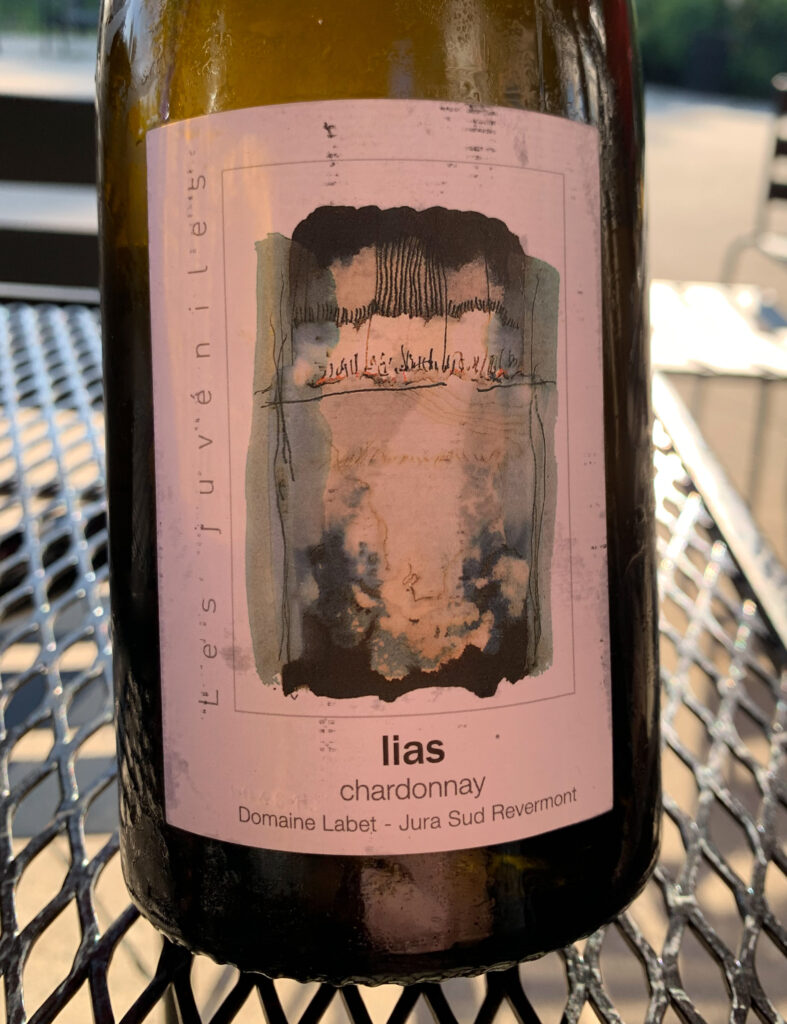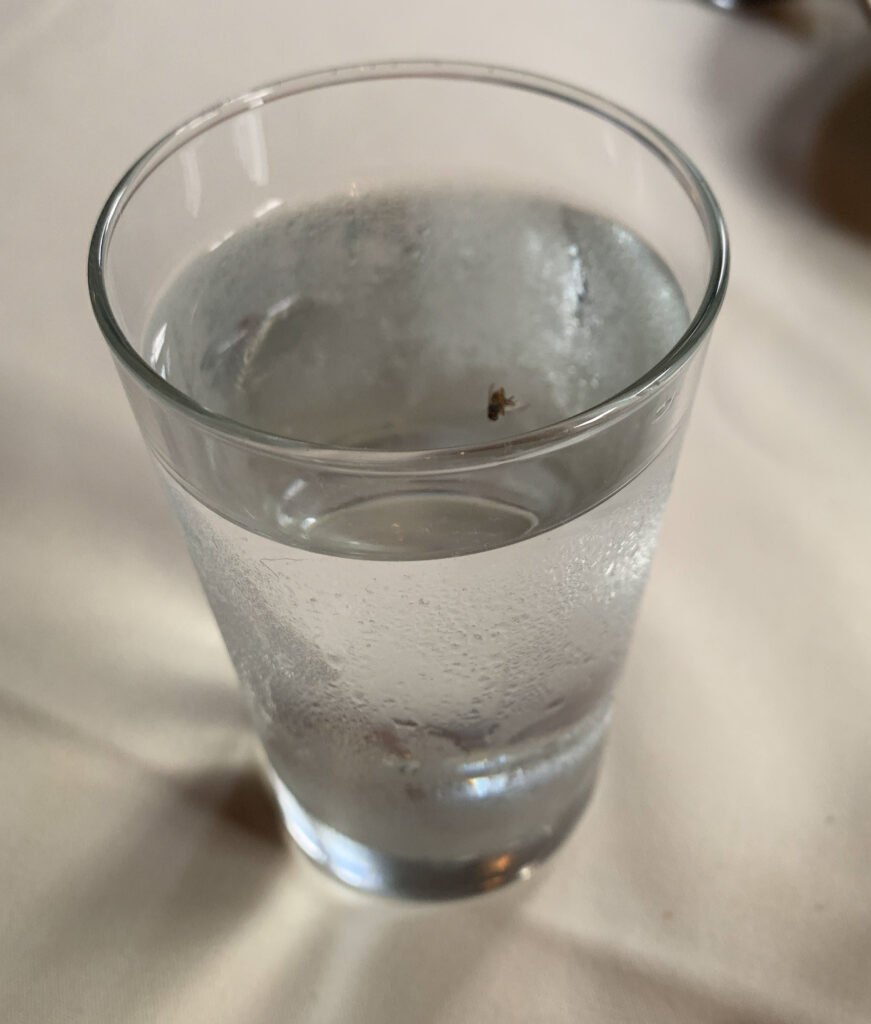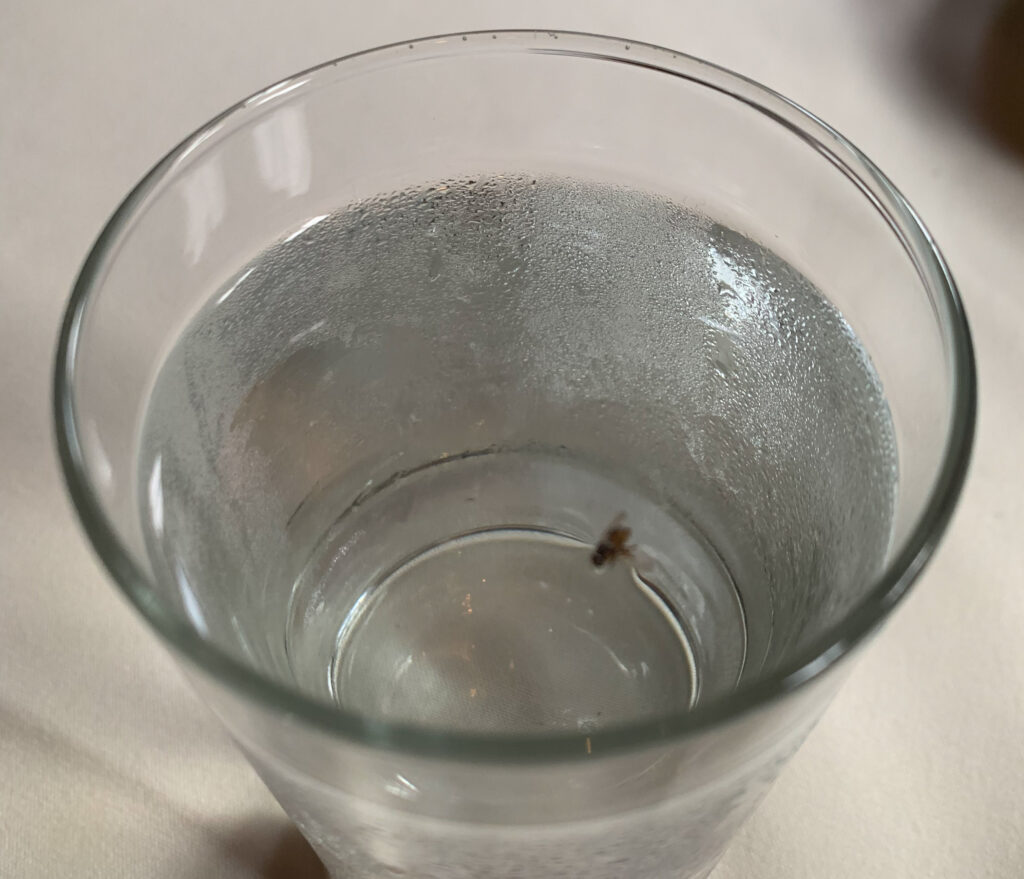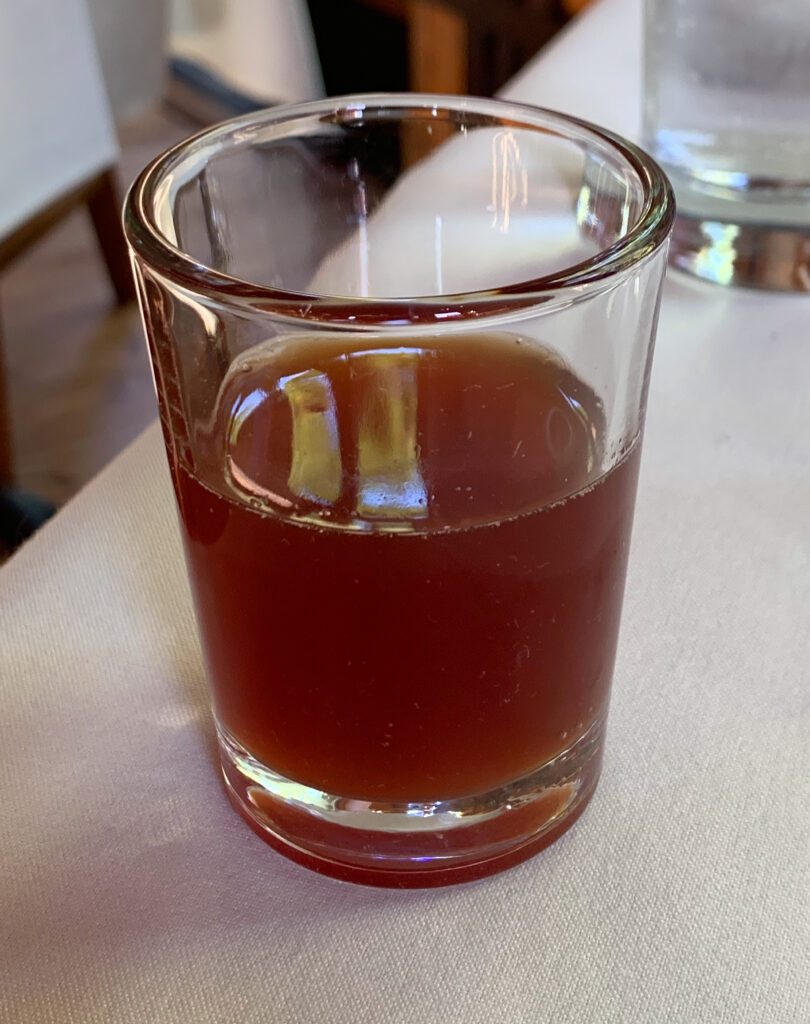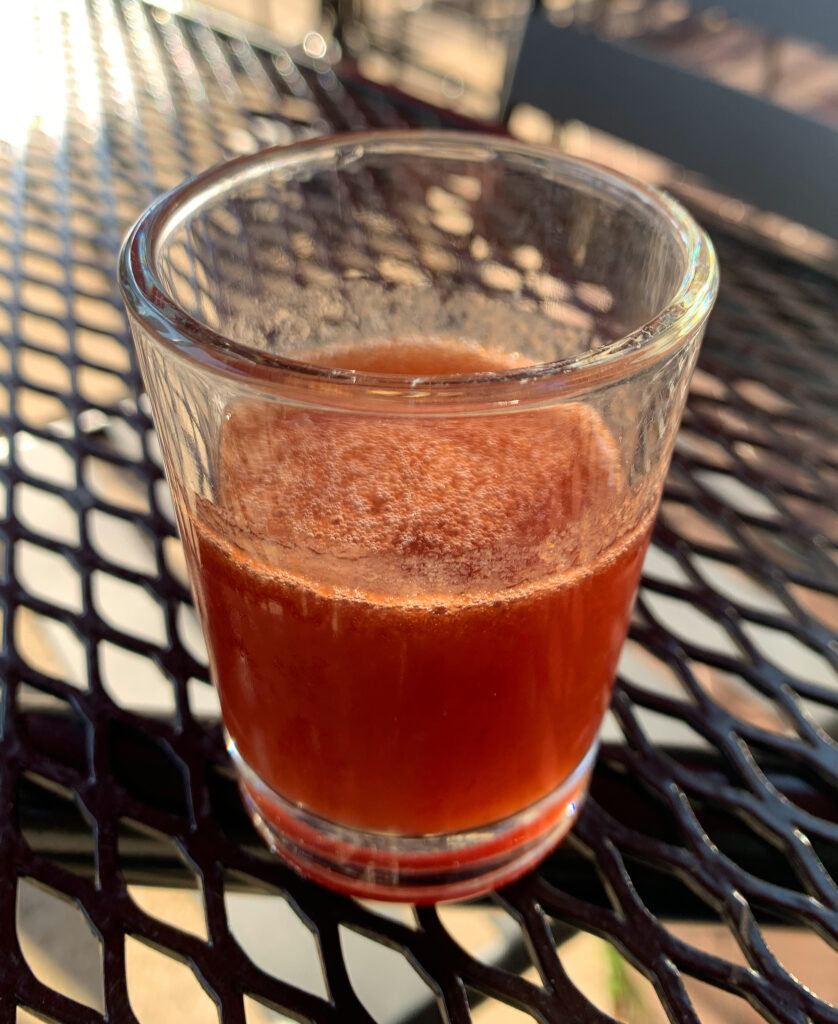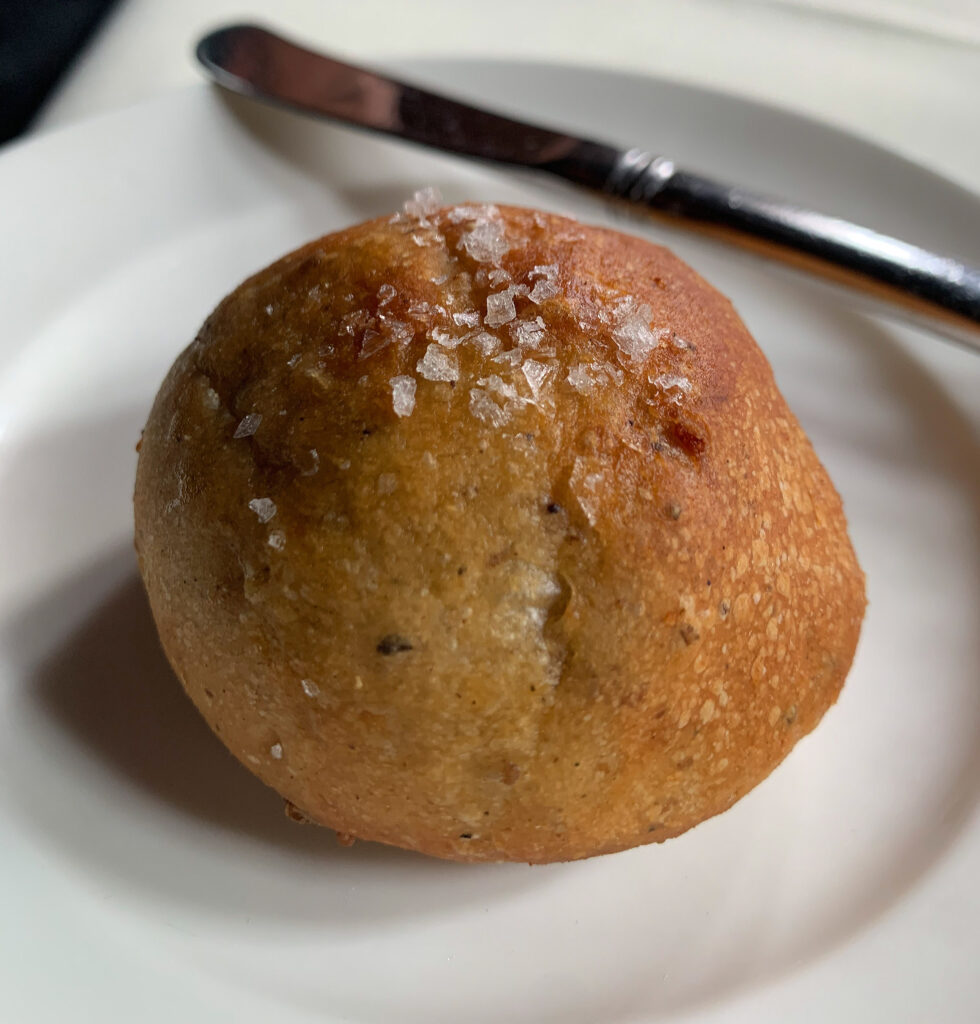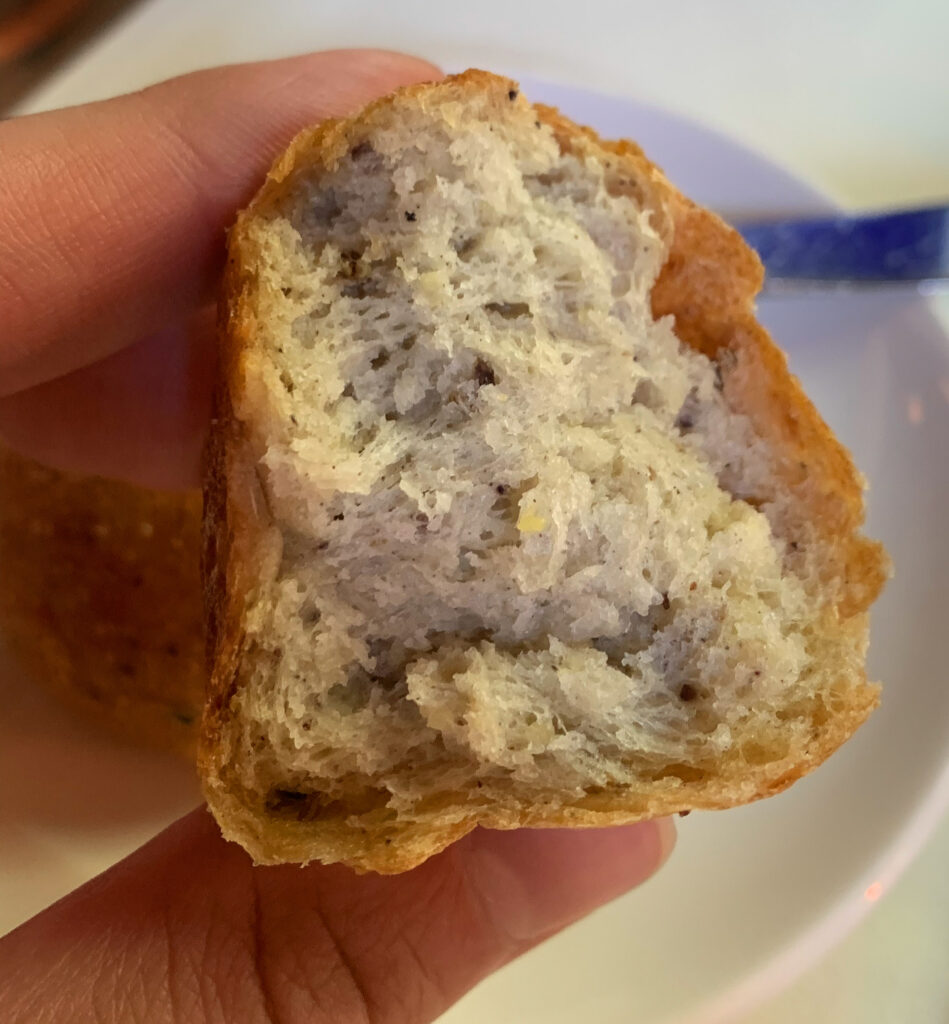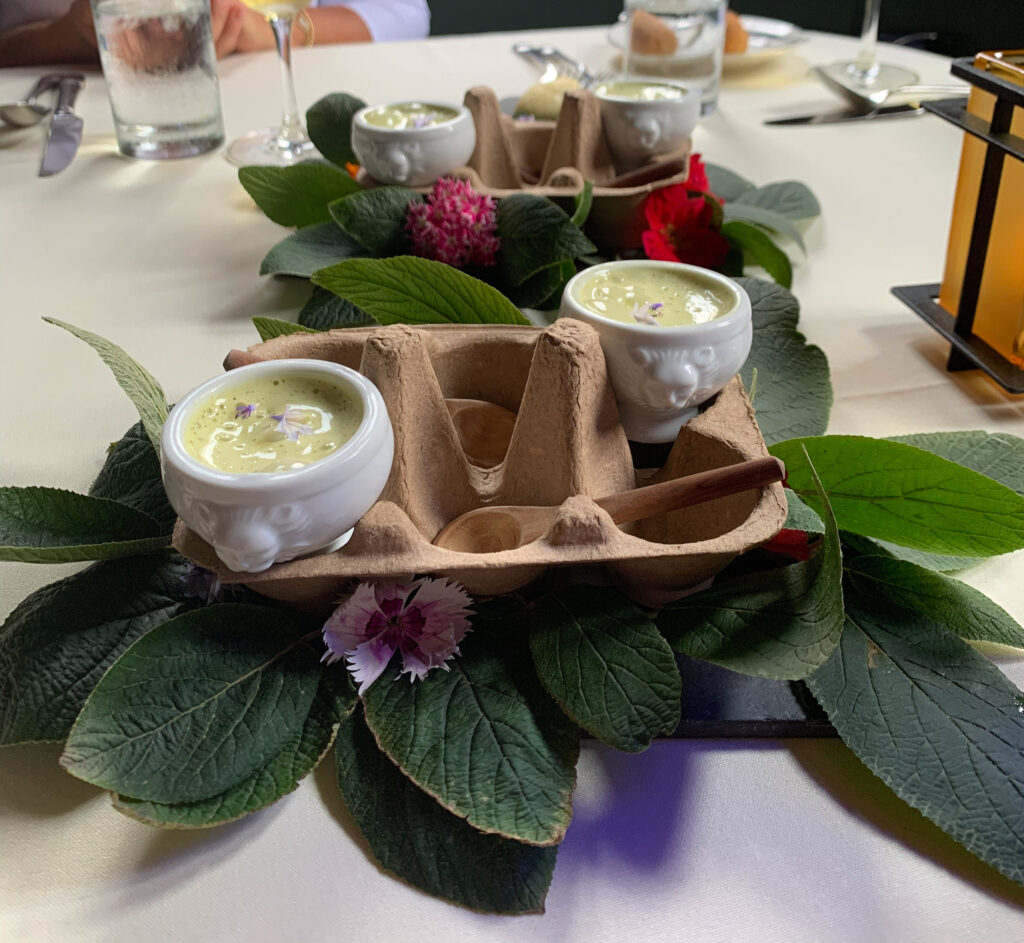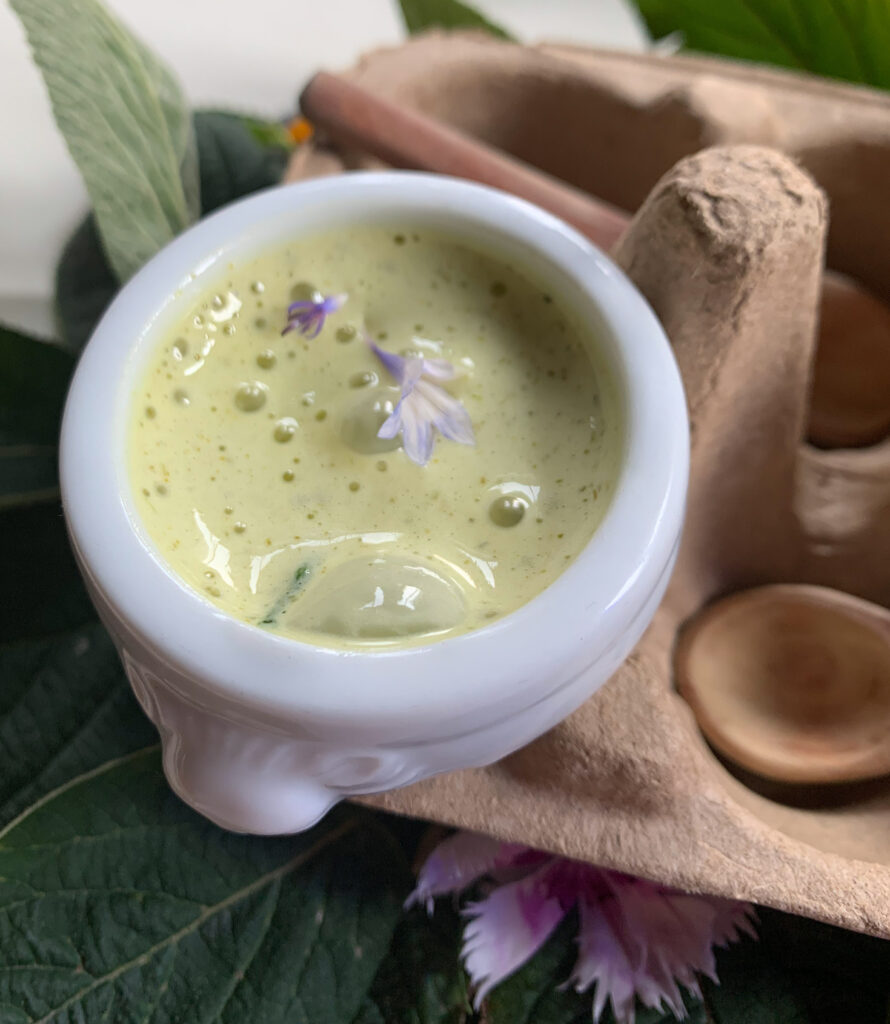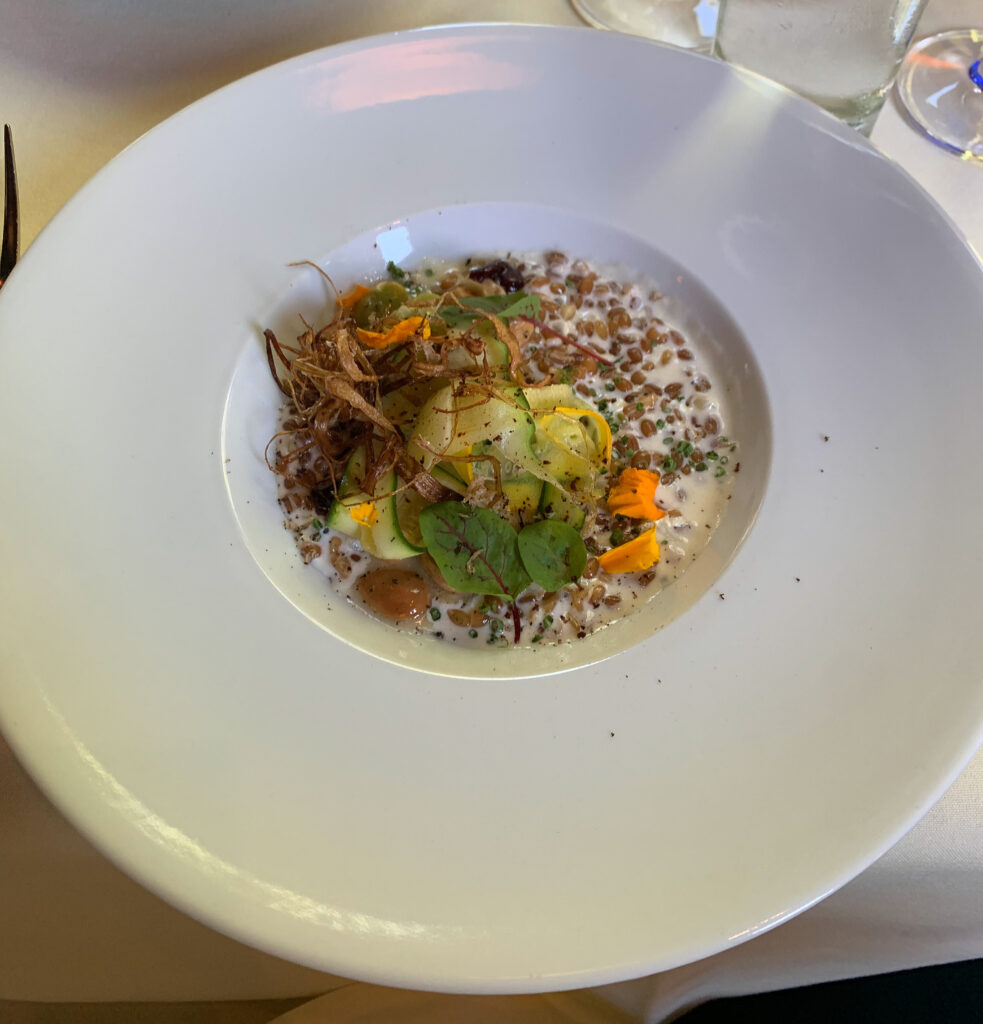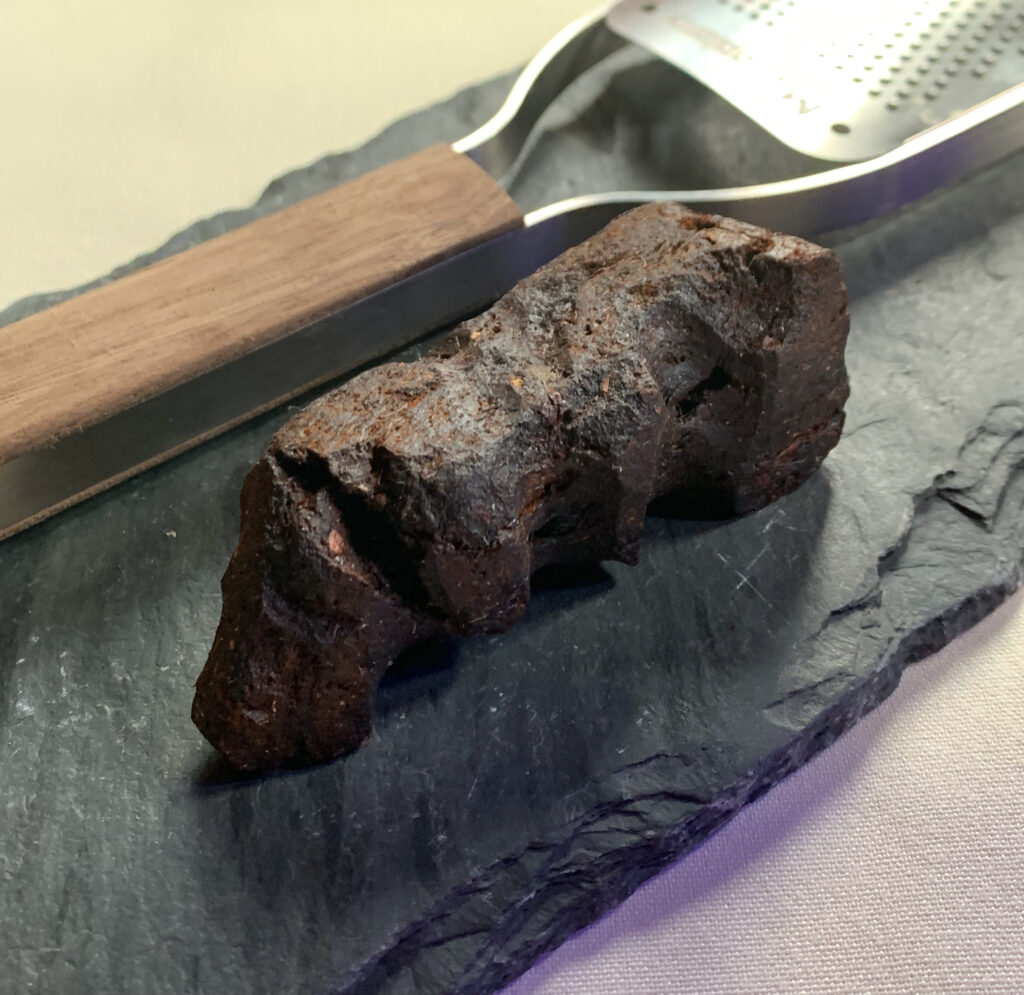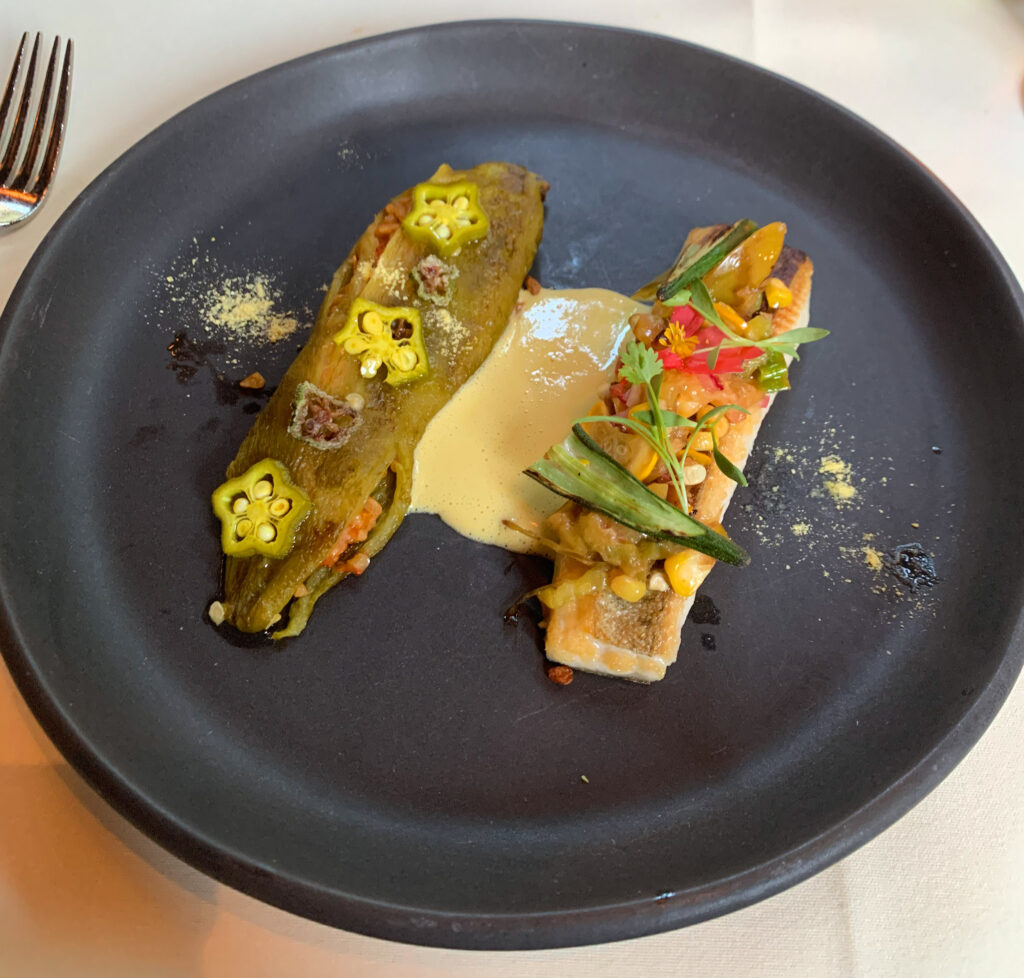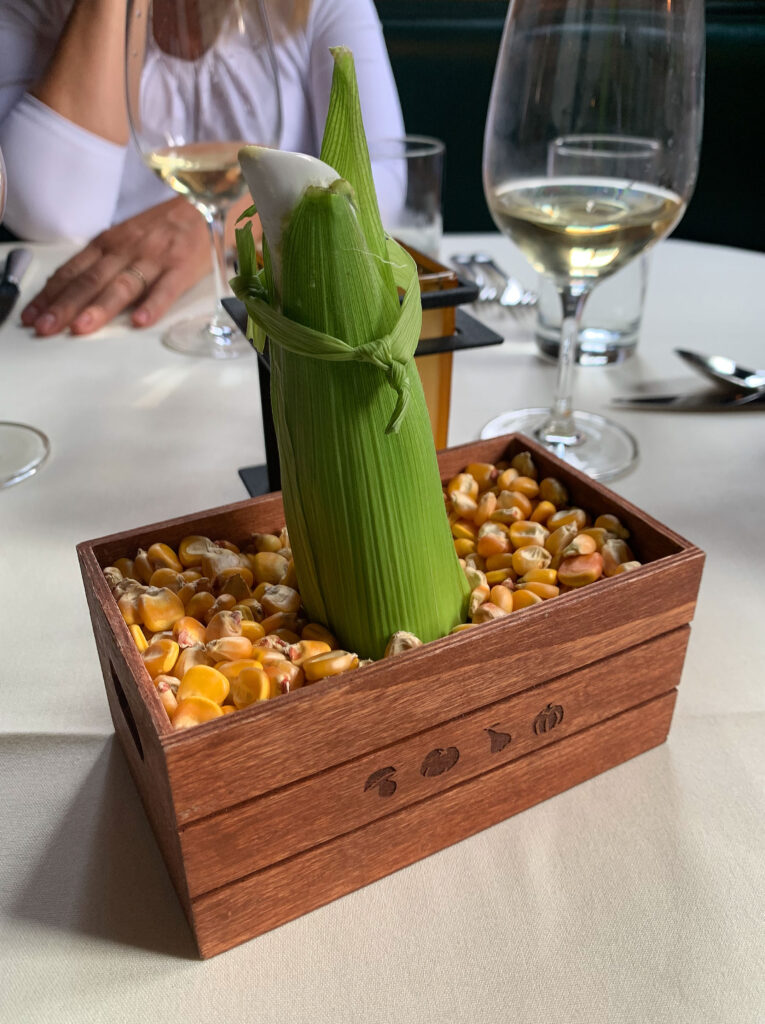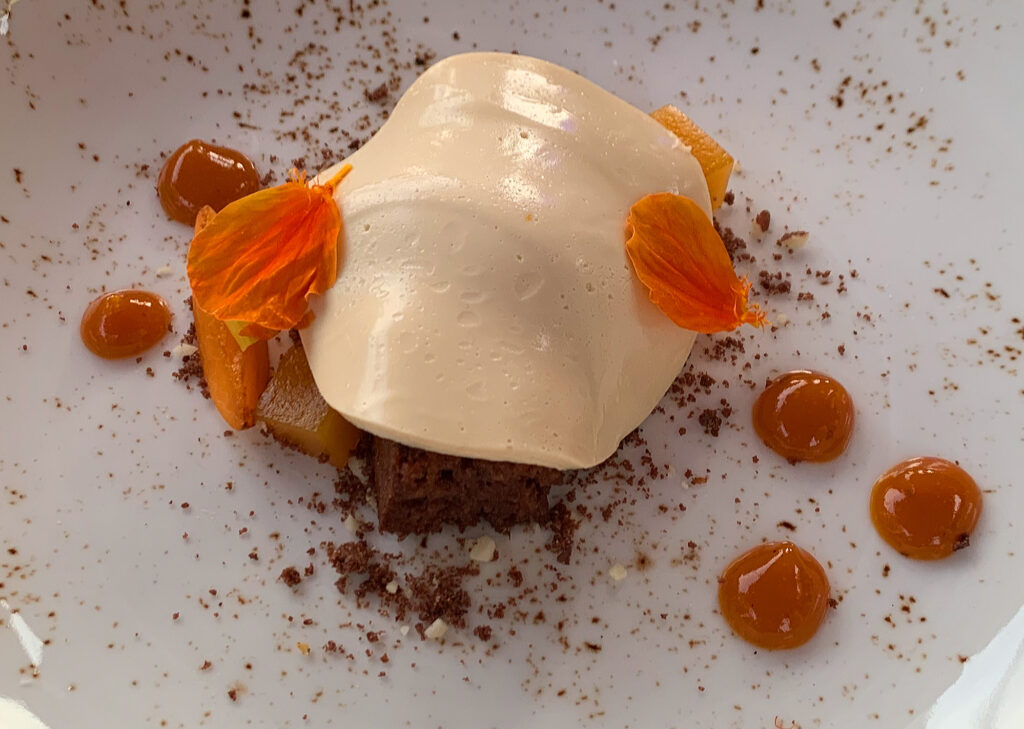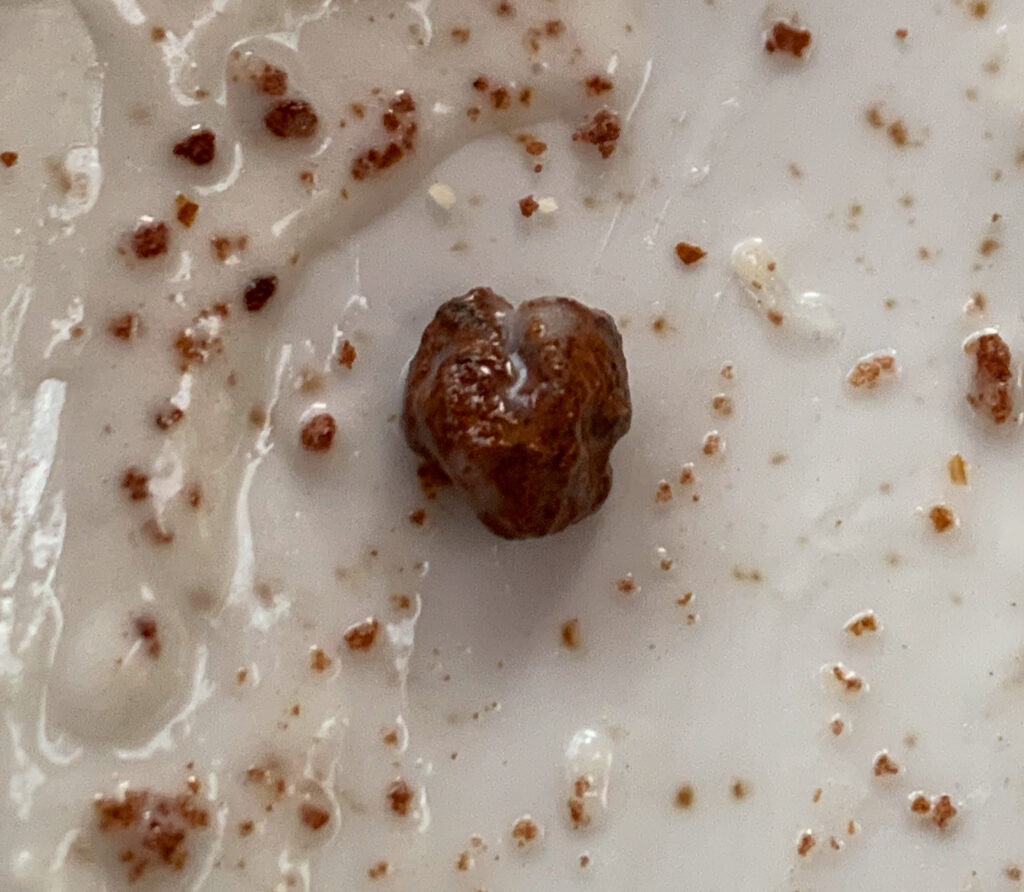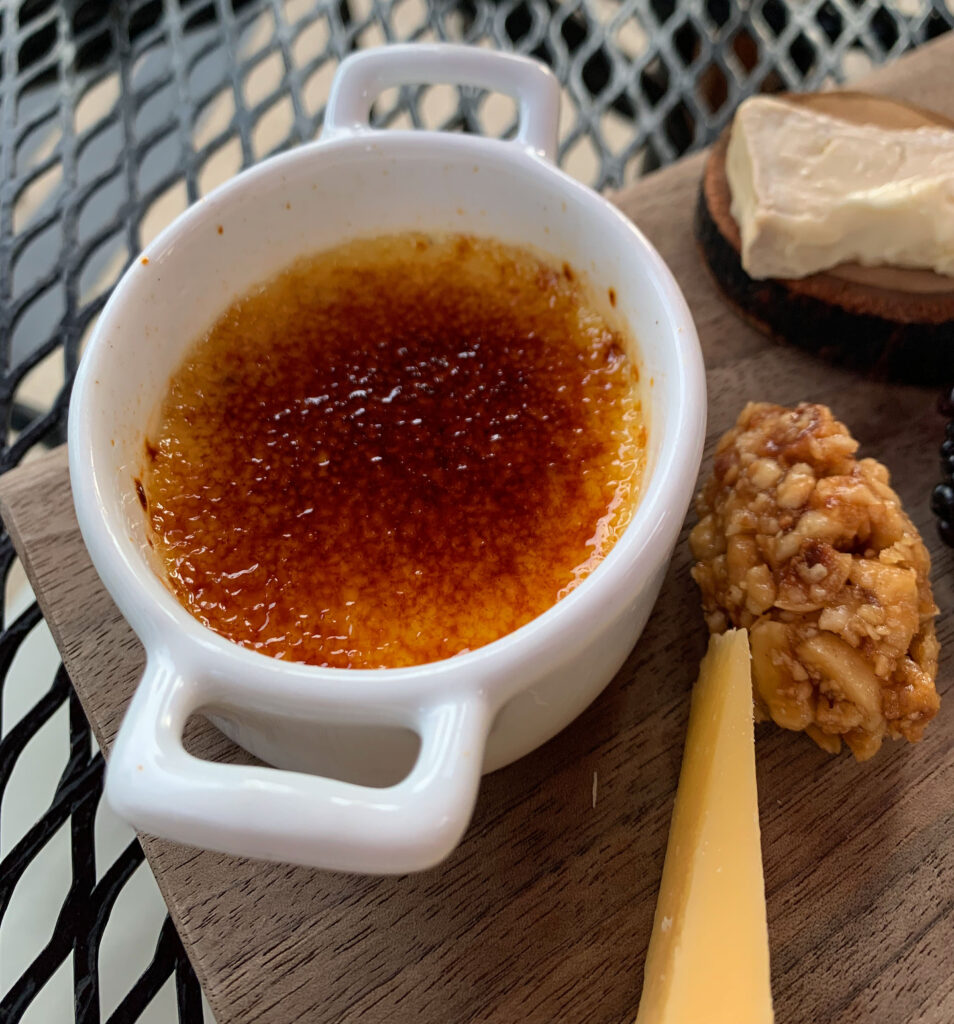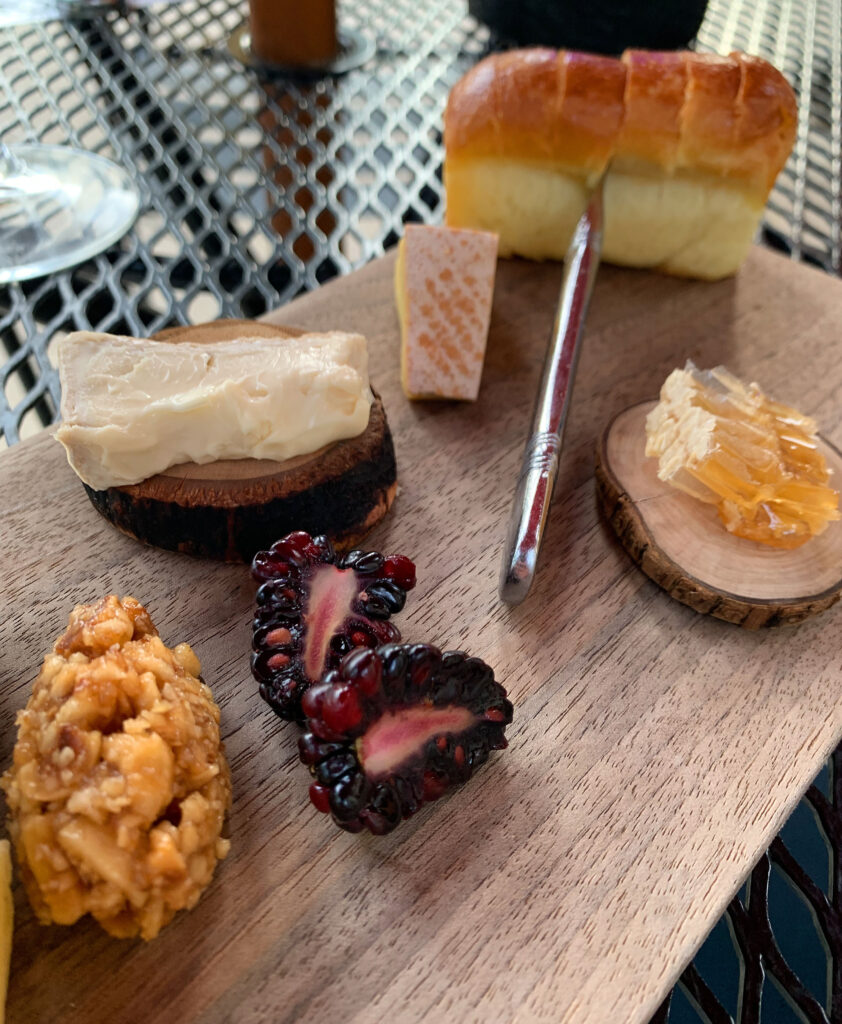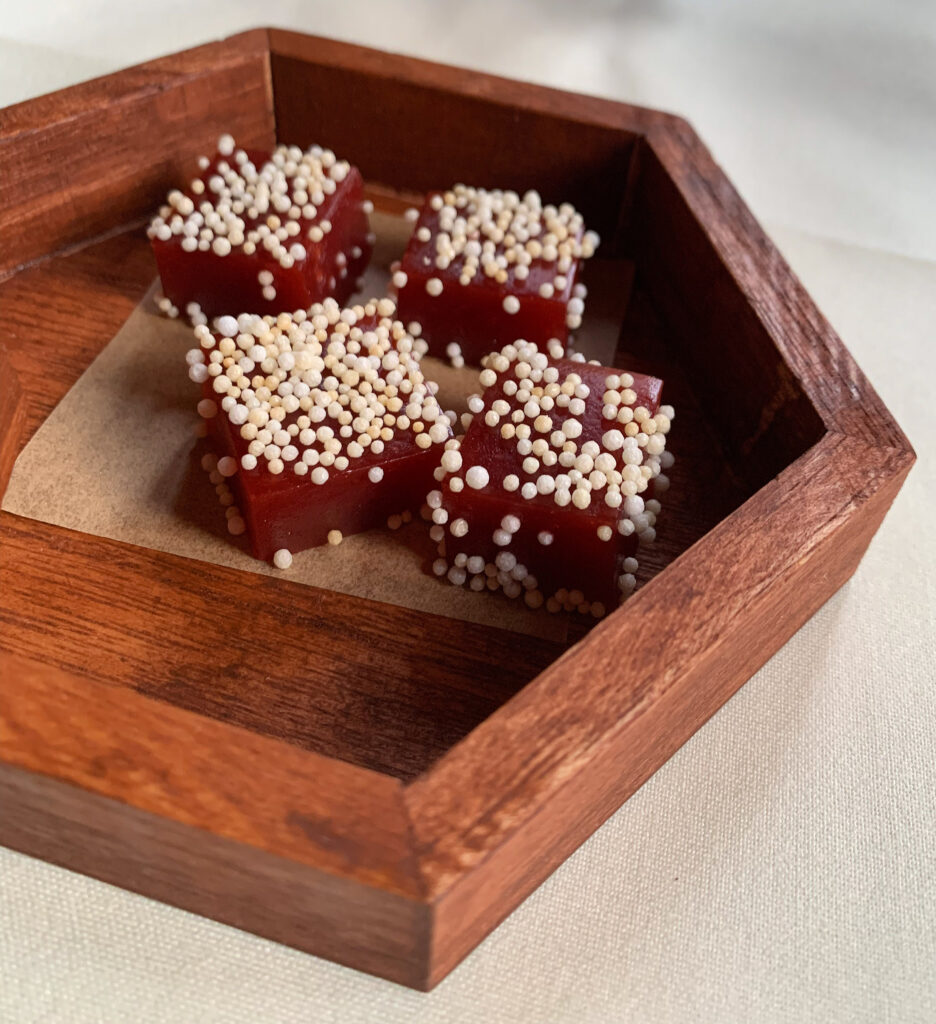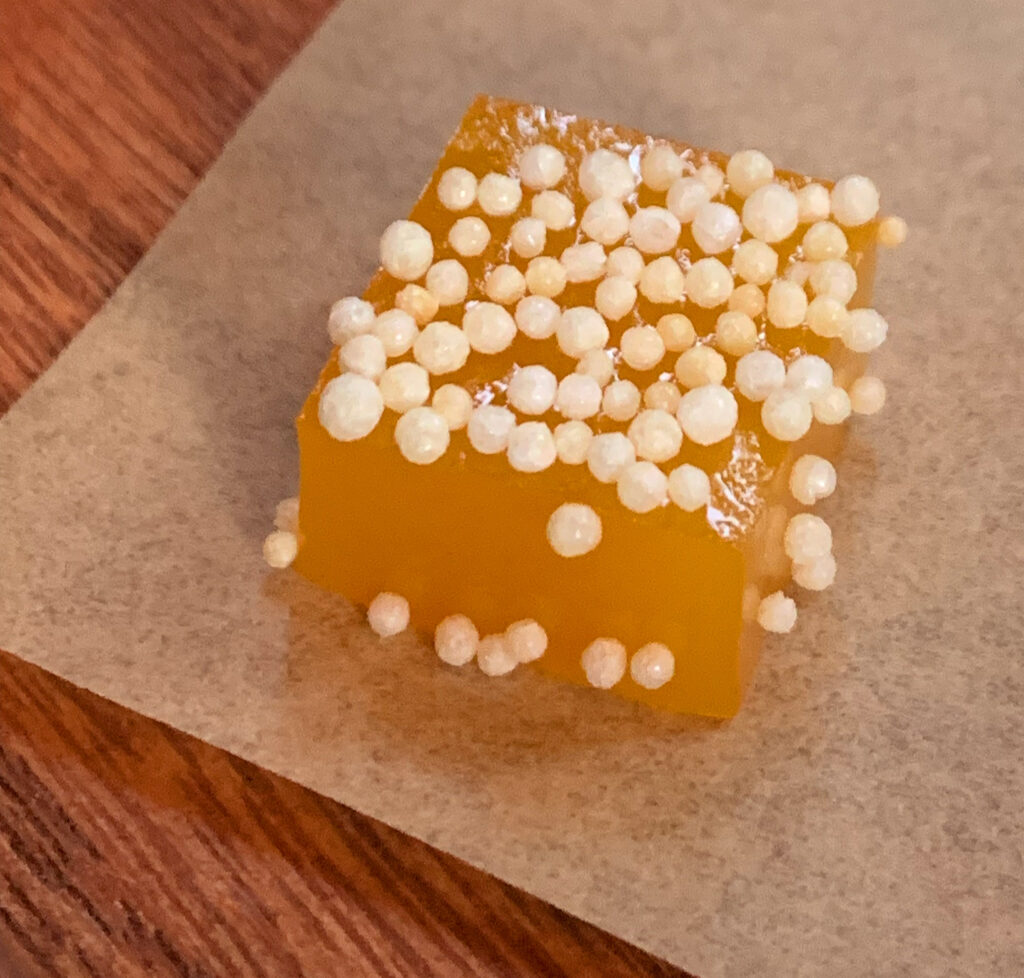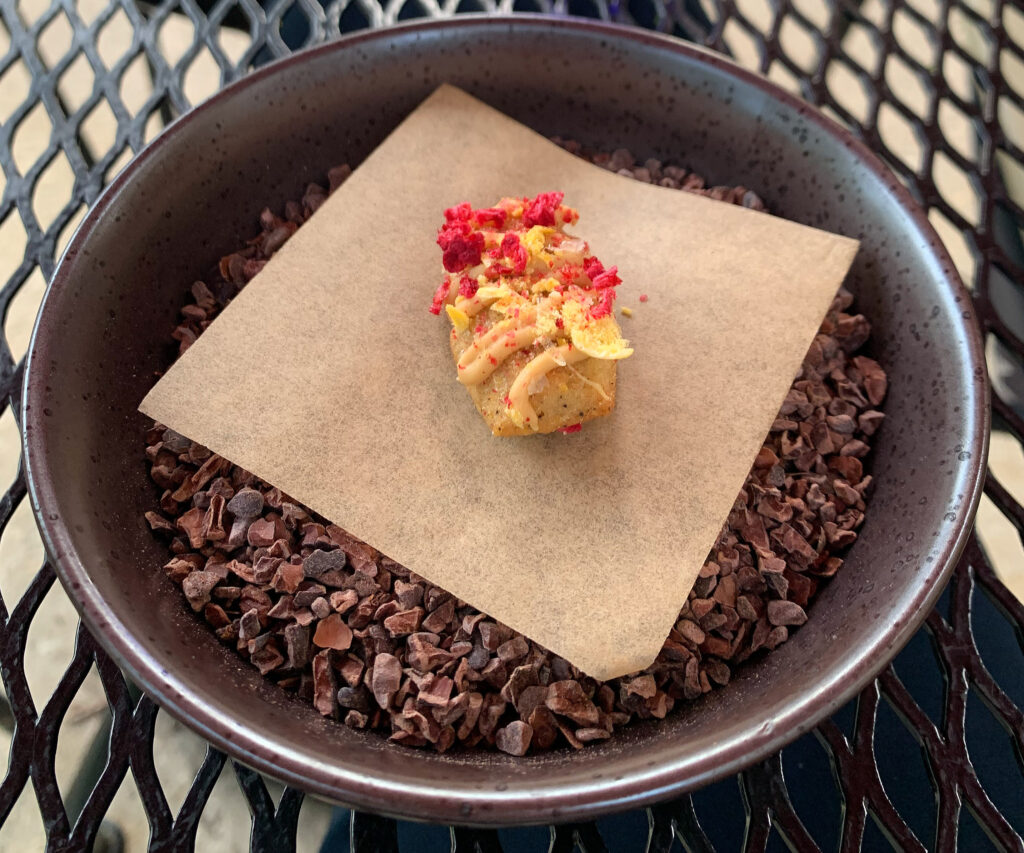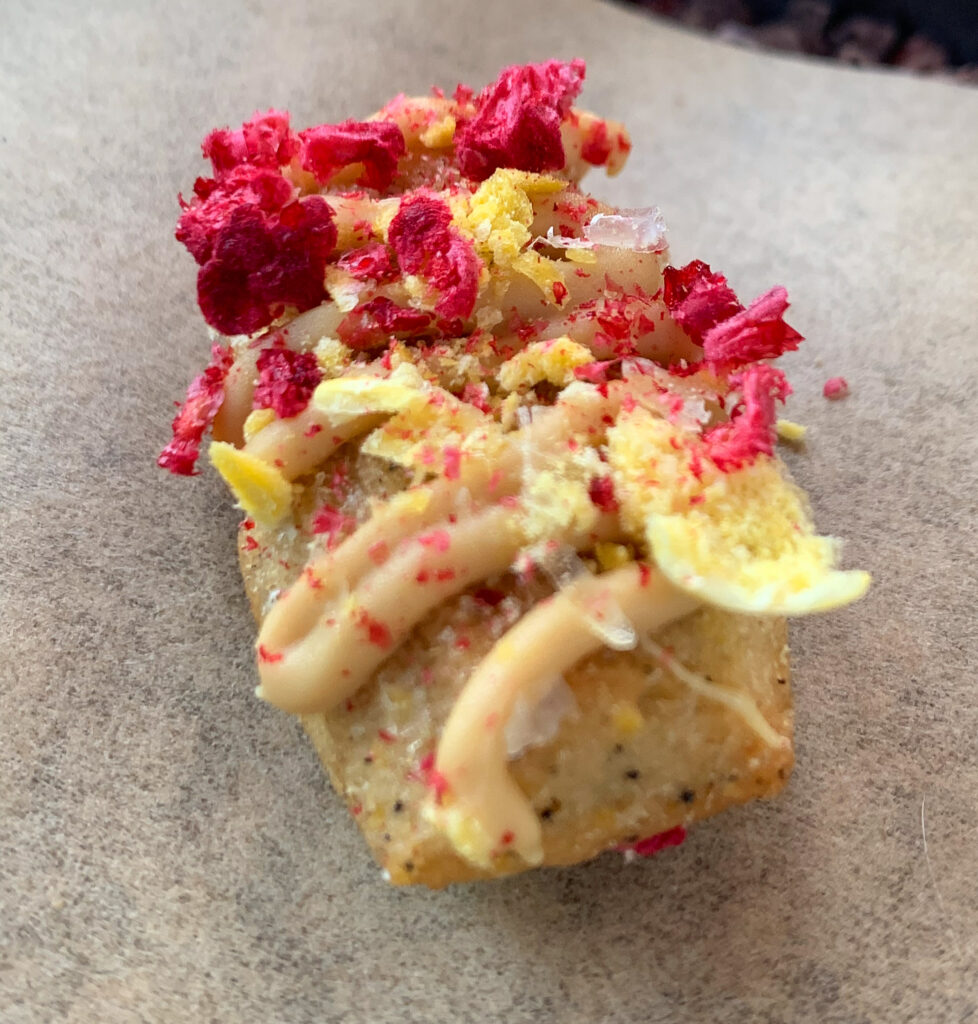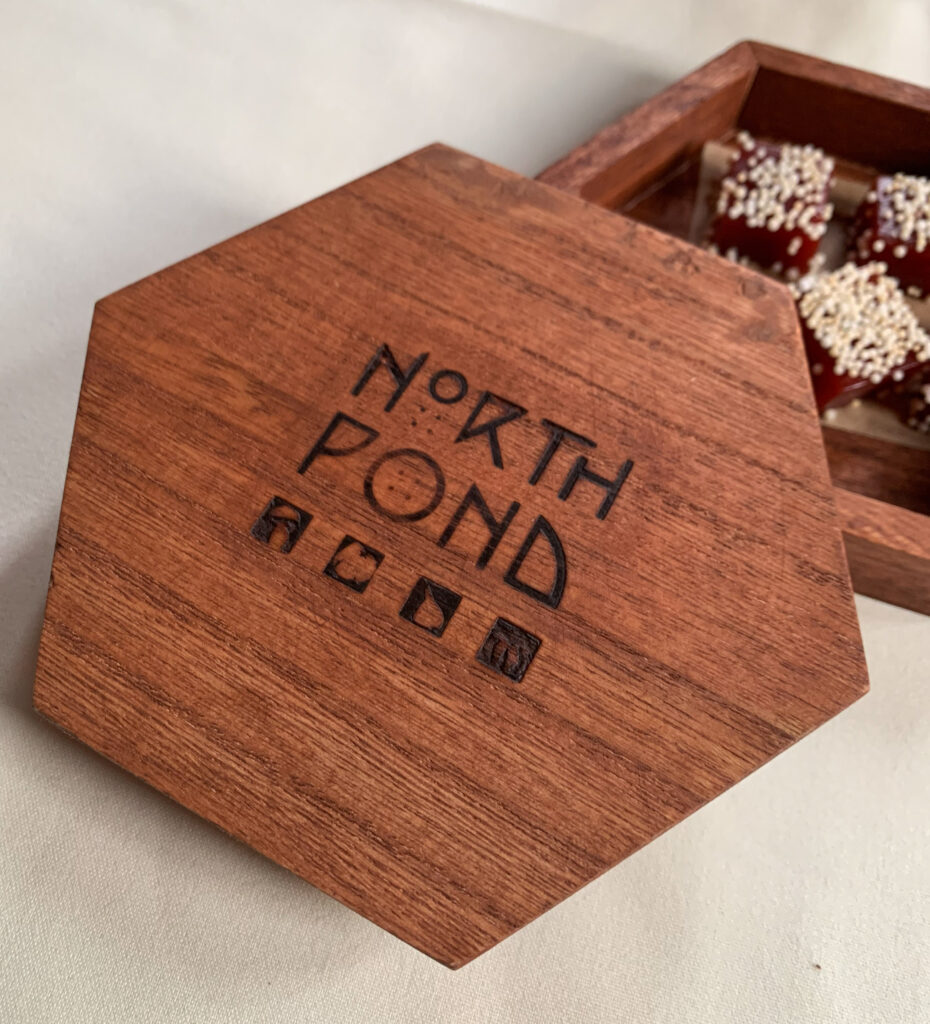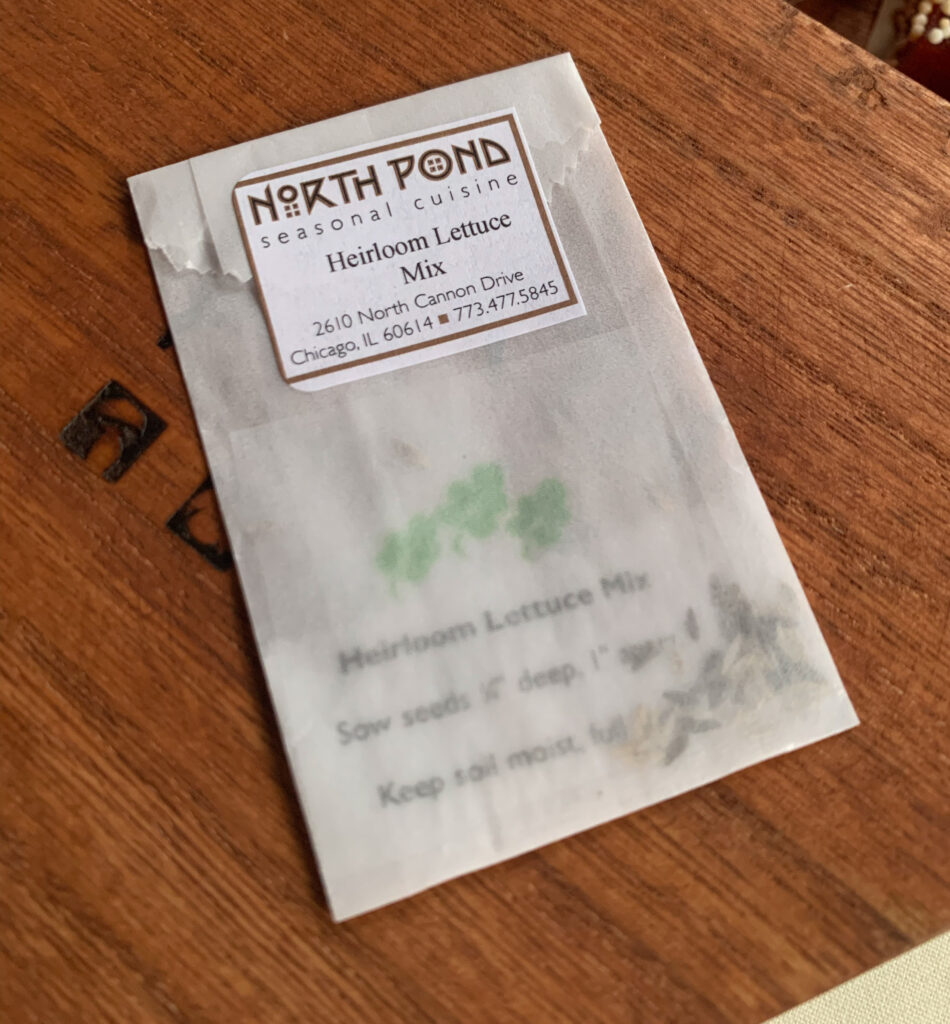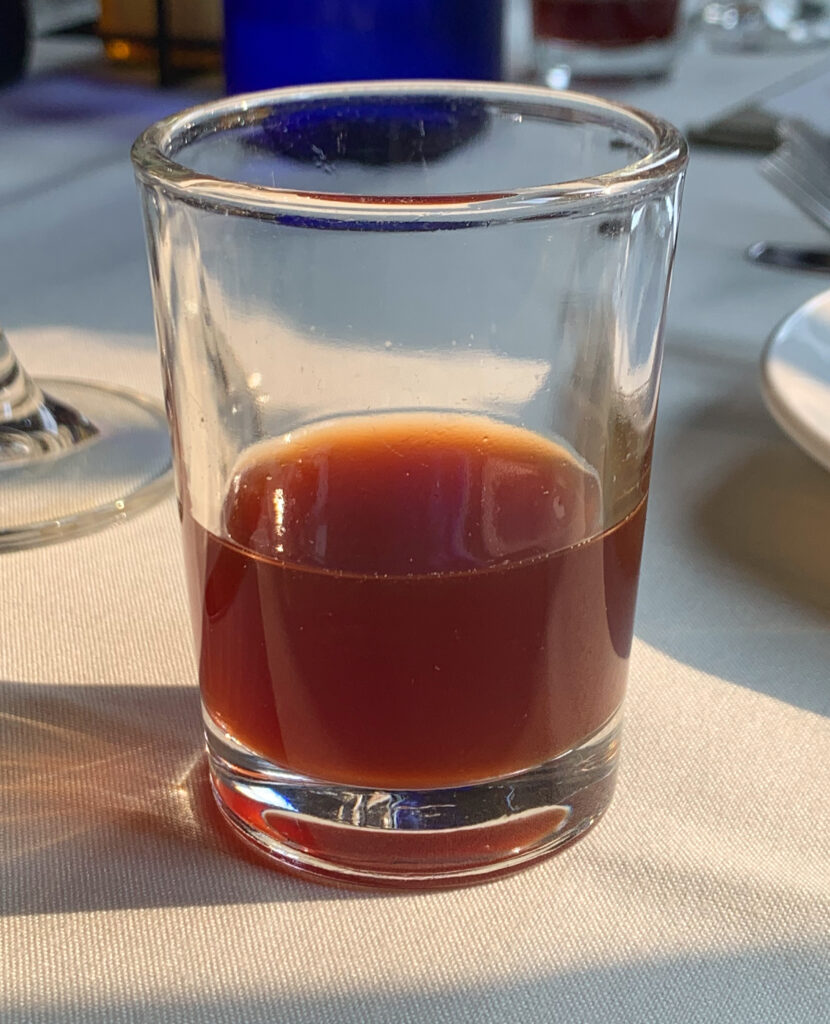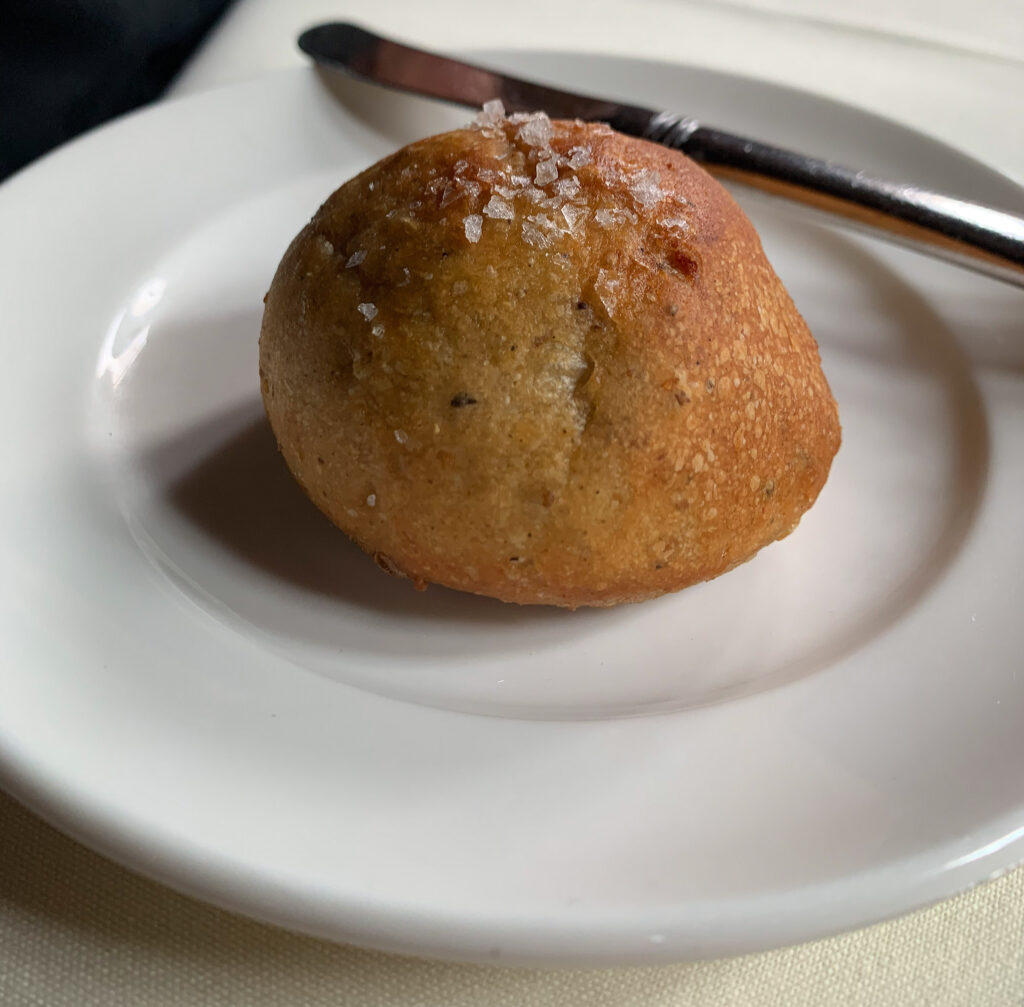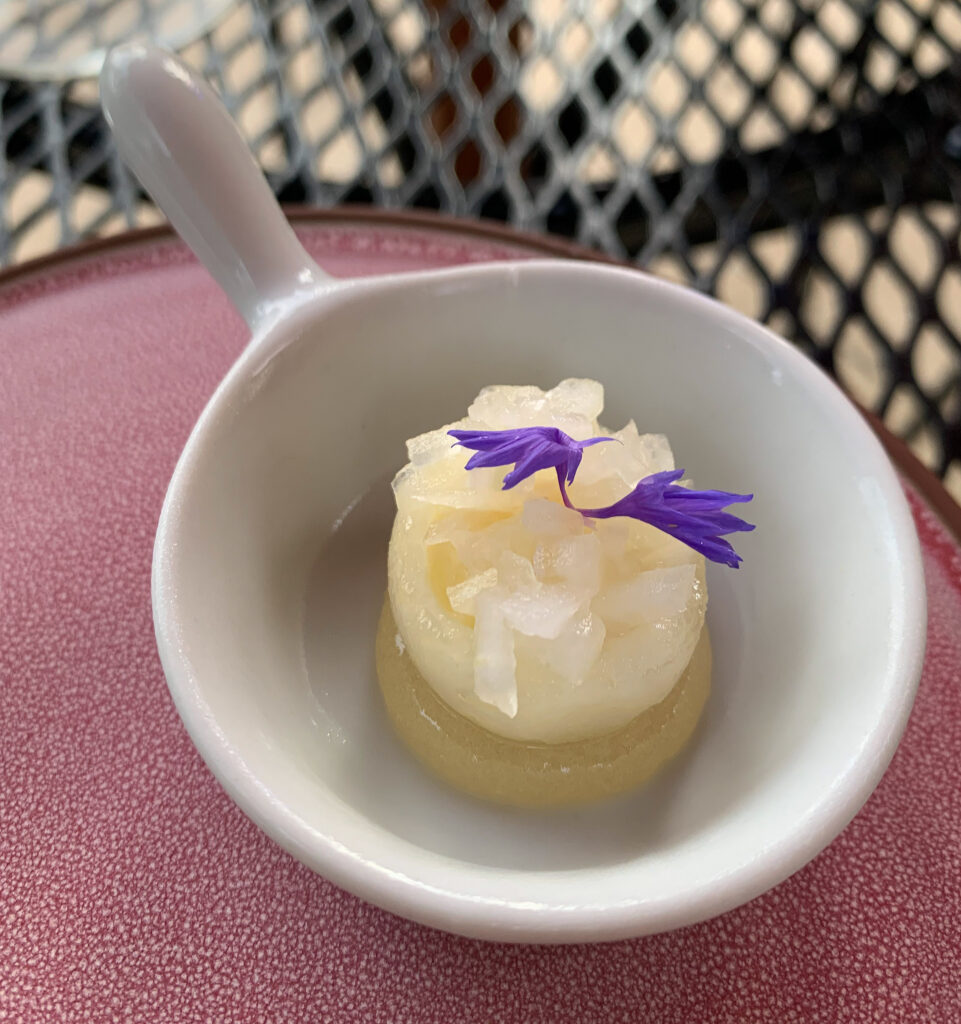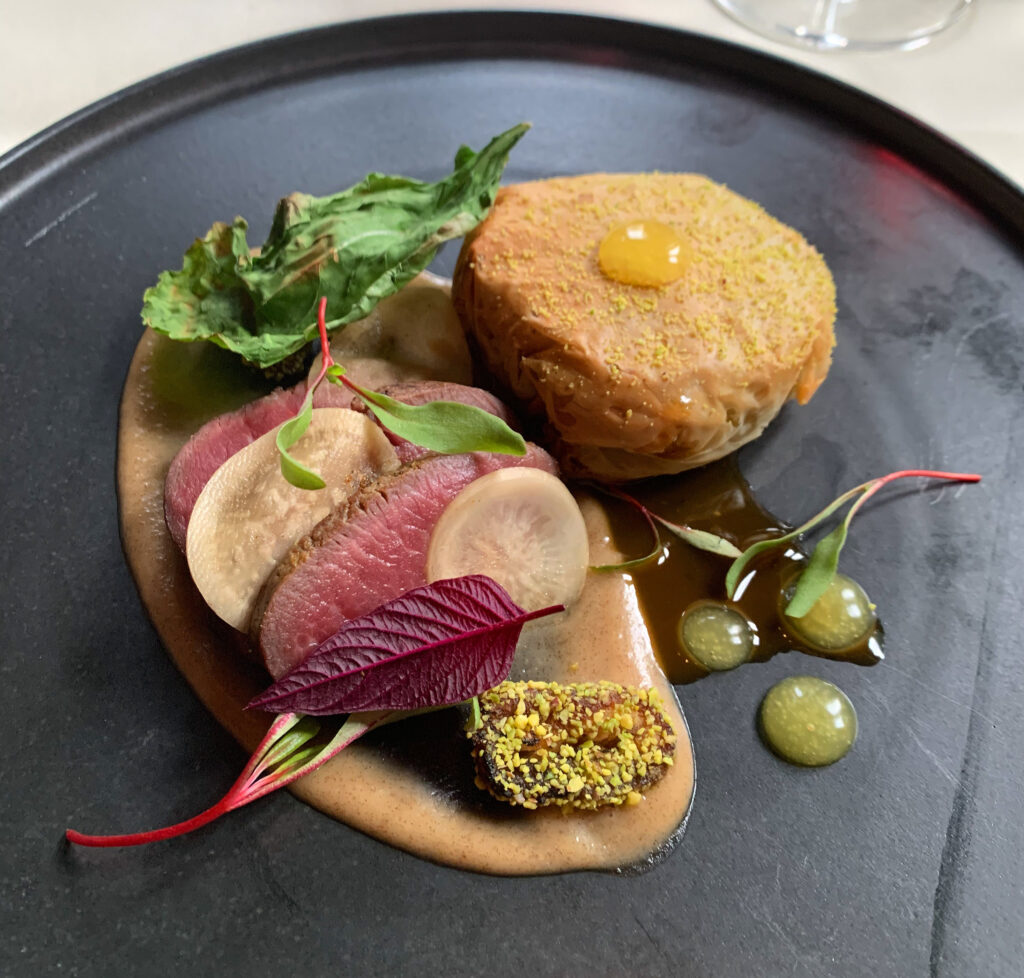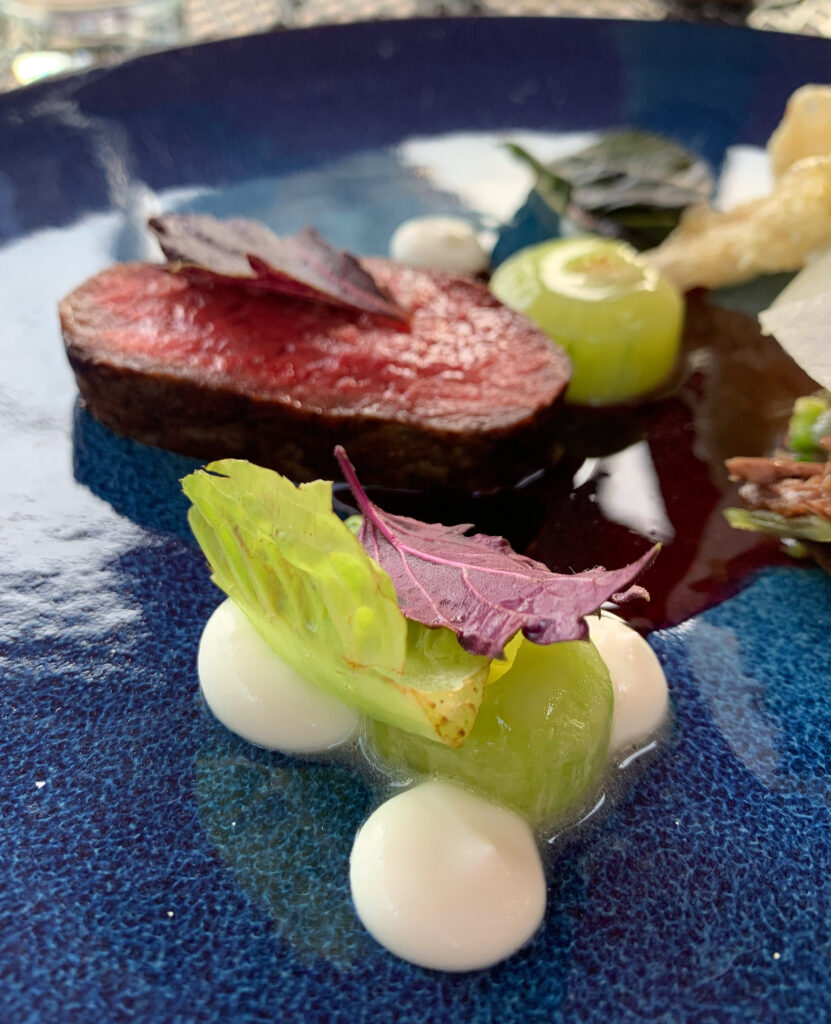Having just spent some time meditating on one of Chicago’s most notable, longstanding fine dining institutions, it feels natural to maintain the same focus and take aim at another member of the old guard. This does not only allow for a richer level of analysis—comparing and contrasting how another establishment of a kindred age has traversed decades of operation—but serves a practical purpose.
Despite swelling interest in gastronomy from a range of demographics that were once spurned as customers, older restaurants—often through no fault of their own—tend to get lost in the shuffle. This holds especially true when offering prix-fixe or tasting menus at set prices that invite comparison to the year’s hottest openings. The young gun, with a carefully differentiated identity, innate social media mastery, and natural newsworthiness, easily captures the public’s imagination. Each young gun, successively, does so while the old guard, if they have any dignity, quietly ply their trade or, if they swallow their pride, writhe and thrash to remain relevant. Bibendum may help a bit should you be favored with his honors. But even a one-Michelin-star restaurant in Chicago has 17 competitors to contend with at its level. How does the quiet, unassuming stalwart hope to rival some shiny new thing?
Such a place can—and does—compete. Some are even totally rebirthed. Others, quite frankly, are nothing more than relics: steadily deteriorating until the goodwill they once won, as well as the era they represent, has altogether disappeared. Whatever the case, these longstanding restaurants deserve attention. Time has taught you that many will be gone before you know it. Their stories—largely predating social media and scattered, piecemeal, throughout the archives of dying print media—run the risk of being lost forever. Thus, by approaching these timeworn concepts with a fresh set of eyes, you may preserve some visceral sense of the dining experience for posterity. You may come to terms with what, today, feels outdated while reveling in what—decades later—remains essential. Good or bad, you can communicate some small sense of the establishment’s spirit and do justice to the countless souls that have given of themselves to make Chicagoans’ memories over the years. Plus, it simply feels rewarding to rediscover a place of permanence while wannabee critics rush to excrete their thousand-word trifles about the latest flash in the pan. Anyone familiar with the low caliber of “influencer” that infects Chicago must know that what is fashionable is so often diametrically opposed to what is good.
In North Pond, you find a place that stands totally apart from time yet, just the same, has stood firmly ahead of its time for most of its existence. This seeming contradiction, which closely mirrors changing conceptions of authenticity and quality in the world of wine, reflects the eternally cyclical nature of taste. It demonstrates that reflexively tailoring your vision in line with some focus-grouped appeal to the lowest common denominator (as so many so-called “luminaries” look to do) may get you ahead today, but doggedly pursuing a singular vision—holding true to aesthetic virtues that only you can see—transcends the notion of “trend” altogether. It puts you on a path toward a kind of mastery that may not be adequately appreciated in your lifetime but inspires something far greater. And that, truly, is the essence of craft: one that exposes the work of the majority of chefs and restaurateurs as hopelessly cynical and soulless.
Of course, the story of North Pond is principally one about a building, a chef, and an enduring legacy that has inspired a surprising second chapter. It deserves to be recounted before engaging with what the concept is today.
North Pond (the restaurant) is named for the North Pond Nature Sanctuary in which it lies, some “13 acres of native aquatic, wetland, and prairie habitat” on the site of a former “scrub oak sand dune” and, later, a dumping ground (known as “the 10-mile ditch”) in the late 19th century. This area, whose western boundary formed the original shoreline of Lake Michigan some 8,000 years ago, was developed into a park in 1881 and, since 1999, has been home to the Peggy Notebaert Nature Museum. Nonetheless, it is the pond itself—with its 10 acres of open water—that remains the star. It sustains 150 plant species (like “little bluestem, sky-blue aster, nodding wild onion, and butterfly weed”) along with more than 220 bird species (warblers, ducks, herons, owls) and “numerous small mammals, reptiles, insects, and amphibians.” It has also, since 1912, featured a small building along its northern bank.
That structure originally served as “a warming shelter for ice skaters” enjoying the pond during winter. Then it became “a storage shed, a homeless shelter, a natural foods store, and a hot dog stand” over the years. By the 1990s, “a tree had taken root through the [building’s] boiler,” but Richard Mott saw untapped potential.
He was studying finance at the University of Chicago’s Graduate School of Business when, in 1981, he began running a student coffee shop as part of a class project. Mott “came to enjoy the independence” of “not having anyone tell you what to do” and turned down a job in investment banking upon graduation. He had already opened “another concession on campus” and, by 1997, he was “grossing millions annually and employing several hundred people” through his company University Foods. Nearly all of Mott’s concepts were not-for-profits at places like the University of Chicago, Northwestern University, John Marshall Law School, and the Illinois Institute of Technology, and, understandably, they “didn’t generate a lot of income in the summer.” Thus, he “started selling hot dogs and such in the parks” and developed a “good working relationship with the Park District.”

Describing himself as “a hearty eater but not a foodie” (is there any better combination?), Mott sought to try his hand at more involved expressions of dining. He identified “two old structures,” a “former skaters’ shelter on the northern edge of the fish pond in Lincoln Park” and a “former coast guard house by the lake in Jackson Park” and received permission from the city to develop them in 1996.
The latter property would come first. Mott believed the Jackson Park guardhouse was “built in the early 1900s” and “saw its heyday” in the 1930s. Since “another restaurant had been in there,” he simply “upgraded the kitchen, repainted the place, put in a patio overlooking the harbor.” The idea was to make “boaters who dock in the harbor…feel welcome,” and the corresponding concept would be a “fun, casual restaurant that serves a lot of seafood.” Jackson Harbor Grill opened in May of 1997 and was an “immediate hit” with its “Cajun inspired” menu of items like “spicy barbecue and grilled catfish.” A “third” of the customers would arrive by boat, making for a feeling that “you’re right in South Haven, Michigan, and not next to a busy beach.” Zagat’s 1999 Chicago Restaurant Survey would term it a “superb setting” for “romantic waterfront dining.”

The “former skaters’ shelter,” by comparison, would take a bit more work to come to fruition. The location, though “still dangerous at night,” reminded Mott of Central Park’s Tavern on the Green, and he even “half-jokingly” suggested the name “Tavern on the Pond” to the Park District. They rebuffed the idea (with zoning restrictions necessitating that all alcohol be served indoors), and somehow the name North Pond Café was decided upon. More important than what the restaurant would be called, the structure clearly needed some work. Mott brought in architect Nancy Warren (whose credits include Frontera Grill and Trio), and she “reimagined” the single-story brick building as a “sturdy Arts and Crafts lodge” with an open kitchen, murals depicting swans, and hand-painted “Arts and Crafts-style mottoes” painted “all around.”
To design North Pond Café’s menu in line with what he described as a “wine, white tablecloth, sit-down diner,” Mott hired Mary Ellen Diaz. The chef had graduated Le Cordon Bleu in Paris and later trained at l’École des Arts Culinaires in Lyon before working at The Inn at Little Washington and both the Ritz-Carlton and Michael Foley’s Printer’s Row in Chicago. She brought a love of “shopping for meat and vegetables every day at farmers’ markets” back from France and made “fresh, organically grown ingredients” and “the idea of a sustainable nature” part of her “culinary philosophy.”
North Pond Café would open in 1998, and Diaz would use “products from nearby farms” to create “a showcase for sophisticated Midwestern cuisine.” This included “crusty bread and honey-mustard-lavender butter dabbed with arugula pesto,” “River Valley mushroom soup” (with carrots, burdock, and scallop), “red-wine risotto” (with greens and mussels), “house-cured salmon” (with miner’s lettuce, fingerling potato, and two types of caviar), pizzas with “ultrathin crusts and offbeat toppings” (like grilled squid, spicy orange-tomato jam, and arugula or wild mushrooms, asiago, and Swiss chard), “house-made pasta” (with andouille sausage, scallops, fresh peas, beets, and a rich cream sauce), “roasted organic chicken” (with sour cream mashed potatoes, sprouted beans, and juniper berry-mustard sauce), and specials like a “venison burger on bread from the Red Hen Bakery in Wicker Park/Bucktown.” Desserts, meanwhile, included a “feather-light lemon custard souffle pie” and a “chocolate-candied orange tartlet.”
(Regrettably, one “food critic” would entirely gloss over Diaz’s time cooking seasonal Midwestern fare at North Pond when writing about the restaurant in 2014. They incorrectly labelled the menu as “serving low-country cuisine such as rabbit and grits” in seeming confusion with what was being done at Jackson Harbor Grill.)
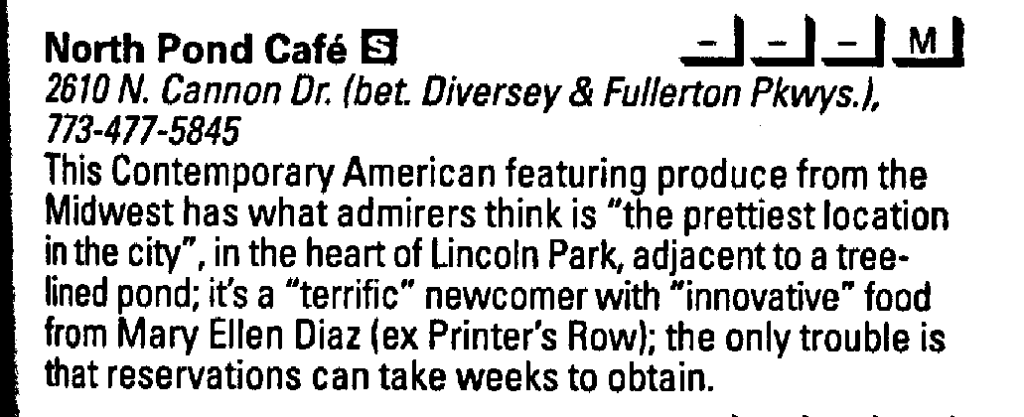
Zagat’s 1999 Chicago Restaurant Survey would praise North Pond Café as a “terrific newcomer” with “innovative food” and “the prettiest location in the city,” noting that the “only trouble is that reservations can take weeks to obtain.” Mott, likewise, was so impressed by Diaz’s “penchant for imaginatively eclectic dishes” that he invited her to “revamp the fare” at Jackson Harbor Grill. She would do so using “the flavors of Latin America as her model” but departed from both concepts soon after.
While one source claims Diaz was “burning out” at North Pond Café, the chef stated in an interview that, after her partner had a baby, she felt she “should be home at nights.” Lettuce Entertain You offered her a more conventional nine-to-five job as a corporate chef, which she took. Later on, when Diaz and her partner adopted a second child (“such a miracle and an amazing gift”), she began volunteering at soup kitchens in order “to give back.” The chef was on leave from LEYE at the time and was so struck by the experience that she, using all she had learned in kitchens over the course of her career, made it her purpose. In 2004, Diaz founded First Slice, an outreach-based meal subscription service and series of not-for-profit cafés (utilizing locally-sourced ingredients) whose proceeds are used to provide some “750 meals a week” to those “who struggle with hunger and homelessness.” She continues to operate the organization to this day.
Back at North Pond Café, change was afoot. The restaurant placed a “blind ad” in the Tribune and wound up hiring Bruce Sherman—a name that would become synonymous with the concept—in the fall of 1999.
The son of a banker, Sherman was born and raised in Chicago. Being “groomed to be a doctor or a lawyer,” he majored in economics at the University of Pennsylvania. However, while “studying abroad at the London School of Economics and experiencing all that is European,” Sherman came to a “life-altering realization.” He was not, despite his upbringing, fated to take an office job but “could choose any career he pleased.” He had “always enjoyed watching his Mom cook” and comfortably experiment with “new flavors and cuisines.” What he really craved was a career in restaurants.
Upon graduating, Sherman moved to Boston and started in restaurant management. In that role, he found himself “unable to satisfy his creative urge” and moved to the back of house, “working as a cook and absorbing all facets of kitchen life.” From there, he moved to Washington, D.C. and “ran a successful catering business” until selling it in 1993. Sherman also met his wife there, whom he followed to India after she was offered a work opportunity there. Over four years in New Delhi, he “immersed himself in…the local cuisine” by making “daily trips to the corner vegetable wallah” and cooking “only with what was available each day, what was fresh and seasonal.” He also “consulted for regional palace hotels, teaching local Rajasthani cooks to prepare Western food for the visiting tourists” and pursued “personal studies” in the “indigenous spices and cookery” of the Keralan Malabar Coast. This all “profoundly influenced his cooking.”
Following those four years in New Delhi, Sherman made his way to Paris and enrolled in a yearlong comprehensive program at the “prestigious” École Superieure de Cuisine Francaise in order to “solidify his culinary knowledge.” By “supplementing his studies with jobs at a number of highly regarded restaurants” (like Éric Frechon) and refining his “already-advanced culinary skills,” the chef developed a personal style “clearly grounded in French technique” yet “clearly corresponding to the season.” That, at last, led him back to Chicago, where he worked for David Burke’s Park Avenue Cafe and, later, under Sarah Stegner the Ritz-Carlton (just as Diaz did).
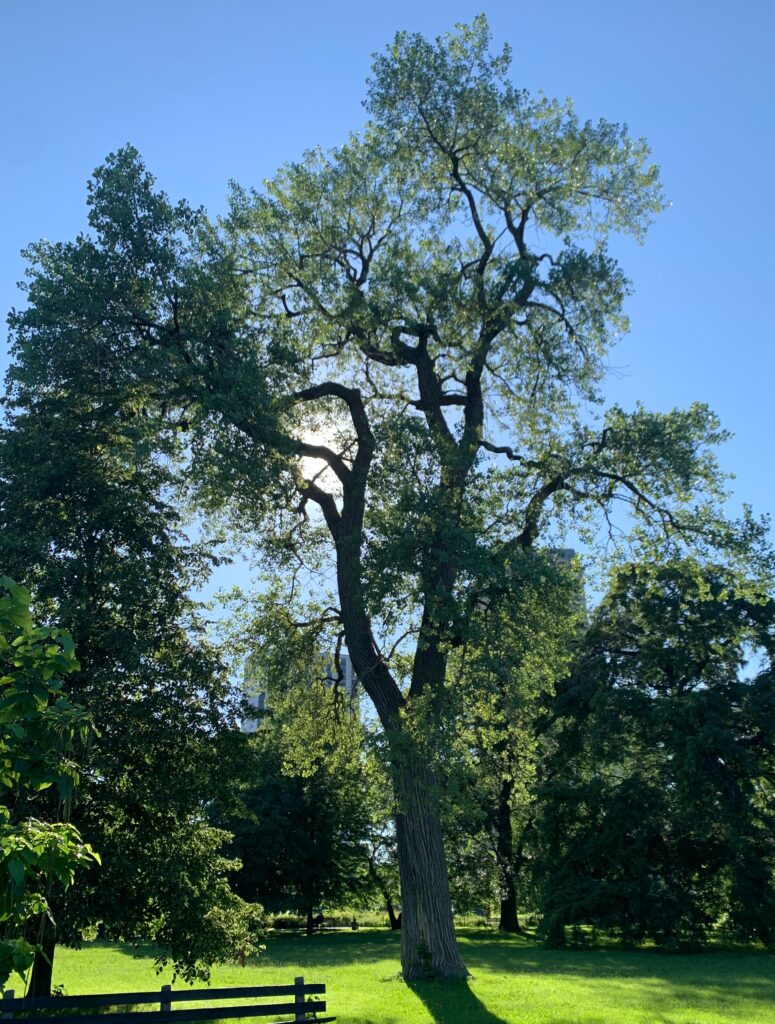
Sherman had “just bought his first house and quit his job as a chef at the Ritz-Carlton” when he responded to that “blind ad” in the Tribune. Upon taking the position at North Pond Café (and despite the foundation Diaz had laid), cooking “seasonally and locally in 1999” was still “rare.” However, his effect on the restaurant was immediate and decisive.
In 2000, along with Mott, Sherman would develop a “yearlong Artisan Series at North Pond Café” with the intention of teaching diners that “farming in the Midwest goes on longer than people imagine.” The “once-a-month, fixed-price” menus “concentrated on introducing a wider variety of crops and farmers” like sheep’s cheese from Minnesota’s Love Tree Farms, eggs (“within 24 hours of coming out of the hen”) from Michigan’s Swan Creek Organics, Bavarian red lettuce from Northwest Illinois’s Kinnikinnick Farm, and even beer from Indiana’s Three Floyds Brewing. The first three dinners in the series (price from $50-$75 per person) completely sold out, even attracting “other local chefs.” They even led to a “surge in business” for Kinnikinnick Farm’s chives among “both individual cooks and professional chefs,” leading them to double their plantings of what had become “a new cash crop.”
Still, Sherman would admit many years later that certain “nobler notions”—along with any question of shaping a “personal cooking style”—had to take a backseat at first. Instead, rather simply, he “had to concentrate on keeping an aging building upright, an inherited staff cohesive, and an existing clientele happy with the new chef and his menu.” Eventually, Sherman “got the mechanics of being a chef down,” but it still “wasn’t all smooth sailing.” A “seemingly endless string of the strangest events,” like “power outages in the midst of dinner service,” “servers disparaging the food to guests,” and “constant mechanical and structural breakdowns,” convinced him that North Pond “had been constructed over a Native American burial ground.” He was so convinced that he “actually brought a shaman to the restaurant to placate the spirits…[that] lurked beneath it.”
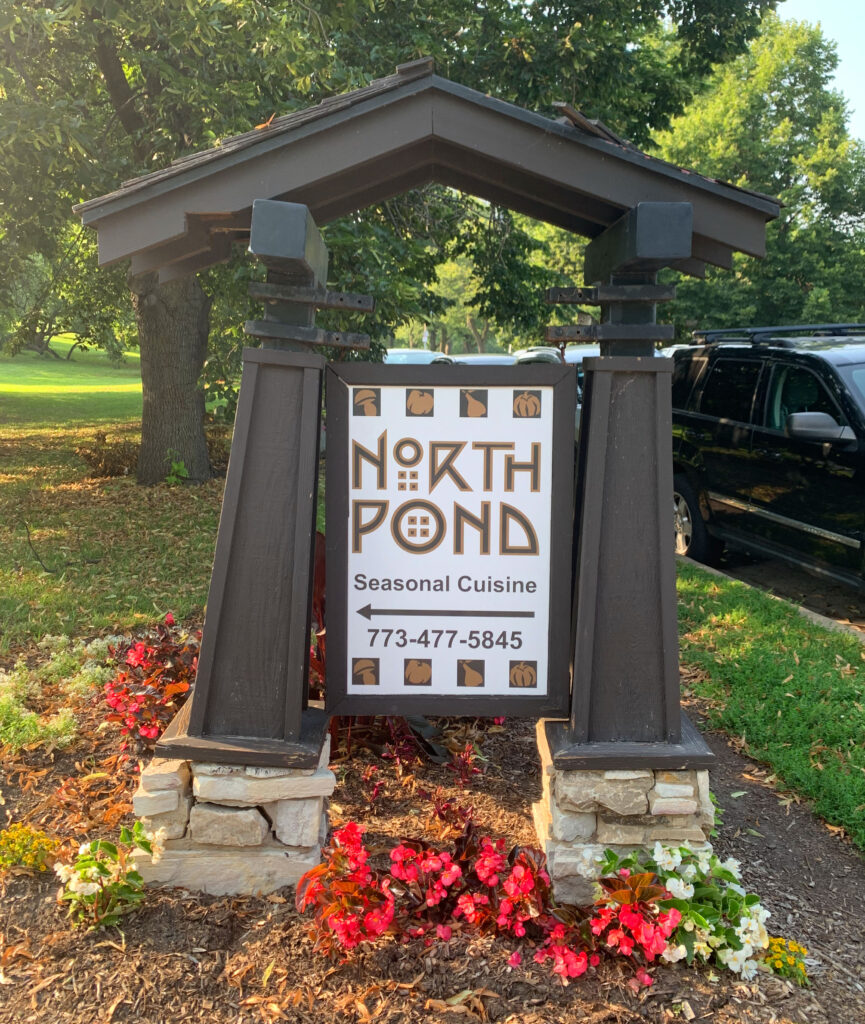
Things “eventually did get better” with both the staff and the customers, who “invested ever greater trust in the kitchen.” By 2002, Sherman had become a partner in the restaurant and oversaw a renovation (also by Nancy Warren) that extended the “Arts and Crafts motif” by enclosing a “section of weather-dependent outdoor seating” and creating “a cozy dining room with a stone hearth in one corner and French doors all around.” A “small sitdown bar” was also added near the entrance while a new concrete patio extended “to the water’s edge.” At this point, North Pond Café would also change its name—simply—to North Pond.
Sherman was walking the walk when it came to local sourcing, being “frequently spotted at Chicago’s Green City Market, physically loading a truck with fresh produce destined for North Pond’s kitchen.” But his stewardship went further than that. Back then, he already composted and recycled “90 percent of the restaurant’s trash” while also tacking “a dollar charge onto each bottle of wine” sold that would be matched by the restaurant and donated to “food-related nonprofit organizations.”
In 2003, Sherman was named one of Food & Wine’s “Best New Chefs in America.” He admitted that he cooks “whatever he damn well pleases” but drew praise, more specifically, for “modern American cuisine with French inflections” like “sage-roasted pheasant breast with wild rice, sunchokes and foie gras jus” and “grilled scallops with orange-braised endive and a parsnip-onion quenelle in a lemongrass-crustacean emulsion.”
Over a 20-year period, Sherman and North Pond would go on to receive a litany of other national awards. Most notably, the former would be nominated for the James Beard Foundation’s “Best Chef: Great Lakes” award in 2007, 2008, 2009, 2010, and 2011 before winning it in 2012. The restaurant, likewise, would be named a semifinalist for “Outstanding Service” in 2015 and 2017 as well as a semifinalist for “Outstanding Restaurant” in 2018 and 2019. Despite this, it would take four editions of Michelin’s Chicago Guide before North Pond was awarded a star. Sherman “expected to win” in 2010 and had “given up” on the rating after two more snubs, but Bibendum relented after acknowledging “it was clear” the chef “was evolving, working hard and not standing still.”
During Sherman’s time there, North Pond could claim Danny Grant—who spent five years there and rose to the position of chef de cuisine before going on to win two Michelin stars of his own—as a notable alumnus. Greg Mosko, too, would be named one of Food & Wine’s “Best New Pastry Chefs” while working there in 2014 (later being replaced by Kevin McCormick, now of Good Ambler). And Tyler Gore would work as a line cook there before spending close to four years as executive sous chef of Smyth.
Thanks to internet archiving, it is possible to track the development of Sherman’s cuisine over the years. You think this might be worthwhile before turning toward what characterizes North Pond today. The following are representative dishes organized by year.
2002
- “Farm Egg” (Poached, Polenta with Black Trumpet Mushrooms, Chanterelle Turnover, Red Wine-Mushroom Essence)
- “Squash, Apple” (Velouté Soup with Red Kuri, Kabocha, Butternut and Jarrahdale Squash, Warm Goat Cheese and Caramelized Onion Strudel)
- “Pumpkin, Scallops” (Parmesan Gnocchi, Seared Nantucket Bay Scallops, Toasted Hazelnuts, Sage Brown Butter with Pears, Baby Arugula)
- “Spinach, Sweetbreads” (Warm Sheep’s Milk Ricotta Tart with Apples, Crispy Sweetbreads, Curly Endive with Bacon Lardons)
- “Fresh Prawns” (en Gelee, Aromatic Vegetable Brunoise, Lobster Butter Crouton)
- “Black Bass, Sea Urchin” (Poached in White Wine Nage with Fingerling Potatoes, Carrots, Turnips, Leeks, Fennel; Sea Urchin Emulsion)
- “Guinea Fowl, Black Truffles” (Pan-Browned with Sage, Squash and Uplands Cheese Gratin, Braised Chard, Seared Foie Gras, Natural Jus with Black Truffles)
- “Duck” (Seared Breast, Braised Leg and Yukon Potato Parmentier, Glazed Scarlet-Heart Turnips, Pineapple Quince Jus)
Served with wines from producers like Archery Summit, Cristom, Didier Dagueneau, Domaine Drouhin, Krug, Littorai, Peter Michael, Bruno Paillard, Pierre Peters, Prager, Louis Roederer, Selbach-Oster, Shafer, Stony Hill, and Zind-Humbrecht.
2003
- “Fresh Prawn” (In Galette, Aromatic Oil, Sweet Onion Cream, Beef Glace)
- “Soft Shell Crab” (Toasted Brioche “Sandwich”, Pancetta, Remoulade, Caper Butter)
- “Green and Gold Zucchini” (Warm Pastry Tart, Goat Cheese and Caramelized Onion, Black Olive Emulsion, Basil Oil)
- “Quail, Peas” (Grilled Whole, Citrus Cous Cous with Mint, Warm Baby Spinach-Bacon Salad, Pea Emulsion)
- “Goose” (Pan-Browned “Cake”, Glazed Chestnuts, Leek Fondu, Apple and Cranberry Coulis)
- “Crab, Oysters” (Stone Crab, Lake Bras d’Or Oysters, Citrus Zest, Anise-Fennel Mousse, Belgian Endive)
- “Summer Vegetables” (Rainbow Chard-Stuffed Crèpe, Braised Fennel, Glazed Torpedo Onion, Basil Flan, Roasted Tomato Wine Butter)
- “Lobster” (Citrus-Poached, Crab Cake, Warm Scallop and Shrimp Mousse, Sunburst Squash and Baby Zucchini, Spiced Lobster Sauce)
- “Squab” (Sweet Cream Broiled, Red Cabbage with Walnut and Apples, Celeriac Puree, Winter Plum Jus)
- “Quail” (Maple Sausage Stuffed, Sautéed Spinach, Chanterelles, Mushroom and Poultry Glace)
Served with wines from producers like Bergström, Chartogne-Taillet, J.L. Chave, Dalla Valle, Marcel Deiss, Génot-Boulanger, Harlan, Nicolas Joly, Moët & Chandon, Rudi Pichler, Ridge, Sine Qua Non, and Turley.
2004
- “Langoustine” (Poached Sweet Shrimp, Spinach, Crustacean Broth, Orange Sabayon Gratin)
- “Asparagus, Morel” (White Asparagus-Mushroom Cream Tart, Sautéed Morel Mushroom Caps, Herb Salad)
- “Pheasant” (Chilled Cognac Terrine, Fruit Compote, Red Wine Onions, Gingerbread Toast)
- “Duck Egg” (Poached, Glazed Green Asparagus, Warm Asparagus Sauce, Caviar Cream)
- “Crab, Artichokes” (Maine Crabmeat, Parmesan Cracker and Artichoke Mousse, Baby Artichokes and Savory Gelée)
- “Veal” (Naturally Raised, Osso Buco, Citrus Broth, Wild Ramp Fettucine, Young Vegetables)
- “Monkfish” (Browned, Sweet-Spiced Basmati Rice, Citrus Endive, Coconut Curry Cream)
- “Rabbit” (Arugula Rolled Boneless Saddle, Braised Leg, Grilled Parmesan Polenta, Carrots with Mint)
- “Guinea Fowl” (Thyme Basted Breast, Dark Meat “Sausage”, Peas & Bacon, Warm Dandelion Greens)
Served with wines from producers like Chimney Rock, Jean-Luc Colombo, Duckhorn, Frog’s Leap, Paul Hobbs, Laurent-Perrier, Martinelli, Philipponnat, Spring Mountain, Stolpman, and Georges Vernay.
2005
- “Foie Gras, Nectarines” (Almond Crusted Medallion, Glazed Purplette Onions, Apricot Star Anise “Jam”, Toasted Brioche)
- “Sweet Corn, Snapper” (Corn on the Cob Soup, Grilled Red Snapper, Arugula Chiffonade)
- “Farm Eggs, Eggplant” (Eggs En Cocotte, Eggplant Parmesan, Red Bell Pepper Coulis, Smoked Caviar Cream, Prosciutto)
- “Mushroom, Rosemary” (Chilled Paris Mushroom Soup, Croutons, Scape Essence, Rosemary)
- “Squash Blossoms, Beans” (Warm Tempura Beignets, Caper Shallot Tartare Sauce, Roast Red Pepper Aioli)
- “Heirloom Tomatoes” (Grilled Onion and Parmesan Bread Salad, Early Season Fieldgrown Tomatoes, Aged Balsamic, Extra Virgin Olive Oil)
- “Beets” (Leaf Enrobed Minted Chèvre; Chioggia, White, Gold, Forono and Red Beets, Hazelnut Vinaigrette)
- “Wild Salmon” (Dry Cured Sausage-Scaled Ivory Salmon Filet, Braised Lettuce, Pistachio Couscous, Oven Roasted Tomato Oil)
- “Wild Squab” (Boneless Breasts, Wine Braised Legs, Butternut Risotto, Braised Cabbage, Cranberries, Squab Reduction)
- “Aged Beef” (Seared Strip Steak, Gorgonzola Gratineed, Broccoli with Crispy Shallots, Tomato “Sauce,” Green Olive-Almond Jam)
Served with wines from producers like Bollinger, Joseph Drouhin, DuMOL, Flowers, Alain Graillot, Château Gruaud-Larose, Pierre Guillemot, Emmerich Knoll, Kracher, François Jobard, Reichsgraf von Kesselstatt, Mongeard-Mugneret, Radio-Coteau, Ramey, and Château Suduiraut.
2006
- “Avocado, Crab” (Chilled Avocado Velouté Soup, Dungeness Crab-Cucumber Tower, Toasted Almonds, Melon)
- “Mussels, Potatoes” (Citrus-Steamed Mussels, Potato-Leek “Risotto”, Tomato Crème Fraîche, Prosciutto Crisp)
- “Lentils, Bacon” (Smoked French Green Lentil Soup, Braised Brown Sugar-Cured Bacon, Celeriac, Brussels Sprouts)
- “Fennel, Carrot” (Fresh Fennel-Stuffed Tortelloni, Braised Fennel, Baby Carrots, Carrot-Parmesan Gratinée)
- “Tuna, Herb Salad” (Tuna Crudo Style, Coho Salmon Tartare; American Sturgeon Caviar, Caper Oil, Champagne Shallots, Herb Salad)
- “Sea Bass, Corn” (Grilled White Sea Bass Filet, Cornmeal Waffle, Lemon-French Bean Timbale, Sweet Corn Reduction)
- “Quail, Sweetbreads” (Pastry-Wrapped Quail, Thyme-Basted Veal Sweetbreads, Wild Mushrooms, Baby Red Beets)
- “Skate, Spot Prawns” (Pumpkin Mousseline-Stuffed Skate Paupiette, West Coast Spot Prawns, Beauty Heart Radishes, Licorice-Leek Sauce)
- “Pork, Cherries” (Grilled Honey-Glazed Chop, Suckling Pig Potato Cake, Italian Greens, Tart Cherry Reduction)
Served with wines from producers like Guy Amiot, Au Bon Climat, Bassermann-Jordan, Bastianich, Belle Glos, Faiveley, Henriot, Hirsch, Inniskillin, Jordan, Les Héritiers du Comte Lafon, Loimer, Mount Eden Vineyards, The Prisoner, Robert-Denogent, Ruinart, Tempier, and Thiénot.
2007
- “Sweetbreads, Sweet Onions” (Bay-Basted Pastured Sweetbreads, Creamy Polenta, Sweet Onion and Bell Pepper Coulis)
- “Cornish Hen, Potato” (Cornish Hen, Potato Grilled Baby Cornish Hen, Red Wine Sausage Patty, Potato Waffle, Black Pepper Baby Romaine, Maple)
- “Apple, Bacon” (Warm Apple-Leek Soup, Frisee-Almond Timbale, House-Cured Brown Sugar Bacon Lardons)
- “Calamari, Sweet Potato” (Griddled Calamari, Bacon-Smoked Sweet Potato Tartelette, Rosemary, Pear Reduction, Mizuna, Peanuts)
- “Goose, Quince” (Caramelized Winterfruit Goosecake, Glazed Chestnuts, Quince Purée, Quail Egg)
- “Game, Plum” (Cocoa Game Mousse Tartine, Plum Compote, Red Onion Jam, Radicchio-Carrot Slaw, Fruit and Nut Crouton)
- “Baby Romaine, Carrots” (Baby Red Oak & Freckles Romaine, Red Radicchio, Baby Carrot, Icicle Radish, Carrot Vinaigrette, Cheese Puff, Pine Nuts)
- “Crab, Uni” (Crabmeat and Honey Gelée, East Coast Sea Urchin, American Sturgeon Caviar Cream)
- “Turbot, Merlot” (Wine-Poached Turbot on-the-Bone, Cipollini Onions, Roasted Yukon Potato Purée, Pleurottes, Rapini, Chocolate Matelote)
Served with wines from producers like Paul Bara, Albert Bichot, Billetcart-Salmon, Philippe Colin, Dauvissat, Duval-Leroy, Merry Edwards, The Eyrie Vineyards, Failla, William Fevre, Domaine Huet, Hubert Lamy, Louis Latour, Joh. Jos. Prüm, and A. et P. de Villaine.
2008
- “Frog Legs, Asparagus” (Hazelnut-Crusted Frog Legs, Grilled Asparagus, Artisanal Farro, Carrot-Ginger Syrup)
- “Ramps, Crab” (Warm Ramp Veloute Soup, Browned Maine Crab Cake, Pickled Watermelon Radish)
- “Chestnut, Truffles” (Chestnut Creme Coupelle Soupe, Shaved Black Truffle Crouton, Cinnamon Cream)
- “Ricotta, Truffles” (Fresh Pumpkin Tagliatelle Noodles, Sheep’s Milk Ricotta, Oregon Black Truffles, Herbs)
- “Razor Clam, Scallop” (Seafood Chowder a la Plancha: Razor Clams, Sea Scallop, Bacon, Potato; Meyer Lemon Cream, Sylvetta Arugula)
- “Crudo, Beets” (Scallop Crudo, Gold and Red Beet Confetti, Apple, Mango, Mineolas, Grapefruit, Mizuna)
- “Charcuterie, Fruit” (Sliced Acorn Edition Coppa, Lonza, Lardo; House-Made Finocchiona, Rabbit Mousse; Shallot-Raisin Compote, Croutons, Frisée)
- “Lobster, Chicken” (Butter-Poached Half Lobster, Rosemary-Basted Chicken Breast, Winter Vegetable Fricassee, Bacon Emulsion)
- “Pastured Veal, Pasta” (Veal Tenderloin, Breast, Sweetbreads; Lemon-Parmesan Tagliatelle, Pleurotte Mushrooms, English Peas, Sherry Caramel)
- “Pork, Squash” (Grilled Acorn-Finished Berkshire Pork Chop, Braised Pork Belly, Cinnamon Butternut Squash, Golden Raisins, Parsley-Bulghur)
Served with wines from producers like Domaine des Baumard, Bouchard, Calera, Gosset, Château Grand-Puy-Lacoste, Charles Heidsieck, Chateau Montelena, Domaine Morey-Coffinet, Newton, Domaine Roulot, and Domaine du Vieux Télégraphe.
2010
- “Prawn, Eggplant” (Sweet Side-Striped Prawns a la Plancha, Eggplant-Raisin Agnolotti, Mint Yogurt Sauce, Tendrils, Almonds)
- “Chicken, Egg” (Crusted Soft-Boiled Farm Egg, Chicken-Chanterelle-Pearl Onion Fricassée, Veal Sweetbreads, Tarragon)
- “Whitefish, Sunchoke” (Browned Lake Huron Whitefish, Roasted Sunchokes, Riesling Savoy Cabbage, D’Anjou Pears, Smoked Cream Chowder)
- “Beets, Trout” (Candied Chioggia and White Beets, Smoked Trout Mousse, Hazelnut Macaron, Red Beet Sorbet, Beet Greens)
- “Heart of Palm, Melon” (Yellowfin Tuna and Ono Crudo and Tartare, Avocado, Canteloupe Sorbet, Fresh Heart of Palm, Sesame Tuile)
- “King Crab, Caviar” (Alaskan King Crab, Smoked Caviar, Beauty Heart Radish, Green Apple Sorbet, Celery-Apple Salad, Melba Toast)
- “Sablefish, Shell Beans” (Grilled Alaskan Black Cod Filet, Shell Bean-Pipérade Cassoulet, Merguez Sausage, Duck, Bacon, Arugula)
- “Bass, Wild Rice” (Sautéed Wild Striped Bass, Wisconsin Wild Rice, Side-Striped Prawns, Broccoli, White Wine Pumpkin Cream, Pecans)
Served with wines from producers like Ayala, Bruno Clair, Egly-Ouriet, R. López de Heredia, Domaine Ostertag, Château Pajzos, Peay, Pingus, Domaine Vacheron, and Verget.
2011
- “Pork, Rhubarb” (Slow-Roasted Pork Belly, Spiced Sweet Shrimp a la Plancha, Candied Rhubarb, Spring Onion, Mizuna)
- “Egg, Mushrooms” (Sunnyside Cooked Farm Egg, Chanterelle and Trumpet Royale Mushroom Ragoût, English Muffin, Cognac-Peppercorn Sauce)
- “Beets, Octopus” (Candied Gold and Chioggia Beets, Red Purée; Charred, Marinated Octopus; Pignolis, Cumin Yogurt, Black Olive, Mizuna)
- “Trout, Halibut” (Smoked Rainbow Trout, Fennel-Muscovado Sugar Cured Halibut, Sheep Milk Ricotta, Kumquats, Caper Berries, Pretzel Roll)
- “Spinach, Apricot” (Spinach-Sheeps Milk Ricotta Pithiviers, Pignolis, Wild Mushroom Ragoût, Apricot Jam, Toasted Walnut-Parmesan Cream)
- “Squash, Cranberry” (Roasted Kabocha Squash Agnolotti, Cranberry-Ginger Puree, Caramelized Rutabaga, Cipollinis, Broccoli, Glazed Chestnuts)
- “Snapper, Mango” (Gingered Gulf Snapper a la Plancha, Coconut Rice, Green Beans, Charred Ailsa Craig Onion, Mangoes, Peanuts)
- “Duck, Citrus” (Pan-Roasted Duck Breast, Boneless Thigh Confit; Potato-Black Olive Napoleon, Mandarin Purée, Piquillo Pepper Chermoula)
Served with wines from producers like Philippe Bornard, Giacomo Conterno, Corison, Vincent Dureuil-Janthial, Evening Land, Domaine Gros Frère et Soeur, Château d’Issan, Jacquesson, Marie-Courtin, E. Pira & Figli, Jacques Puffeney, La Spinetta, and Jean Vesselle.
2012
- “Foie Gras, Pineapple” (Seared Duck Foie Gras, Caribbean Roasted Gold Pineapple, Banana-Peanut Purée, Rum Baba, Banana Chips)
- “Crab, Mango” (Sautéed Early Soft Shell Crab, Griddled Gulf Shrimp, Mango-Coconut Compote, Spiced Cashew Butter, Mizuna)
- “Squid, Watermelon” (Squid a la Plancha, Sake-Marinated Red and Yellow Watermelon, Black Vinaigrette, Shiso, Sesame, Lime Yogurt)
- “Kampachi, Heart of Palm” (Citrus Kampachi Crudo, Blood Oranges, Satsuma Mandarin, Marinated Heart of Palm, Mint Sorbet, Horseradish)
- “Dungeness Crab, Cucumber” (Dungeness Crab Salad, Citrus Avocado Mousse, Cucumber Broth, Mint, Charentais Melon, Icicle Radishes, Fennel Flatbread)
- “Swordfish, Eggplant” (Grilled Atlantic Line-Caught Filet, Smoked Italian Eggplant, Grilled Little Gem Lettuce, Oil-Poached Tomato, Olives, Capers)
- “Rabbit, Mint” (Boneless Rabbit Saddle Medallions, Minted Fettuccine Pasta, Braised Leg Meat, Spring Vegetable Mélange, Spätlese Broth)
- “Grassfed Beef, Garlic” (Charred New York Striploin Medallions, Piccolo Farro, Parmesan Cavolo Nero, Garlic Cream, Italian Parsley, Nuts)
Served with wines from producers like M. Chapoutier, Marchesi di Gresy, Lilbert-Fils, Lignier-Michelot, Giuseppe Mascarello, Scholium Project, and Domaine Serene.
2013
- “Bay Scallop, Leek” (Caramelized Nantucket Bay Scallops, Leeks Fondus, Vanilla Pear Butter, Asian Pears, Parmesan Shortbread, Gastrique)
- “Clam, Rapini” (“Drunken” Red Wine Capellini, Razor Clams, Guanciale Bacon, Broccoli Raab, Garlic, Cerignola Olives, Herbed Crumbs)
- “Mozzarella, Artichoke” (Fresh Mozzarella, Oven Roasted Tomato, Marinated Baby Artichokes, Baby Arugula, Toasted Focaccia, Balsamic)
- “Tuna, Bean” (Potato-Crowned Albacore Tuna, French Beans, Egg, Sweet Cherries, Cherry Tomato, Artisan Lettuce, Black Olives, Anchovy)
- “Scallop, Squash” (Chilled Poached Sea Scallop, Butternut Squash-Apple Terrine, Shaved Apple, Chive, Finger Lime, Mizuna)
- “Pork, Corn” (Grilled Tenderloin, Almond-Braised Belly, Andouille Sausage; Cornbread Pudding, Sweet Corn Salad, Green Beans, Adobo Jus)
- “Wood Pigeon, Mushroom” (Browned Wild Scottish Wood Pigeon, Chanterelle Mushroom Ragoût, Maple Bacon, Parsnip Rösti Cake, Pomegranate Lacquer)
- “Lamb, Cranberrry” (Lamb Trio: Grilled, Braised and Crusted; Pie-Spiced Kobocha Squash, Smoked Onion, Grilled Broccolini, Cranberries)
Served with wines from producers like Franck Balthazar, Canard-Duchêne, Domenico Clerico, Dönnhoff, Jarvis, Benjamin Leroux, Benedicte & Stephane Tissot, and Elena Walch.
2014
- “Squid, Squash” (Butternut Squash Squid Ink Cannelloni, Charred Squid, Chorizo, Meyer Lemon, Green Olive, Pepita Brittle)
- “Shrimp, Pineapple” (Chilled Side-Striped Shrimp, Jerk Spice-Cured Mahi-Mahi, Pineapple Rum Preserve, Jalapeno Emulsion, Arugula, Radish)
- “Beet, Pastrami” (Candied Red, Gold, and Chiogga Beets; Smoked Pastrami, Sour Cream Panna Cotta, Rye Crumble, Quail Egg, Beet Greens)
- “Bison, Grape” (Bison Loin Carpaccio, Blue Cheese Mousse, Concord and Jupiter Grapes, Celery, Nougatine, Jerky Crumble, Grilled Bread)
- “Pheasant, Rye” (Wild Pheasant Breast, Thigh Bratwurst; Caraway Spaetzle Noodles, Apple-Cabbage Slaw, Sprouts, Grain Mustard, Scrumpy)
- “Turbot, Wild Rice” (Steamed Spanish Turbot, Shrimp Mousseline, True Wild Rice, Salt-Roasted Beets, Fennel Jam, Orange, Smoked Caviar)
- “Skate, Crab” (Peekytoe Crab-Crusted Maine Skatewing, Nantucket Bay Scallop, Bosc Pear, Watermelon Radish, Turnip, Crab-Saffron Broth)
- “Grassfed Beef, Mushroom” (New York Striploin Steak Medallions, Veal Cheek; Beech Mushrooms, Confit Potatoes, Mushroom “Pudding”, Marrow, Pistachios)
Served with wines from producers like ARPEPE, Jean-Marc Brocard, Bründlmayer, Chappellet, Schloss Gobelsburg, Johannishof, Matthiasson, FX Pichler, Pol Roger, Raventós, Nicolas Rossignol, and Veyder-Malberg.
2015
- “Foie Gras, Rosemary” (Seared Foie Gras, Cider Doughnuts, Green Apple-Mustard Seed Preserves, Delicata Squash, Rosemary, Ginger)
- “Cod, Mustard” (Browned Gooseberry Cove Cod, Pretzel Spaetzle, Honey Mustard Crème Fraîche, Brussels Sprouts, Scrumpy, Dill)
- “Pea, Mushroom” (Black Pepper-Ricotta Cavatelli, English Peas, Morel Mushrooms, Rhubarb, Pancetta Bacon, Mint, Tendrils)
- “Artic Char, Potato” (Slow-Roasted Smoked Char Tranche, Toasted Potato Capellini Pasta, Horseradish, Herbed Breadcrumb, “Dilly” Beans, Syrup)
- “Broccoli, Delicata” (Warm Feta Spanakopita, Honey, Chilled Broccoli Salad, Delicata Ribbons, Butternut Jam, Dates, Yogurt, Toasted Pignolis)
- “Arugula, Pomegranate” (Arugula, Radicchio, Sheep Ricotta-Rye Napoleon, Delicata, Pomegranate Syrup, Pumpkin Seeds, Fennel Sausage)
- “Cod, Lemon” (Sautéed Gooseberry Cod, Yogurt-Ceci Gnocchis, Smoked Meyer Lemon Curd, Italian Greens, Squash, Grenade, Almonds)
- “Duck, Pear” (Skin-on Breast Lanieres, Duck Empanada; Brown Sugar Pear-Sage Butter, Baby Carrots, Red Cabbage, Garlic Cream, Pecans)
Served with wines from producers like Jean Bourdy, Maison Champy, Couly-Dutheil, Lucien Crochet, Pehu-Simonet, Château Pradeaux, Presqu’ile, and Wayfarer.
2016
- “Perch, Parsley” (Vidalia Onion-Parsley Velouté, Grilled Great Lakes Perch, Candied Pignolis, Chorizo, Lemon, Pita, Caramelized Cheese)
- “Salmon, Bacon” (Herbed Salmon Ballotine, Basil-Avocado Mousse, Tomato-Bacon Sorbet, Bacon Powder, Mustard Seed)
- “Chicken, Waffle” (Sunnyside Egg, Cornmeal Waffle “Pudding”, Chicken-Mushroom Mousseline, Chanterelles, Maple, Leek, Cranberries, “Sriracha”)
- “Bacon, Beans” (Milk-Braised Pork Belly, Gulf Shrimp a la Plancha, Cranberry Shell Beans, Nectarine, Onion Ring, Nantes Carrots, Pickle)
- “Beef, Seaweed” (Beef Tenderloin Tartare, West Coast Oyster, Maple Mirroir, Fresh Monterey Seaweed, Puffed Rice, Pears)
- “Yellowfin, Leek” (Yellowfin Tuna Crudo, Lillet-Poached Leeks, Candied Orange, Asparagus, Sorrel, Herbs, Salmon Pearls, Caviar, Filbert Milk)
- “Crab, Honey” (Wild King Crab Spring Roll, Jerky-Spiced Consommé, Honey Gelée, Carrot, Turnip, Pomegranate)
- “Zucchini, Parmesan” (Zucchini “Lasagna”, Sweet and Sour Raisins, Parmesan Crumb, Carrots, Feta Cheese, Grape Salad)
- “Bass, Kabocha” (East Coast Black Bass, Kabocha Squash, Persimmon a la Plancha, Pistachios, Puffed Rice, Honey Labneh, Herb Financier)
2017
- “Green Garlic, Peas” (Green Garlic-Black Peppercorn Velouté; Buttermilk, Blue Cheese Chicken Croquette, English Peas, Tart Cherry, Tendrils)
- “Egg, Spinach” (Soft-Boiled Hen Egg, “Tandoori” Chicken, Ricotta, Spiced Spinach Coulis, Carrot, Naan Cracker)
- “Scallop, Pretzel” (Seared Sea Scallop, Pretzel Spaetzle, Poached Pears, Smoked Pecan Butter, Red Cabbage, Carrots, Red Wine Mustard)
- “Pork, Barley” (Seared Pork Belly Confit, “Maple Smacks” Puree, Toasted and Puffed Barley, Cinnamon Shallots, Citrus, Frisée, Herbs)
- “Crab, Avocado” (Al Pastor-Crusted Soft Shell Crab, Avocado Mousse, Blackened Pineapple, Basmati, Bermudas, Chimichurri)
- “Beet, Alfalfa” (Hay-Roasted Red, Gold and Chioggia Beets; Alfalfa-Yogurt, Pistachio-Olive Tapenade, Greens, Rye Crisp, Flowers)
- “Halibut, Sunflower Seed” (Olive Oil-Poached Alaskan Halibut, Sunflower Seed Hummus, Quinoa-Apricot Tabouleh, Hibiscus, Sesame, Dandelion Greens)
- “Duck, Grape” (Browned Breast Lozenges, Confit Duck-Feta Pierogis; Roasted Baby Carrots, Cashew Butter, Smoked Grapes, Spigariello)
- “Beef, Caesar” (New York Strip Medallion, Black Peppered Veal; Chinese Broccoli; Little Gem Caesar, Stone Fruit Mustard, Toasted Almond)
Served with wines from producers like Domaine du Collier, Latour-Giraud, François Mikulski, Jean-Marc Morey, Saint-Chamant, Vadin-Plateau, and Stefan Vetter.
2018
- “Foie Gras, Cola” (Foie Gras Cremeux, “Cherry Cola” Glaze, Basil, Persian Lime, Fresh Cherries, Filberts)
- “Chèvre, Bee Balm” (Chèvre-Hibiscus Raviolo; Fresh Bergamot, Green Beans, Baby Carrots, Spring Onions, Ricotta Salata, Froth, Herb Crumbs)
- “Pepper, Cheese” (Shishito-Grayson Cheese Relleno, Fruit Mole, Tango Donut Peach, Green Tomatillo, Chocolate)
- “Pork, Sprouts” (Beer-Braised Berkshire Pork Cheeks, Malted Parsnip, Brussels Sprouts, Orange Suprêmes, Sprout Salad, Puffed Barley, Chips)
- “Potato, Garlic” (Sweet and Russet Tortilla Espagnol, Spiced Pâté; Red, Snow Peas, Green Bibb, Garlic Shoots, Schug, Golden Tahini, Chips)
- “Endive, Blue Cheese” (Red, Green Belgian Endive; Blue Cheese Mousse, Cinnamon-Shallots, Cassis Poached Pear, Apple, Nut and Seed Granola)
- “Tilefish, Peach” (Grilled Golden Tilefish Filet; Peach Mole, Charred Fairytale Eggplant, Cherry Tomatoes, Doughnut Peach, Hazelnuts, Crema)
- “Fluke, Fennel” (Five-Grain Crusted Jumbo Fluke; Meyer Lemon-Hazelnut “Romesco,” Glazed Fennel, Cippolinis, Saffron, Fennel Candy, Nuts)
2019
- “Caviar, Barley” (Smoked Caviar, Barley “Oreo”, Green Garlic, Raspberries, White Chocolate, Lime)
- “Potato, Sour Cream” (Smoked Sour Cream Panna Cotta, Russett “Croissant”, Fig, Pine Mushroom, Caviar, Maple)
- “Shrimp, Corn” (Gulf Shrimp, Sweet Corn Soup, Popcorn “Tamale”, Olive Caramel, Plums, Michelada)
- “Shrimp, Popcorn” (Poached Gulf Shrimp, Strawberry “Pico de Gallo”, Chicago Cheese Popcorn Gelato, Green Tomatoes, Hibiscus, Kettle Corn)
- “Duck, Farro” (Farro Orecchiette, Milk-Braised Duck Ragoût; Radicchio, Parmesan, Dill, Rapini, Apple Cider, Puffed Grains)
- “Pasta, Lamb” (Orecchiette, Lamb “Gyro”, Sheep’s Milk Feta Mousse, Bietana, Nectarines, Roasted Tomato Jam, Tomato Cracker)
- “Pasta, Mustard” (Mustard Garganelli Noodles, Corned Beef, Celery Hearts, Carrot, Mint, Hibiscus Mustard, Cheddar-Caraway Shard)
- “Grey Triggerfish, Necarine” (Grilled Filet, Roasted Nectarine-Filbert Romesco, Cavolo Nero, Shishito Peppers, Sourdough Beans, Pickled Onion, Herb Crumb)
- “Merluza, Apple” (Sautéed East Coast Hake Filet, Gulf Shrimp; Lacinato Kale, Beauregard Potato, Apple Butter, Bacon, Apple Emulsion)
- “Wolfish, Necarine” (Grilled Filet, Roasted Nectarine-Filbert Romesco, Cavolo Nero, Shishito Peppers, Sourdough Beans, Pickled Onion, Herb Crumb)
Served with wines from producers like Château de Béru, Bonneau du Martray, Clos Cibonne, Hanzell, Domaine Labet (Jura), Mayacamas, Pertois-Lebrun, and Ken Wright.
You think this rather stunning body of work speaks for itself. However, it is worth verbalizing just how eclectic, highly technical, and ever-changing North Pond’s menus remained over this 20-year period. Sherman’s ingredient sourcing and imaginative layering of textures, flavors, and cultural traditions puts many of Chicago’s current chefs—even at the Michelin-starred level—to shame. Surely, some combinations must have worked better than others, but they are all exciting to read. They each promise a kind of journey, an engaging exploration of particular seasonal products, through a kaleidoscopic range of complements and contrasts. This kind of cooking, distinguished by bursts of nostalgia and forms both classic and avant-garde, makes today’s dishes seem comparably sparse.
And what about those wines? Collectively, they represent a laundry list of superlative producers offered long before their present fame. You must particularly praise the restaurant’s devotion to the wines of the Jura (particularly producers like Bornard, Labet, and Tissot) that you so adore. Such bottles, sadly, have become even more scarce around town today.

In November of 2019, Sherman would announce his departure from North Pond following New Year’s Eve service that same year. Referred to in the article as “one of Chicago’s most acclaimed chefs,” he revealed no immediate plans but reflected that “twenty years is a long time.” Sherman would remain a partner in the restaurant alongside Mott and entrust the kitchen to “longtime chef de cuisine” Tim Vidrio, who had cooked with him for nearly nine years (having previously worked at NoMi and Le Francais) and “came up through the ranks and understands the place like no one else.”
Looking back at his tenure, Sherman (described also as “one of the pioneers of using local, seasonal food in Chicago”) revealed that “initially,” when he “talked about seasonal cuisine,” customers would ask “what seasons are you open?” Two decades on, the concept is “second nature to people.” The chef described the growth of this movement as “one of the most rewarding things” about his career. He also said, beyond the “professional recognition,” that he’s “most proud of helping to introduce people to seasonal food and the farmers who grow it.”
To that point, while Sherman would step away from his stove just before the start of the pandemic, he would not leave his partners behind. Writing in May of 2020, the former North Pond chef would admit he was “emotionally fraught watching a lifetime’s work and the people/family associated with it suffer immeasurably with no end in sight.” In order to do “something helpful and more immediate,” Sherman would collaborate with his daughter Kate on a “small ‘project’ to help out some (farmer) friends who are also experiencing the painful reality of the pandemic.” Titled Thumbelina CSA, the community supported agriculture venture was designed “not to turn a profit” but to “deliver as much financial support as possible” to producers like Mick Klug Farms, Three Sisters Garden, Green Acres Farm, Ellis Family Farms, Petals Farm, and Hewn Bread.
Meanwhile, back at North Pond, Vidrio would start 2020—and his tenure—with a range of dishes that captured every bit of Sherman’s own style:
- “Caviar, Champagne” (Caramelized Cauliflower Panna Cotta, Smoked Caviar, Pumpernickel, Champagne Gelee)
- “Hen Egg, Spinach” (Sunnyside Egg, Judiones Beans, Spinach, Piquillo Pepper, Cinnamon Shallots, Smoked Parmesan Biscuit)
- “Octopus, Orange” (Octopus a la Plancha, Orange Jam, Green Onion, Pomme Rosti, Chili Aioli, Fresh Mandarin, Greens)
- “Scallop, Pumpkin” (Browned Sea Scallop, Pumpkin Mole, Brussels Sprouts, Green Apple, Chorizo)
- “Foie Gras, Citrus” (Seared Foie Gras, Cardamom Rice “Pudding”, Grapefruit Syrup, Fresh Citrus Salad, Black Lime, Puffed Rice)
- “Sweet Potato, Pear” (Spiced Sweet Potato Terrine, Red and Green Belgian Endive, Frisée, Bosc Pears, Pear-Vidalia Butter, Walnuts, Potato “Hay”)
- “Salmon, King Crab” (Slow Roasted Fillet, Poached King Crab, Brussels Sprout Fondue, Hibiscus Steeped Apples, Horseradish Spaetzle)
- “Pheasant, Celeriac” (Pan-Browned Pheasant Breast, Celeriac Gnocchi, Hedgehog, Applesauce, Charred Celery Root, Dijon Butterscotch, Peanuts)
Vidrio would endure the early stages of the pandemic, helping to raise money for North Pond’s furloughed employees in April of 2020 by selling tickets to a “reopening cocktail party” at some unspecified future date. However, the chef would depart from the restaurant before the resumption of service in July of that same year, seemingly to take over a “popular takeout barbecue joint on the outskirts of downtown Arlington Heights.”
At this point, César Murillo would come into the fold. The chef was born in Chihuahua, Mexico and raised in Texas, where he fostered a desire “to create and to connect with his culture” through the “sensory experience of the kitchen.” After graduating from the Texas Culinary Academy, he earned an internship to work under Rick Bayless at Frontera Grill, where “his career launched.” That led Murillo to San Francisco in order to “better connect with and understand what goes into the growing and raising of the products he was using daily.” He “visited farms, ranches, farmers markets and vineyards” while working at Nopalito and Mateo’s Cocina Latina, two “hyper-seasonal restaurants dedicated to traditional Mexican cuisine.” Then, from California, the chef returned to Texas and rose to the position of lead line cook at FT33 in Dallas.
Nonetheless, it was back in Chicago that everything reached its culmination. Murillo staged at Grace while still working at FT33 and impressed Curtis Duffy to such an extent that he was invited to join the team after only one week. Over three years there, he rose to the position of sous chef and helped the restaurant earn three Michelin stars. Following Grace’s closure in 2017, Murillo joined Sepia as a senior sous chef then consulted for a time before taking the North Pond job during the summer of 2020. There, he would work alongside Hungarian-born pastry chef Laura Thomasson, who had joined the restaurant in February of 2020 following a couple years cooking in Grand Rapids, Michigan.
Taking the mantle from Diaz, Sherman, and Vidrio, Murillo would stay “true to North Pond’s farm-to-table DNA” while expressing his own “inquisitive spirit” and “subtle nods to his heritage.” This did not only take the form of the restaurant’s traditional menu (now rendered, rather than a combination of tasting and à la carte, as a sole prix-fixe offering) but, with the effects of the pandemic still swirling, adaptive offerings like a “Take Away Picnic Lunch” and a series of “North Pond at Home” themed dinners.
The beginning of 2021 would remain a bit perilous with regard to public health, but the year would ultimately offer Murillo and Thomasson the chance to hit their stride. Importantly, North Pond would retain its Michelin star in April of that year, an honor the restaurant has continued to maintain through 2022. Murillo was also named one of StarChefs’ “Chicago Rising Stars” (alongside notable names like Damarr Brown and Luke Feltz) in September of 2021.
Some of the dishes Murillo and Thomasson have crafted during their tenure include:
Savory
- “Bluefin, Watermelon” (Tuna Sashimi, Kalamata Caramel, Pickled Watermelon Rind, Olive Tapenade, Watermelon “Molasses”)
- “Crab ‘Autumn’ Roll” (Busan Crab, Rutabaga, Froggy Meadow’s Radish, Cashew Miso, Jalapeño Vinaigrette, Charred Pomelo)
- “King Trumpet, Hibiscus” (Four Star Mushroom Ceviche, Honduran Tostada, Hibiscus “Veil”, Leche de Tigre, Octopus Chicharrón)
- “Corn, Octopus” (Sweet Corn Gazpacho, Poached Octopus, Almond, Cherry Tomatoes, Dill, Kataifi)
- “Vidalia Onion, Pear” (Bartlett Pear & Vidalia Onion Soup, Crispy Maitake, Pickled Napa Cabbage, Feuille De Brick “Boat”, Mushroom “Foam”)
- “Rainbow Carrots” (Whipped Mascarpone, Carrot Molasses, Sunflower Seed Risotto, Miche Breadcrumbs, Orange Blossom Gel)
- “Sweet Potato, Nori” (Nori Custard, Smoked Trout Roe, Japanese Yams, Bubu Arare, Enoki Mushrooms)
- “Sunchoke, Truffle” (Sunchoke Custard, Farm Leeks, Chive Oil, Black Truffle Puree, Hazelnut Vinaigrette, Arugula)
- “Crab, Crepe” (Busan Crab, Wapsie Valley Cornmeal Crepe, Rutabaga Variations, Citrus Beurre Blanc, Grapefruit Segments, Guajillo)
- “Scallop, Waldorf” (Seared, Candied Walnuts, Green Grapes, Bacon, Bonito Mustard, McIntosh Apples, Shaved Celery, Apple Cider Jus)
- “Octopus, Pumpkin” (Braised, Mole Negro, Pie Pumpkin Purée, Smoked Pearl Onions, Cocoa Nibs, Marcona Almonds, Puffed Amaranth)
- “Foie Gras, Kale” (Cahokia “Dirty” Brown Rice, Three Sisters Spinach Aioli, Crispy Spinach, Quail Egg, Pickled Summer Corn, Pepper Jelly)
- “Pierogi, Rabbit” (Nichols Farm Potato Pierogi, Bacon Wrapped Rabbit Loin, Smoked Onion Soubise, Winter Kraut, Pickled Shallots, Leeks)
- “Cavatelli, Wild Onions” (Spiced Pistachios, Pickled Spring Onions, Crispy Morel Mushrooms, Grana Padano, Fiddlehead Ferns, Herb “Crumble”)
- “Mushroom Congee” (Soy Glazed Lion’s Mane, Koji Maitake, Toasted Hazelnuts, Sesame Rice, Mushroom Consommé)
- “Spaghetti, Chanterelle” (Toasted Wheat Spaghetti, Cinnamon Shallots, Mushroom Whey, Goat Cheese Ricotta, Crispy Mushrooms)
- “Australian Ocean Trout, Celery Root” (Seared, Tanglefoot Ranch Prawns, Mulato Pepper Sauce, Nixtamalized Celery Root, Pickled Kumquats, Blue Corn Grits)
- “Atlantic Cod, Biryani” (Coal Smoked Ghee, House Made Yoghurt, Kumquat & Spring Onion Chutney, Cahokia Brown Rice, Curry Aioli)
- “Turbot, Fennel” (Mussels, “Last Summer’s” Tomato Butter, Braised Fennel, Sauce Bouillabaisse, German Butterball Potatoes)
- “Poussin, Apple” (Brie Stuffed Leg, Crispy Roulade, Parsnip Purée, Apple Gel, Truffle Jus)
- “Pork Belly Lechon” (Caramelized Grana Padano Purée, Mint Gel, Roasted Fennel, Frico, Vanilla Pork Jus, Sweet Cicely)
- “Duck, Tatsoi” (Seared Long Island Breast, Pressed Leg, Kimchi Caramel, Gochujang Glaze, Miso Cashew, Steam Buns)
- “Duck, Mole” (Seared Long Island Breast, Confit Leg, Mole Negro, Pumpkin Purée, Smoked Pearl Onions, Marcona Almonds)
- “Wagyu, Rhubarb” (Grilled Striploin, Braised Beef Cheek Curry “Pie”, Rhubarb Chutney, Grilled Red Romaine, Curry Jus, Puffed Tendon)
- “Venison, Cherry” (New Zealand Filet of Venison, Pecan-Salami Relish, Rutabaga Purée, Juniper Jus, Rosemary Tuille)
Dessert
- “Coconut, Blueberry” (Toasted Coconut Génois, Compressed Blueberries, Blueberry Ice Cream, Makrut Meringue, White Chocolate Crisp)
- “Spring Pea, Honey” (Cremeaux, Buckwheat Caramel, Local Honey “Sea Foam”, Nichols Farm Pea Shoots, Chevre Sorbet)
- “Milk & Honey” (Local Honey & Froggy Meadows Hay Cream, Ellis Farms Cherry Preserves, Candied Ginger)
- “Ginger, Macadamia” (Sorghum Molasses Tart, Macadamia Nut Clusters, Fig Preserve, Poached Cranberries, Fig Gelato)
- “Parsnip, Huckleberry” (Brown Butter Éclair, Parsnip Cremeaux, Pickled Huckleberries, Parsnip Ice Cream, White Chocolate Shards)
- “Banana, Seaweed” (Roasted Green Tea Ice Cream, Nori, Okinawa Caramel, Banana Butter, Buckwheat Crumble)
- “Sweet Potato, Sesame” (Tahini Cheesecake, Mandarin Curd, Sweet Potato Ice Cream, Sesame Foam)
- “Yuzu, Coffee” (Yuzu Citrus Curd, Madagascar Vanilla Pound Cake, Coffee & Yuzu Gastrique, Coffee Ice Cream, Malt Wafer)
- “Chocolate, Passionfruit” (Marzipan Cake, Tanariva Chcolate Ganache, Passion Fruit Namelaka, Dulce de Leche, Caramelized Banana Gelato)
- “Chocolate, Apple” (Yuzu Decadence Cake, Apple Caramel, Hornkuhkässe, Nichol’s Farm Green Apples, Coriander Gelato)
Over a period of a little more than three years, Murillo has already demonstrated his aptitude at reimagining some of Sherman’s signature preparations. You note corn gazpacho (and various other soups), a kind of crab spring (“autumn”) roll, unique compositions of foie gras, handmade pastas, bursts of nostalgia (like the play on a “Waldorf”), myriad expressions of fish/game, and eclectic flashes of technique in the form of chutneys, crepes, foams, meat pies, pierogi, tostadas, tuilles, and veils.
Though Sherman surely incorporated bits of Mexican cookery in his time, Murillo’s dishes display a more concerted influence via elements like chicharrones, guajillos, jalapeños, moles, and nixtamalization. They also find inspiration from broader Latin American forms like ceviche (rendered, surprisingly, with mushrooms). However, it would be wrong to discount the increasing Japanese (nori custard, koji maitake) and Korean influences (kimchi caramel, gochujang glaze) that have come to the fore. And Thomasson, for what it’s worth, has mirrored both the savory menu’s seasonal ingredients (spring pea, parsnip) and cultural influences (dulce de leche, Okinawa caramel) beautifully.
Nonetheless, outside of the StarChefs feature, North Pond has escaped much attention in this new era. Murillo, following in the footsteps of Diaz and Sherman, has contributed his time and talent to charitable endeavors like Chicago Chefs Cook and the Meals on Wheels Chicago’s Celebrity Chef Ball. But the restaurant has seemed content to quietly maintain its status as an institution—to not depart too obviously from what Sherman was doing—and remain that steadfast special occasion place. There’s something beautiful about that: the sense that “North Pond,” as a temple of local sourcing and seasonality, transcends the identity of any one chef while reflecting a common heritage. But there is also, it seems, an incredible depth and sense of perspective to Murillo’s work. Sherman’s cuisine was just so ahead of its time—and so fully realized—that it can be hard to discern just exactly what has changed. Thus, 25 years on, it feels like high time to put North Pond through its paces.
While you visited the restaurant multiple times during Sherman’s reign and once or twice when Murillo first took charge, this piece will focus on a series of three dinner visits conducted on different days (and comprising three different party sizes) during July and August of 2023. Though North Pond’s brunch service is, admittedly, impressive, you think focusing solely on the concept’s more elaborate, evening culinary expression will prove more fruitful. As with Boka, this enables you to more precisely track the dynamism and consistency of the menu over a short period of time while also probing how the restaurant responds to repeat patronage. It also—quite simply—ensures you are seeing the team at its best.
As is typical, you will condense the sum of your experiences into one cohesive narrative. With that said, let us begin.

No matter which direction you approach it from, the North Pond Nature Sanctuary has never looked better. As of this summer, the Lincoln Park Conservancy completed a $7.3 million restoration of the area (supported by “over 550 individual donors”) that began, in 2019, with the construction of a “nature playground” adjacent to the pond. That was followed, in 2022, with the major work of dredging the water, restoring its eroded shoreline, adding “sustainability features” to combat water loss, and installing “park improvements” like new benches, paths, and lighting. Finally, in 2023, the Conservancy added “nearly 70 new trees, hundreds of native plants, and thousands of native seeds” to the terrain. Still, despite the project ending, there’s more work to come: like the “comprehensive restoration” of the pond’s “historic casting pier” and the addition of a boardwalk that will provide “an amazing new vista” from which to observe the sanctuary’s plants and animals.
While all of these improvements have come to fruition, North Pond, the restaurant, has sat serenely—as always—along its familiar bank. Mott’s dream of converting the old warming shelter toward more productive ends has seen the restaurant, decades later, now crowning one of Chicago’s most glorious public spaces. Of course, the sanctuary was always pretty, but now it’s pristine. And there’s a renewed ecological focus (backed, as it must be, by serious money) that paints the work Murillo and his team are doing in the kitchen as part of something far greater.
However, following your GPS to Cannon Drive, you could be forgiven for wondering just where that titular pond is located. Yes, Diversey Harbor is easily observable to the east, with its bobbing boats and the lake just a bit further out in the distance. But the never-ending lines of parked cars along both sides of the street, combined with the thick foliage of the summertime trees, tend to obscure the crest of the pond—or even a glimpse of the restaurant structure itself—that is observable during the fall and winter. With how busy the road gets, it is even easy to miss North Pond’s Arts and Crafts-inspired signage, which plainly states “seasonal cuisine” (displaying a set of four related symbols) as it hangs from a small roofed, wooden structure set upon a stone base.
Given the difficulty parking, you may find yourself disembarking somewhere further to the south. Should that be the case, you’ll be within sight of the Lincoln Park Zoo, the Lincoln Park Conservatory, and/or the Theater on the Lake. Then, you can trace a path past the Peggy Notebaert Nature Museum and along the length of the pond as you make your way to the restaurant.
Should you find yourself west of North Pond, you can make the same journey along the opposite bank. Nonetheless, you may be tempted to remain on the sidewalks that border Stockton Drive and offer dramatic views of the high-rises that line Lakeview Avenue. Approaching from further north, you may be greeted by statues of Goethe and Alexander Hamilton as you approach the restaurant from behind. There, yet another statue—of former Civil War general and Illinois Governor Richard Oglesby—looks down from “Mount Prospect,” a small hill formed from the excavation materials of the pond’s original dredging in 1881.

But, all that being said, North Pond is best approached from the front, past its placard, along a curving brick road lined with trees, bushes, and lampposts. Upon maneuvering the first bend, you get your first sight of the water. Yet you must walk some several dozen yards further and descend a small incline before catching both pond and restaurant in their full glory.
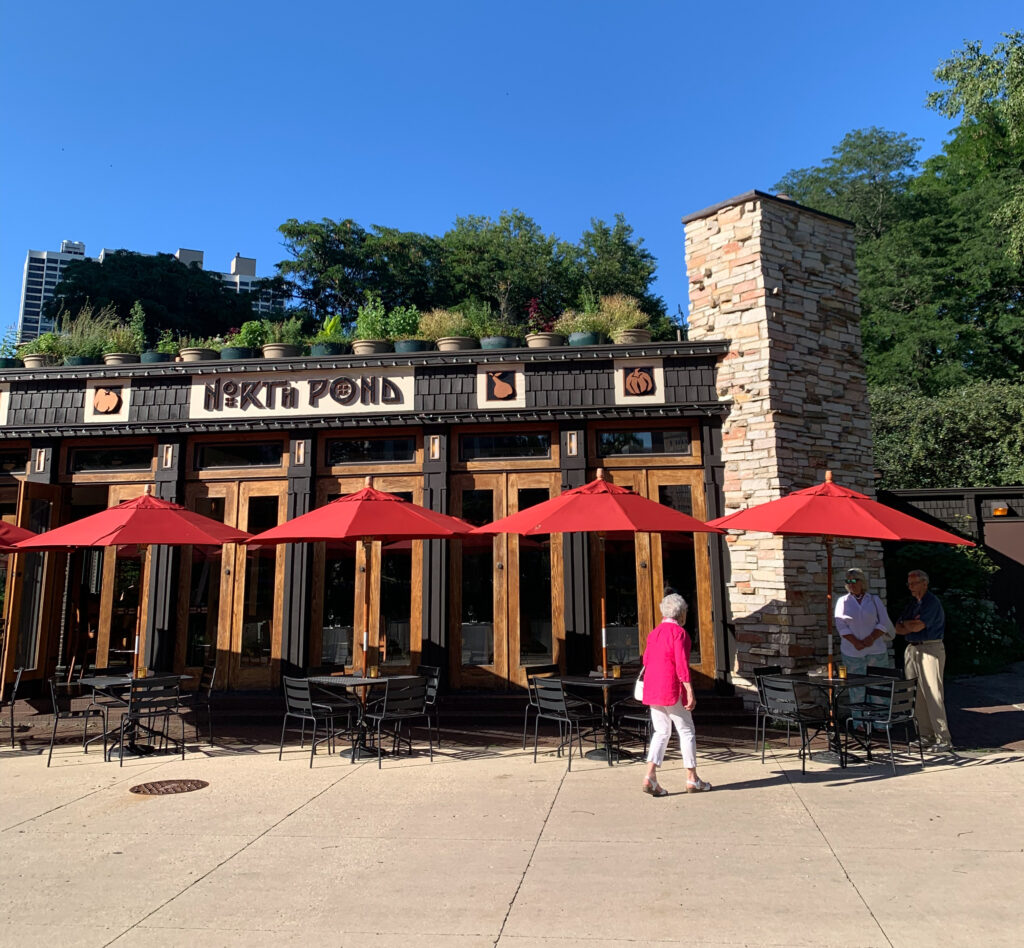
You are first struck by the side of the original, 100-year-old, glazed-brick building. Lined with shrubbery, the faded brown tones of the walls are offset by black shingles and squared, pillar-like window frames that match the aesthetic of the streetside signage. Rounding another bend, you come to North Pond’s newer (2002) addition: oak-framed French doors set against the same black pillars and shingles with the restaurant’s name rendered in an Arts and Crafts-style font. A towering stone chimney (reminiscent of the base of the aforementioned signage) overlooks it all while seemingly mirroring the high-rise located off in the distance.

Turning the corner, you come to the building’s façade: more French doors, more shingles, more pillars, with some accompanying patio seating and matching planters. “North Pond,” yet again, is emblazoned in that singular script. It is joined by those four symbols representing the seasons: mushroom, tomato, pear, and pumpkin. However, the single-story building ultimately cuts a subdued figure. It does not endeavor to steal any attention away from what surrounds it. Quite the opposite: everything is directed outward, through those doors, and toward the namesake pond. At its edge, a semicircular viewing deck, set with a series of benches, serves to collect the passersby. It may act as a stage for a wedding proposal (you have witnessed two there) or for some photographer’s elaborate rig. But, most often, it simply stuns visitors with a nature-nestled view of the Chicago skyline that rises from the trees and sees itself reflected in the water.
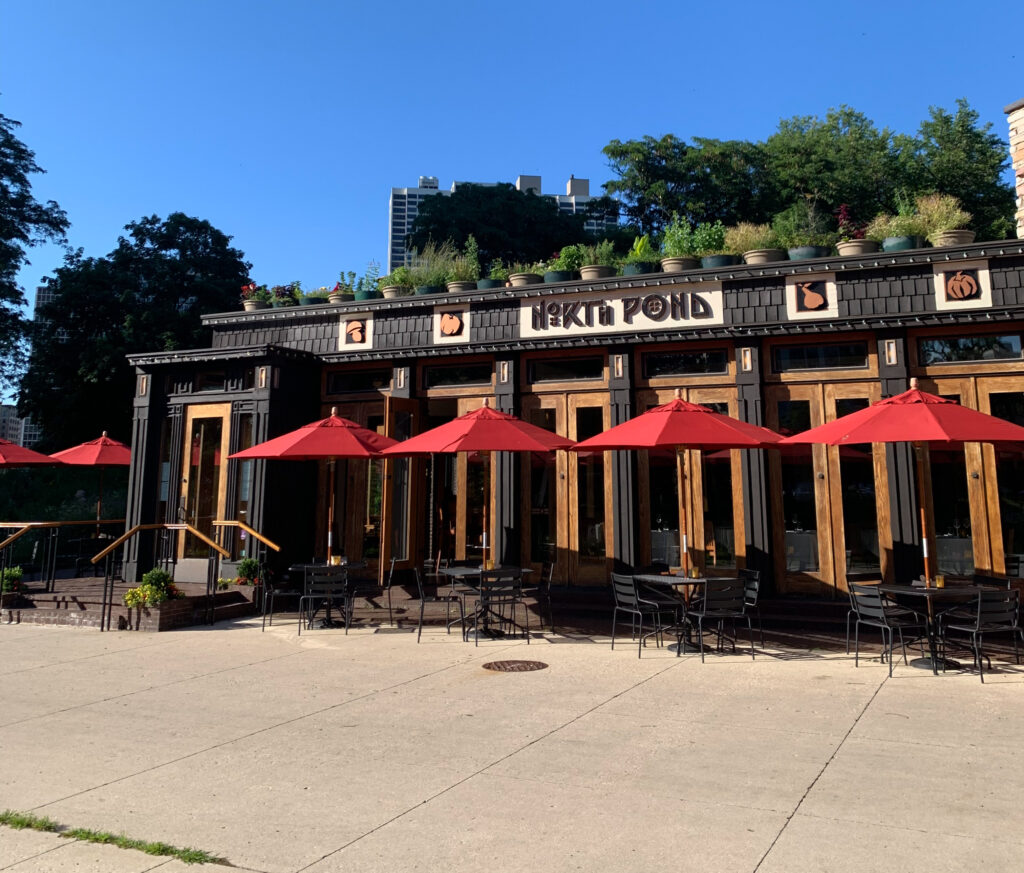
Terroir, a “sense of place,” a term so often invoked but rarely—so viscerally—fulfilled. This does not feel like the home of a Michelin-starred restaurant (or of any restaurant at all). Though L2O, that temple of gastronomy, could once be found just a block south of the pond, the wider area is hardly a dining mecca either. Comparably limp concepts like Esmé and Galit are probably the most notable alongside an eclectic smattering of others like Bocadillo Market, Chicago Pizza and Oven Grinder Company, Crisp, Del Seoul, Evette’s, Geja’s Cafe, The Gundis, Juno, Mild 2 Spicy, Naudi Signature Pizza, Sunset Phở Caffe, and The Wieners Circle. This is all to say: North Pond inhabits a world of its own when it comes both to setting and aspiration. It feels like a proper destination in a way that so few of the city’s restaurants—without recourse to expensive interior design schemes and other gimmicks—achieve. And who wouldn’t prefer an organic expression of place (one in total harmony with nature) to another that was totally contrived?
When it comes time to begin your meal, you traverse a couple steps and pull open the oak door that leads into the restaurant. You are greeted by a small bar area—also part of the 2002 addition—with a half dozen stools surrounding a curved, L-shaped counter. There, too, are a couple two-tops positioned on the floor up against the French doors that look out at the water.
But it is the bar—framed with the Thoreau quote “In Wildness is the preservation of the World”—that commands your attention. There, the light tones of wood that distinguish North Pond’s façade are translated into a three-tiered wall of shelving featuring the same style of pillars seen along the exterior bookended by a couple pyramidal cubbies. Dimly glowing lanterns hang overhead while much of the wallpaper matches the bright colors. However, the bartop itself is rendered in a darker brown. The flooring is made of a cool, blue-gray tile, and much of the ceiling, extending out from the bar, is done in a faded black with wooden inserts. This matches the chairs themselves—wooden frames with black leather cushions—and the planter perched on one end of the counter.
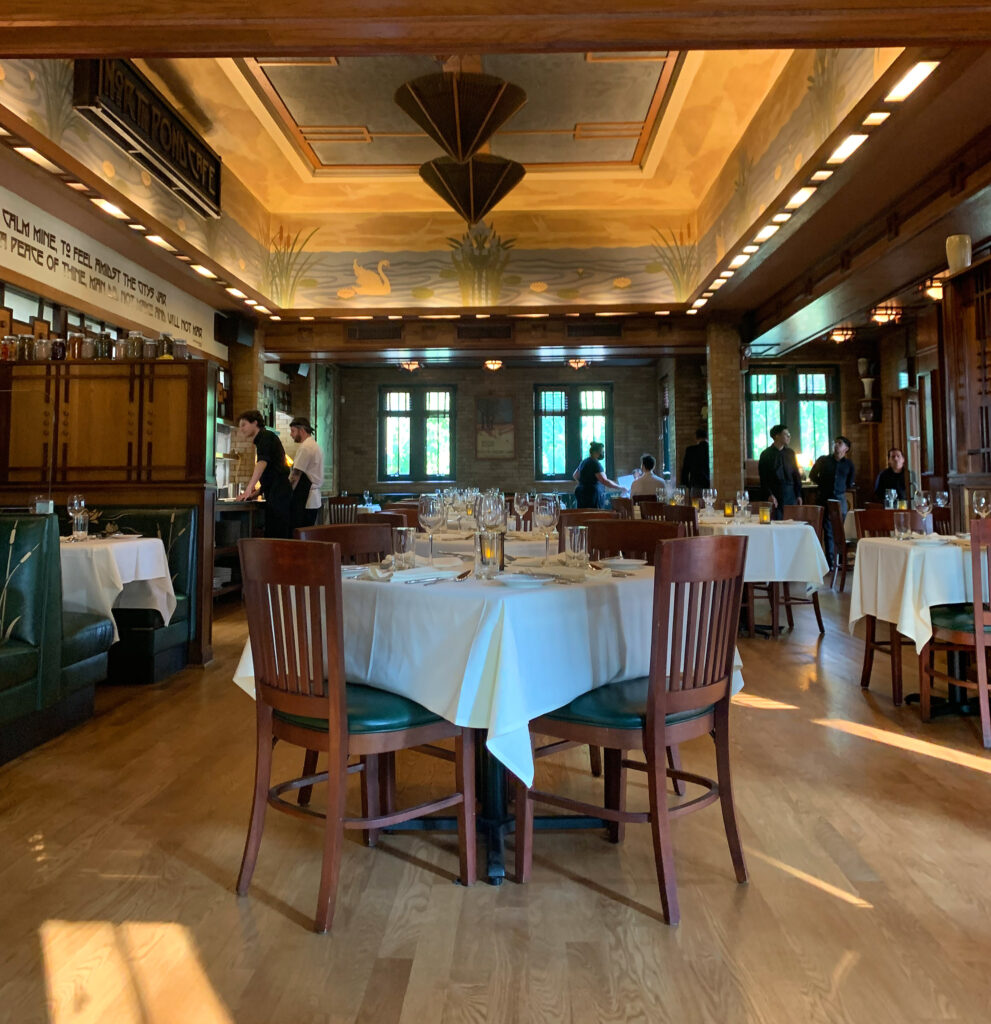
Stepping forward from just beyond the front door, you lock eyes with the host stand. Passing through the bar, you are cheerily greeted by the hostess and graciously acknowledged by John Arents, the restaurant’s managing partner who is always close at hand. Weather permitting, they ask if you would like to sit outside, a golden invitation for those who look to really embed themselves in North Pond’s picturesque setting. Otherwise (and despite the red umbrellas that shield the patio tables from the sun), you may opt to stay indoors. In that case, you are led to one of two rooms.
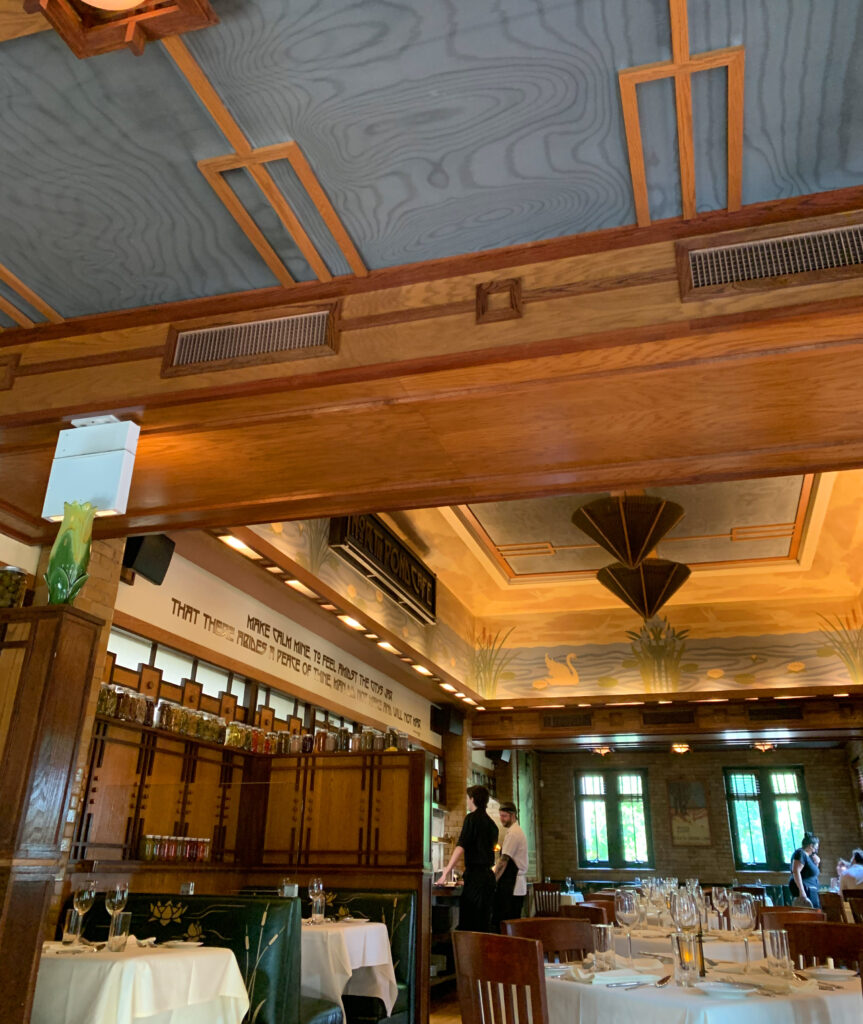
First, there’s the heart of the original 1912 warming shelter that, after being renovated, formed North Pond Café’s sole dining room from 1998 to 2002. Though diners seated here today do not enjoy a particularly good view of the surrounding nature, the space is simply iconic. Its centerpiece is undoubtedly a cut-out portion of the ceiling containing another rendition of restaurant’s outer signage surrounded by a frontlit, hand-painted mural of the pond. The details—swans, lily pads, native grasses, and flowers—are captivating. Just below the mural, framing the frosted glass that forms the upper boundary of the open kitchen, you find another evocative quote (adapted from Victorian poet Mathew Arnold’s “Lines Written in Kensington Gardens”): “Make calm mine, / To feel, amid the city’s jar / That there abides a peace of thine, / Man did not make and will not mar.”
The rest of the space is distinguished by brick and wood, conic chandeliers, white tablecloths, and a sprawling assortment of two-top, four-top, and booth seating. Two U-shaped booths, perched just beyond the host stand, can hold as many as five or six diners. Their blue-green leather is subtly emblazoned with cattails, flowers, and rippling water. Meanwhile, affixed to various walls surrounding the dining room, you find vintage advertisements for the South Shore Line featuring geese, ducks, skiers, snowbanks, and campsites with messaging celebrating the seasons of the Midwest.
Overall, the room feels cozy—and even seems to glow as the limited amount of natural light slowly dwindles. To that point, the mural helps to make up for the space’s detachment from the larger natural setting. So, too, does the bustle of the open kitchen. Personally, this dining room’s biggest virtue is its ability to accommodate sizable parties by rearranging the freestanding tables across the main floor. (It was rewarding, on one occasion, to see some dozen friends and family sneakily observing a proposal by the water, revealing themselves to the couple, and then all venturing inside to enjoy a celebratory meal together.) Otherwise, for groups of two to four diners, you must admit you actually prefer the restaurant’s adjoining space.
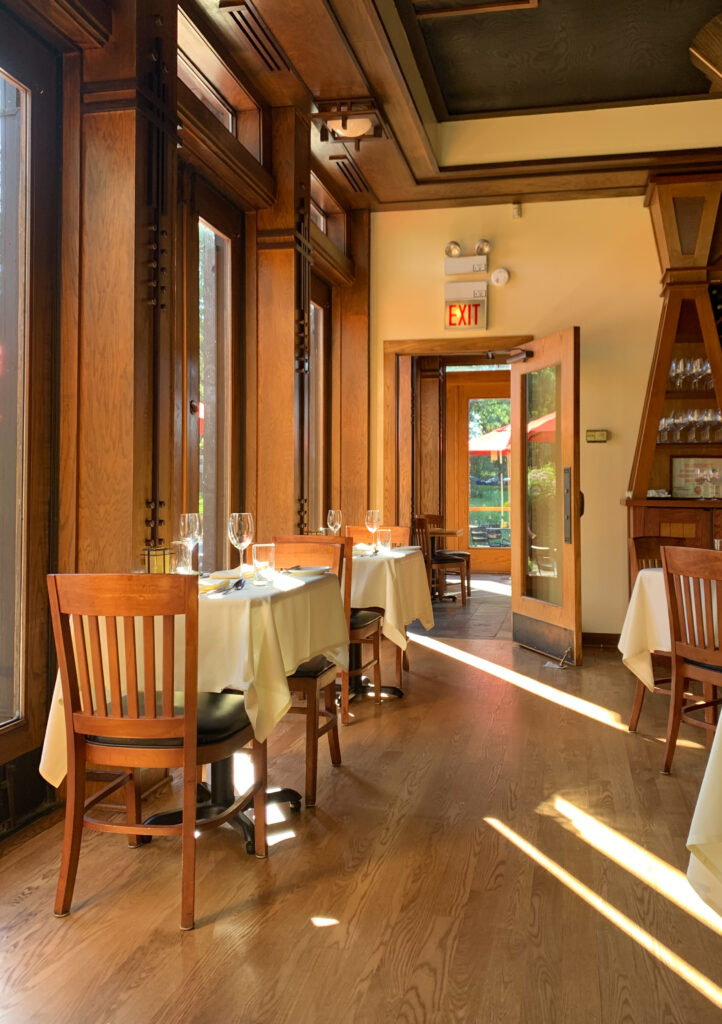
From the host stand, you might, as a second option, be led back around the bar and through a doorway standing perpendicular to North Pond’s entrance. The room it leads to was also part of the 2002 renovation and is distinguished by the stone fireplace whose chimney was so striking when viewed from outside. Above it, you find shelving lined with an eclectic assortment of ceramics. On either side, the French doors offer views of the outside. The floor of the space is filled with two-top and four-top tables bedecked with the same white cloth. The conic chandeliers imitate those found in the other dining room. But, in the corner from which you enter, you find a service station that replicates the back of the bar. There’s another quote—this time from Chaucer’s “Parliament of Fowls”—proclaiming: “The lyf so short, the craft so long to lerne.” And, beneath, lie wine racks with adjacent cubbies for glassware and water pitchers.
Overall, thanks to its intimacy and comfortable (in terms of exposure to the elements) view of the pond, you think the post-addition dining room offers North Pond’s most prime seating. However, in totality, there is not one table where you would be unhappy. Yes, leaving those French doors open during warmer weather means that bugs may sometimes find themselves trapped—buzzing in circles around your head—in certain corners. But there’s a complete synergy to all of the aesthetic elements, a quaintness and intricacy to the innumerable details, that will delight even those who have no conception of the Arts and Craft movement.
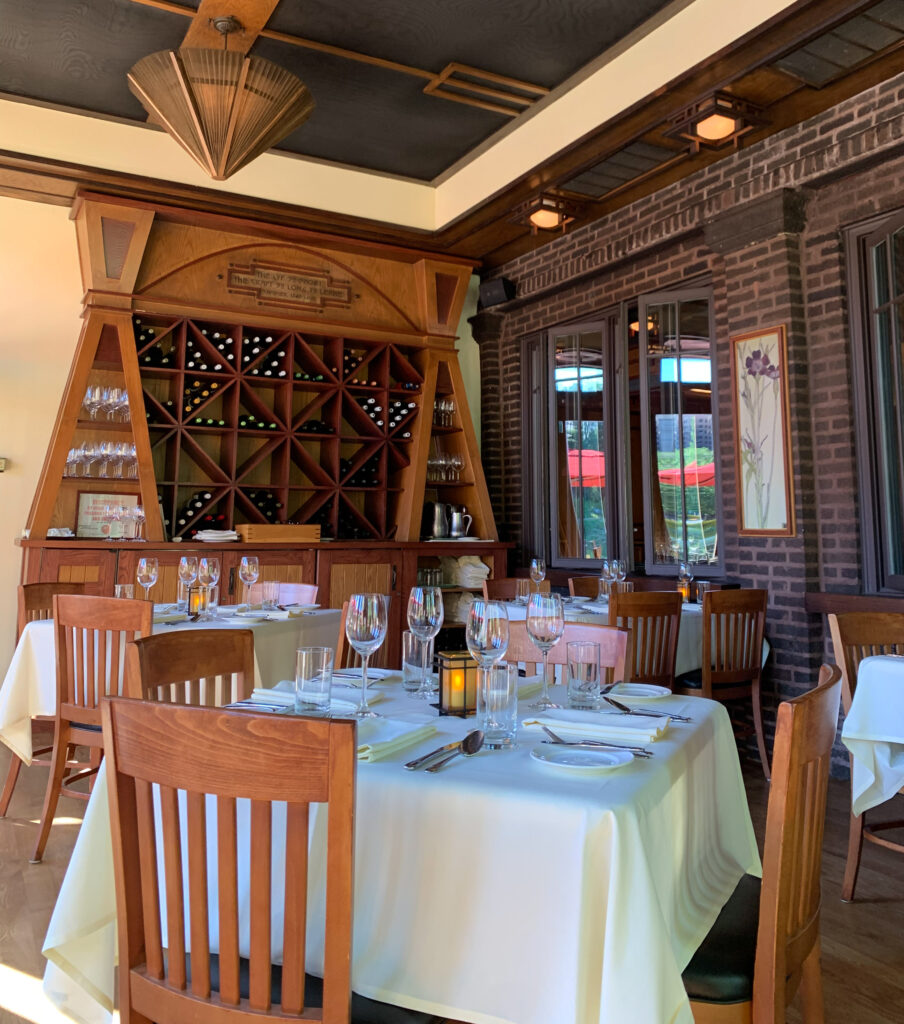
North Pond does not only blend effortlessly into the natural landscape, but its interior, more than two decades after undergoing its last major work, is just as effortlessly pleasing. Nothing about the restaurant feels worn—not even the bathrooms, which are spacious and immaculate compared to what you recently encountered at Boka. Rather, every aspect of the structure and its dressings feels thoughtfully composed and carefully preserved. The rugged simplicity and layered meanings that characterize the ambiance “highlight the inherent qualities of the raw materials” just as Sherman’s cooking, in his own words, emphasized “the beauty and flavor of the dish’s integral components.” In this manner, the former warming shelter has become timeless, in its own way, in fulfillment of an entirely new function. This is a great credit to Warren’s work, to Mott’s vision, and to all those who have cared for the place over the years.
Taking your seat at the table, a busser bustles by and begins pouring water. Dressed in all black, these front-of-house factotums strike you as being on the younger side. You might even describe them as a bit raw—but totally earnest, totally motivated to facilitate a great meal. When you ask if you can get sparkling water mid-pour, they react immediately with a gleaming smile and what seems like real joy at being given a chance to fulfill some special request. On one occasion, a busser even chased you down after dinner, some good distance beyond the restaurant on one of the trails flanking the pond, in order to return a wine bag you had left behind. It was only one of those free felt carriers that fashionable bottle shops give out like candy, the kind that could just as easily have gone in the trash. Nonetheless, the busser made that extra effort in what still resonates as an exemplary expression of hospitality.
Now settled in, you have a chance to observe your surroundings. Of course, there is the stream of passersby looking to stop by the edge of the pond. There is also the constant parade of dogs being walked through the park, as well as those rare (but disproportionately frequent) proposals. However, it is the clientele inside the restaurant that intrigues you. You first note the older gourmands: couples or sets of couples that have been coming here routinely for years (if not decades) and exude a sense of comfort as they chat about obscure seasonal ingredients or the quality of some other meal they have recently enjoyed. There are, in addition to this, your “special occasion diners” of all stripes: customers who are drawn, via North Pond’s reputation or perennial appearances on certain “most romantic restaurants” lists, to give the place a visit.
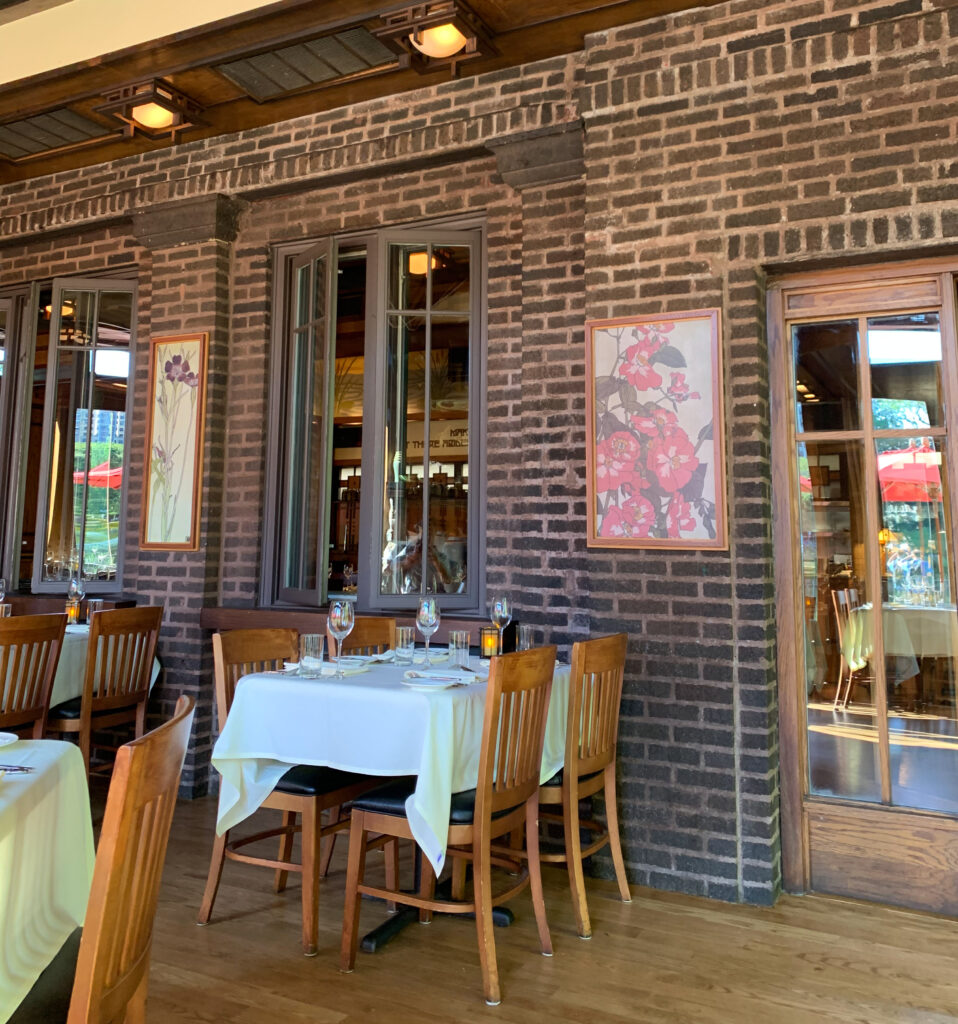
But you are most struck by the young—early 20s—couples. They may very well count as “special occasion diners” too, yet what counts is that they are not obviously foodies. Rather, these well-dressed patrons display palpable excitement about the experience. They do not eat through the lens of their phone camera but engage with (and contribute to) the atmosphere. Thus, they are a far cry from some of the shorts- or hoodie-clad star-chasers you see around the city’s more fashionable restaurants, conspicuous consumers who bury their heads in screens between courses. Everyone, you should clarify, has the right to enjoy fine dining in any way they please. Just the same, sincere engagement with the form should be applauded, for it makes North Pond feel eternal: a place where successive generations give something of themselves in service of a larger ambiance that enriches everyone’s evening. This sacrifice, in truth, honors the chef’s food and the lack of pretension the staff brings to the table. It underlines the importance of local sourcing and seasonal cooking in an era of increasing style over substance. It marks how Sherman’s work really has taken hold at a broader cultural level.
In due time, your server cheerily introduces themself and hands the party their menus. They leave you, the host, with the beverage book and assure the assembled guests they will return in a moment to go over the food.
Turning toward the drinks, you begin with a selection of nine cocktails (each priced at $16) that are curated—as with the beer and wine offerings—by managing partner John Arents (who managed North Pond from 2004 to 2005 before spending time with LEYE and Sepia and then returning in 2019). Some of these libations are relatively longstanding recipes; however, there is also a certain degree of seasonal dynamism meant to match the evolving food menu.
At present, three of the cocktails feature some form of whiskey and two feature gin with the remainder being based on rum, sotol, tequila, or Lillet Blanc. Owing to the summer season, many of the other components—like hibiscus, cherry tea, ginger, elderflower liqueur, honey syrup, violet liqueur, grapefruit bitters, rosé-rhubarb syrup, and yuzu—provide uplifting fruity, sweet, or floral notes to ensure a sense of refreshment.
You have sampled the “Astronaut Orange” (gin, Acgua di Cedro, Campari, honey syrup, lemon, bitters, seltzer) and “The Parker Daiquiri” (rum, Demerara syrup, Luxardo Maraschino, yuzu, grapefruit bitters), enjoying them both. The former (which references Tang without utilizing orange) benefits from a double dose of lemon (Acqua di Cedro being a limoncello-like liqueur made with Cedro lemons) and displays a perfectly moderated bitterness with a bit of sweetness. You typically do not tend toward gin but find this combination to be expertly balanced and beautifully refreshing in the manner you just mentioned. The latter cocktail plays with the idea of a “Hemingway Daiquiri” but introduces the molasses character of the Demerara and the subtly floral (but still plenty tart) yuzu. While not quite as crisp and chuggable as the “Astronaut Orange,” the combination accentuates the woodsy, darkly sweet character of the rum in a way that is sure to please fans of more spirit-forward libations. In sum, these are classically styled cocktails with thoughtful, creative touches that make for an approachable, enjoyable start to the meal. This is an admirable selection.
Turning toward the real object of your desire—the wine—you think it best to begin with the pairing. This option is appended to the food menu, which takes the form of a four-course prix fixe with three selections (four for dessert) in each category. $67 gets you a series of four pours tailored to your chosen dishes with two to three wines per category. That means some of the pairings are used across two different preparations, with only the “Main Courses” featuring totally unique choices. The assembled wines are as follows:
First Courses
- 2021 Cà dei Frati “I Frati” Lugana (100% Verdicchio)
OR
- 2021 Weingut Ökonomierat Rebholz Weißer Burgunder Trocken Pfalz (100% Pinot Blanc)
Second Courses
- 2022 Gundlach Bundschu Estate Vineyard Dry Gewürztraminer Sonoma Valley
OR
- 2018 Robert Sinskey “Abraxas” Scintilla Sonoma Vineyard Carneros (Riesling, Pinot Blanc, Pinot Gris, Gewürztraminer)
Main Courses
- 2021 PlumpJack Reserve Chardonnay Napa Valley
OR
- 2020 DeLille Cellars “D2” Proprietary Red Wine Columbia Valley (61% Merlot, 27% Cabernet Sauvignon, 8% Cabernet Franc, 4% Petit Verdot)
OR
- 2016 Terre Rouge “Les Côtes de L’Ouest” Syrah California
Desserts
- 2018 Royal Tokaji “Late Harvest” (Furmint, Hárslevelű, Muscat, other native varietals)
OR
- Château d’Orignac Pineau Des Charentes
OR
- 2019 Kracher Spätlese Cuvée Burgenland (45% Pinot Blanc, 45% Chardonnay, 10% Welschriesling)
Now, you have not sampled the pairing or any of these particular wines yourself. But you are familiar with the producers, and it is easy to make sense of what is going on here. $67 is a pittance as far as pairings go, with places like Sepia ($59) and Elske ($60) also offering one single option (no tiered “premium” or “reserve” choice) at a highly accessible price. Thus, North Pond must get creative in order to wow its patrons while preserving a sense of value (for itself and for customers). Elske’s comparably trendy identity allows it to embrace an eclectic array of natural wines—a category whose bottles tend to be competitively priced—for a willing audience. North Pond, instead, must balance multiple generations of patrons while abiding by its long-term commitment to “honor the Arts and Crafts philosophy by attempting to focus on artisan producers who ‘craft’ small lots of wine and understand the connection between the land and their goods.” This, according to the restaurant, “results in wines of a character difficult to reproduce in another vineyard or region.”
The four pairings used across the “First Courses” and “Second Courses” draw upon uncommon white varieties. The Verdicchio, paired with ingredients like cucumber, trout roe, tuna, tomato, and crab, offers clean, ripe fruit with a round texture (and twinge of acidity) that amplifies the crisp vegetables and seafood. In contrast, the predominance of Pinot Blanc and Gewürztraminer in the other three wines lends these pairings a distinct florality and even greater sense of body and depth to go along with their fruit. These qualities help match ingredients like foie gras, ricotta, smoked eggplant, fava beans, black truffle, and toasted masa that could easily overwhelm leaner, acid-driven grapes. It is also worth mentioning that Gundlach Bundschu, Ökonomierat Rebholz, and Robert Sinskey all benefit from name recognition (while Cà dei Frati is the most notable winery in its region). Rebholz, in particular, enjoys a reputation as a cult biodynamic Riesling producer in Germany. This is all to say that sourcing obscure varieties from prominent producers guarantees a certain baseline—if not very good—quality for the price.
The pairings for the “Main Courses” might be the most interesting given that three dishes (“Rainbow Trout, Corn”; “Wagyu, Celtuce”; “Lamb, Dates”) are being each paired with different grapes. Of course, the combinations of Chardonnay with fish, Merlot/Cabernet with beef, and Syrah with lamb are as classic as can be. However, it is worth noting the retail prices of the PlumpJack Reserve Chardonnay ($50), DeLille Cellars “D2” ($40), and Terre Rouge “Les Côtes de L’Ouest” ($25). While not an outright indicator of quality, these sums (at least in the first two cases) come close to rivaling the price of the pairing altogether. Further, they are recognizable wines that score well and offer intense, approachable (in youth) flavors that fulfill exactly what a mainstream consumer would want out of a “bold white” or “bold red.” At the same time, they are more thoughtfully chosen than that (you would certainly enjoy the PlumpJack) and have the potential to expand the palate of someone who is comfortable drinking the same bulk brand every night.
Finally, to go with the “Desserts” you find two entry-level sweet wines from two legendary producers: the Royal Tokaji (paired with flavors of peach, cherry, and meringue) and the Kracher (paired with gouda-, Taleggio-, Brie-, and parm-style cheeses). These are simply top selections that aim at pure pleasure while providing patrons with a taste of the kind of styles that even out-and-out oenophiles get excited about. Pairing something with a combination of pound cake, chocolate ganache, and apricot proves a bit more complicated, but the Château d’Orignac Pineau seems like a clever choice. This combination of unfermented Cabernet Sauvignon and Merlot juice with Cognac, aged for five years in oak and served chilled, offers adequate weight and roundness to match a heavier dessert. It remains plenty sweet but provides a tinge of higher alcohol that many diners enjoy at the end of a meal.
Overall, a $67 pairing at a long-running restaurant naturally arouses your suspicion: just what sort of cut-rate stuff—bottles they have been unable to sell or that have been foisted on them by purveyors—are they pouring to turn a profit? However, North Pond’s selection leaves you with a feeling of surprising quality and generosity. It demonstrates a clear understanding of the peak-end rule and knows just how to push the average consumer’s palate forward while also rewarding it with something familiar. Given the concept’s broad “special occasion” appeal, this is a wonderful turnkey option that even treats more knowledgeable drinkers with respect.
North Pond’s by-the-glass selection follows much of the same philosophy and, at present, comprises the following bottles:
Sparkling
- NV Domaine Vigneau-Chevreau Vouvray Pétillant Demi-Sec ($17)
- NV Canard-Duchêne Brut Champagne ($18) (40% Pinot Noir, 40% Pinot Meunier, 20% Chardonnay)
- NV Thiénot Brut Champagne ($20) (45% Chardonnay, 35% Pinot Noir, 20% Pinot Meunier)
White
- 2022 Lasalde Getariako Txakolina Euskadi ($16) (100% Hondarribi Zuri)
- 2022 Do Ferreiro Albariño Rías Baixas ($17)
- 2021 Jonathan Didier Pabiot “Elisa” Pouilly-Fumé ($18) (100% Sauvignon Blanc)
- 2019 Ramey Fort Ross-Seaview Chardonnay ($22)
- 2021 Domaine Guillaume Curveux Mâcon-Fuissé ($18) (100% Chardonnay)
Rosé
- 2020 Maison Lelièvre “Gris de Toul” Côtes de Toul ($16) (80% Gamay, 20% Pinot Noir)
- 2020 Clos Sainte-Magdeleine Côtes de Provence ($18) (35% Grenache, 35% Cinsault, 20% Mourvèdre, 10% Syrah)
- 2022 Robert Sinskey Vineyards “Vin Gris of Pinot Noir” Carneros ($19)
Red
- 2021 Stolpman Vineyards “Combe” Trousseau Ballard Canyon ($19)
- NV Roco “Gravel Road” Pinot Noir Willamette Valley ($17)
- 2020 Les Terres Blanches (Celine et Benoit Blet) “Anjou Démon” Anjou ($18) (100% Cabernet Franc)
- 2021 Peju “Legacy Collection” Cabernet Sauvignon Napa Valley ($22)
- 2019 Hedges Family Estate Red Mountain ($18) (43% Merlot, 23% Cabernet Sauvignon, 17% Syrah, 4% Cabernet Franc, 7% Malbec, and other varieties)
Once again, the restaurant utilizes slightly more obscure wines like a sparkling Vouvray, a Txakolina, an Albariño, a rosé from Lorraine, a domestic Trousseau, and an Anjou rouge to provide value in the $16-$19 range. But these are hardly just cheaper alternatives. Rather, they represent bottles that many drinkers may actually favor stylistically due to their sweetness, spritziness, saltiness, or for their juicy, earthy, or peppery fruit.
The remainder of the by-the-glass list highlights what consumers know and love: Champagne, Sauvignon Blanc, Chardonnay, Provençal rosé, cult California rosé, Pinot Noir, and Bordeaux varieties. Priced from $18-$22, these options are not too far removed from the previous range. Someone who favors one of these categories is almost certain to order the corresponding wine. Rather than being exploited for fitting that mold, you are rewarded with some top selections.
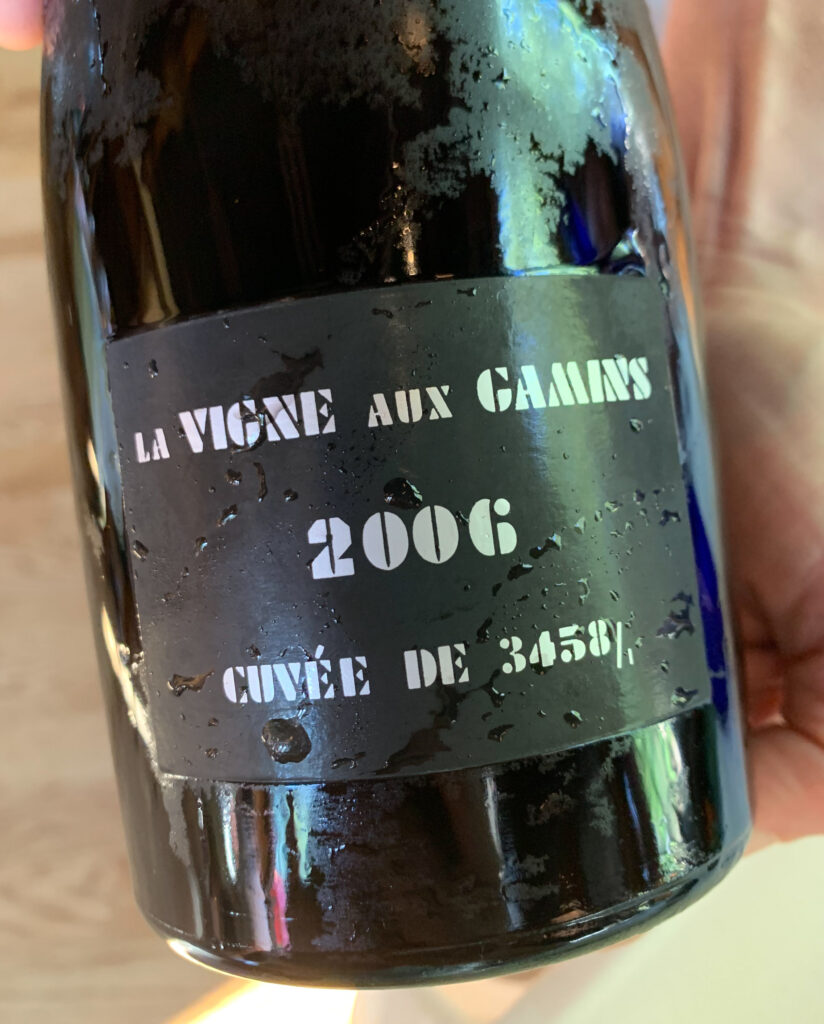
The Champagnes both benefit from being non-vintage (showing more of an aged character through the addition of reserve wines) but differ in their degree of Chardonnay (a grape that adds acidity and structure to the blend), offering a clear stylistic divergence and even the chance to have an educational moment with the server. The “Elisa” Pouilly-Fumé needs to be able to entice those who favor Sauvignon Blanc from Sancerre or New Zealand, and its Demeter certification signals a biodynamic approach that yields freshness and intensity. The Chardonnays, meanwhile, offer a choice between a crisp, stony example from Fort Ross-Seaview and a more buttery, oaked example from the Mâcon. The former from Ramey, in particular, is a stellar offering.
Both the Provençal and California rosés are high-quality examples with loyal fanbases, so it is a treat to drink them by the glass. The Willamette Pinot Noir is fairly basic but is also the cheapest red wine. It is not a mass-market brand and, quite the opposite, is situated in a region that promises better value. The same goes for the Peju and the Hedges: they are aiming at the masses but are critically well-received and liked by the majority of drinkers. They fulfill exactly what lovers of the style (and only that style) want, leaving something like the Trousseau for you to enthusiastically drink.
Overall, you think this is an approachable and enjoyable by-the-glass program that succeeds in giving everyone a thoughtful, above-average (or even much higher) version of what they want. You might like to see a Riesling added to the mix, but both neophytes and knowledgeable drinkers will find something to enjoy. However, the latter class, for what it’s worth, should be directing their attention to the bottle list.
While you have covered the range of producers that have featured at North Pond over the years, these are some notable present selections:
Sparkling
- NV Gaston Chiquet Premier Cru Brut Rosé Champagne ($112)
- NV Vazart-Coquart & Fils Grand Cru Brut Blanc de Blancs Champagne ($99)
- 2012 Geoffroy “Volupté” Premier Cru Brut Blanc de Blancs Champagne ($188)
- NV Henriot Brut Rosé Champagne ($148)
- 2015 Julliet-Lallement Special Club Grand Cru Brut Champagne ($210)
- 2017 Raventós i Blanc “De la Finca” Brut ($73)
- 2006 Thiénot “La Vigne aux Gamins” Grand Cru Brut Blanc de Blancs Champagne ($239)
- NV Vilmart & Cie “Grand Cellier” Premier Cru Brut Champagne ($174)
White
- 2019 Lucien Albrecht “Spiegel” Grand Cru Riesling Alsace ($70)
- 2020 Guy Amiot et Fils “Les Grands Champs” Bourgogne Aligoté ($69)
- 2018 Bonneau du Martray Corton-Charlemagne Grand Cru ($450)
- 2022 Cade Sauvignon Blanc Napa Valley ($78)
- 2018 M. Chapoutier “La Combe Pilate” Collines Rhodaniennes ($54)
- 2018 Daniel-Etienne Defaix Chablis Vieilles Vignes ($90)
- 2019 DuMOL “Chloe” Chardonnay Russian River Valley ($156)
- 2020 Eyrie Vineyards “Estate” Pinot Gris Dundee Hills ($64)
- 2019 Domaine Huet “Clos du Bourg” Vouvray Sec ($95)
- 2015 Jarvis “Finch’s Hollow Vineyard” Chardonnay Napa Valley ($201)
- 2018 Domaine Jean François “The Twelve Rows” Sanford & Benedict Chardonnay Santa Rita Hills ($180)
- 2019 Domaine Labet “Lias” Chardonnay Côtes du Jura ($105)
- 2016 Louis Latour Chassagne-Montrachet ($162)
- 2019 Domaine de la Pépière “La Pépie” sur Lie Muscadet Sèvre et Maine ($41)
- 2021 Purple Hands “Dundee Reserve” Chardonnay Dundee Hills ($92)
- 2014 Rocchioli Vineyards “Estate” Chardonnay Russian River Valley ($142)
- 2017 Domaine Serene “Evenstad Reserve” Chardonnay Dundee Hills ($150)
- 2021 Stolpman Vineyards “Uni” Ballard Canyon ($63)
- 2019 Alain Voge “Harmonie” Saint-Péray ($94)
- 2021 Domäne Wachau Ried Achleiten Grüner Veltliner Smaragd ($108)
Red
- 2020 Domaine Bachelet-Monnot Maranges “La Fussière” Premier Cru ($114)
- 2016 Franck Balthazar “Sans Soufre Ajouté” Cornas ($159)
- 2015 Boroli Cerequio Barolo ($230)
- 2018 Daniel Brennan “Testify” Pinot Noir Hawke’s Bay ($125)
- 2018 Henri & Gilles Buisson “Sous Roche” Saint-Romain ($124)
- 2021 Ceritas “Costalina” Pinot Noir Sonoma Coast ($120)
- 2018 Maison Pascal Clement Bourgogne Rouge ($118)
- 2016 Corison Cabernet Sauvignon St. Helena ($222)
- 2011 Domaine du Coulet “Billes Noires” Cornas ($161)
- 2021 Cristom “Mt. Jefferson Cuvee” Pinot Noir Eola-Amity Hills ($89)
- 2018 Darioush Merlot Napa Valley ($153)
- 2018 Bruno Desaunay-Bissey Vosne-Romanée Premier Cru Vieilles Vignes ($270)
- 2020 DuMOL “Wester Reach” Pinot Noir Russian River Valley ($165)
- 2018 Eyrie Vineyards Pinot Noir Dundee Hills ($85)
- 2016 Dominio Fournier “Crianza” Ribera del Duero ($68)
- 2020 Hirsch Vineyards “San Andreas Fault” Pinot Noir Sonoma Coast ($90/375mL)
- 2018 Inglenook Cabernet Sauvignon Rutherford ($210)
- 2018 Domaine Jean François “The Twelve Rows” Sanford & Benedict Pinot Noir Santa Rita Hills ($231)
- 2015 Domaine Latour Giraud Pommard Refène Premier Cru ($160/375mL)
- 2015 Château des Laurets “Baron Sélection Parcellaire” Puisseguin-Saint-Émilion ($194)
- 2011 R. López de Heredia “Viña Tondonia” Rioja Reserva ($112)
- 2019 Matthiasson Cabernet Sauvignon Napa Valley ($165)
- 2019 Domaine Sylvain Morey Chassagne-Montrachet ($147)
- 2017 Giulia Negri “La Tartufaia” Barolo ($120)
- 2016 La Niverdière “Résilience” Chinon ($78)
- NV Opus One “Overture” Napa Valley ($320)
- 2018 PlumpJack “Estate” Cabernet Sauvignon Oakville ($340)
- 2018 Château Prieuré-Lichine “Confidences de Prieuré-Lichine” Margaux ($80)
- 2014 Ramey “Rodgers Creek Vineyard” Syrah Sonoma Coast ($135)
- 2020 Ridge “Geyserville” Sonoma County ($114)
- 2012 Château Roc de Cambes Côtes de Bourg ($153)
- 2018 San Giorgio “Ugolforte” Brunello di Montalcino ($130)
- 2020 Domaine de la Solitude Châteauneuf-du-Pape ($99)
- 2017 Tommasi Amarone della Valpolicella Classico ($131)
- 2021 Ken Wright “Carter Vineyard” Pinot Noir Yamhill-Carlton ($124)
Now, you must admit that you are sad to no longer see some of the great producers North Pond has offered over the years: ones like Dagueneau, Dauvissat, Dönnhoff, Egly-Ouriet, Evening Land, Hubert Lamy, Benjamin Leroux, Littorai, Pierre Peters, Joh. Jos. Prüm, Roulot, Tempier, Tissot, and Vacheron (to name but a few). But there is still plenty to like.
The current bottle list features notable producers like Bachelet-Monnot, Bonneau du Martray, Corison, Huet, Labet, Latour-Giraud, López de Heredia, Matthiasson, Opus One, Ridge, Rocchioli, and Vilmart while covering incredible ground when it comes to grape varieties and appellations. First, there is plenty of vintage and non-vintage Champagne on offer in various blended, blanc de blancs, and rosé styles (along with a value sparkler courtesy of Raventós). On the white side, you find Aligoté, Chardonnay (from Burgundy, California, Jura, and Oregon), Chenin Blanc, Grüner Veltliner, Muscadet, Pinot Gris, Sauvignon Blanc, and Riesling all represented along with a few interesting bottlings of Marsanne, Roussanne, and Viognier. Meanwhile, on the red side, you find Cabernet Franc, Cabernet Sauvignon (from Bordeaux and Napa), Corvina, Grenache, Merlot, Nebbiolo, Pinot Noir (from Burgundy, Martinborough, Oregon, and Sonoma), Sangiovese, Syrah, Tempranillo, and Zinfandel.
With prices ranging from $54-$450, there is really something for everyone. You particularly like the age on some of the Chardonnays (2014-2016) and a couple of the Syrahs (2014, 2016). The presence of these bottles signals that certain wines are bought in large enough quantities to sit on the list and actually reach some kind of maturity. Moreover, their prices are not being revised ex post facto in order to solicit more money for what has now become an ”aged selection.” For example, the 2016 Louis Latour Chassagne-Montrachet, which retailed for $79.99, is being offered for a mere 100% markup ($162) even though the current vintage is now priced at $114.99. Likewise, the 2016 Franck Balthazar “Sans Soufre Ajouté” Cornas, which retailed for $69.99, is being offered for about a 127% markup ($159) even though the current vintage is now priced at $119.99.
Being able to drink aged wines at throwback, low-markup pricing is a huge treat. It makes you dream about what goodies might have sat on the list over the years, but there is no reason to fret. North Pond maintains a rather generous pricing philosophy through the present day. Desirable bottles, like the Vilmart “Grand Cellier” Champagne ($174 on the list, $84.99 at retail), 2018 Bonneau du Martray Corton-Charlemagne ($450 on the list, $350 at retail), 2019 Labet “Lias” ($105 on the list, $142 on Wine-Searcher), and 2018 Jean François Sanford & Benedict Pinot Noir ($231 on the list, $114.96 at retail) maintain that single, 100% markup. For particularly coveted bottles (like the Corton-Charlemagne and the Labet), you may actually be paying close to—or even less than—retail!
Overall, this kind of pricing philosophy ensures that diners need not look up pricing in order to discern which bottles deliver an appropriate level of value. Instead, as with the by-the-glass program, they may simply choose their favorite grape or region and trust that whatever amount they wish to spend will go a long way. Few restaurants in Chicago, especially at the Michelin-starred level, maintain such low markups, and, in doing so, North Pond demonstrates that it is the sort of place where people who are there to celebrate a special life event can celebrate wine too. When you throw in a $50 corkage fee—one that seems steep at first glance but must be understood as appropriate given how generous the program is—nothing stands in the way of you toasting with a bottle that is truly superlative.
Arents has done an excellent job with each of these menus—pairing, by-the-glass, and bottle list—while ensuring that the level of wine service matches the quality of what is being poured. It is important to note that North Pond does not operate with a sommelier. Rather, the managing partner and floor manager help out as necessary but leave most of the heavy lifting to the servers. Such a decision seems risky, burdening the front-of-house staff with arcane vinous knowledge when they have so much else to facilitate, but it actually works well.
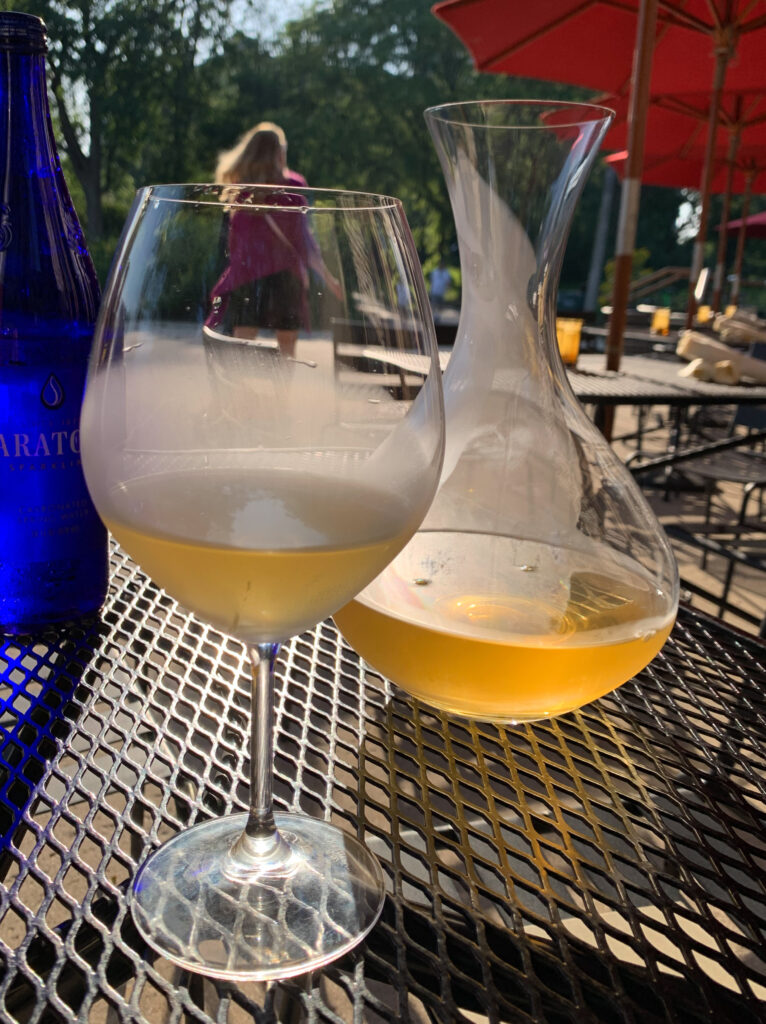
The servers locate your chosen bottle, properly present it, pour you a taste, and attend to any decanting or chilling that might be necessary with total fluency. What they lack in pomp, they more than make up for with a confident, practical air that reminds you of ordering bottles (fine bottles) in a charming French bistro. The wine is shown respect, but it is not treated as a dainty luxury good. The role it plays at the restaurant, as a companion to your meal, feels totally natural: an artisan product, expressive of its vintage, juxtaposed with seasonal fare, expressive of its moment in time. Neither screams for attention. Both are totally self-possessed. They allow you to soak in the surrounding nature, take a bite or a sip, and be struck—suddenly—by the kind of thunderbolt of flavor that makes the whole aesthetic experience unforgettable. When you consider how much less you are paying for a bottle here, what an outsized degree of quality you get for the same sum, this effect is only amplified.
Yet serving a bottle is easy enough, and, admittedly, the servers are not equipped to geek out over your more esoteric choices. Instead, it is hearing them explain the pairings to other guests that impresses you. They do not trip over their words or rely on winks or nudges to get through the spiels. No, there is a sense of authority and maturity to how the servers (assisted by the floor manager) present bottles. They pronounce the names of producers smoothly, translate key terms, and invoke elements of natural winemaking and geography to tell a story of craftsmanship and translate a sense of place. They also, as necessary, top off glasses to ensure no diner is left dry by the time their food arrives (this is especially true when considering the presence of a supplemental course).
Given that there are only 10 wines on the pairing to keep track of in total, this level of wine service—for a Michelin-starred, “special occasion restaurant”—should be expected. But, when you also consider the diversity of options and superlative value offered, North Pond’s beverage program is quietly excellent. It represents a welcome surprise for those who are drawn to the restaurant due to its setting, one that reflects a respect for the consumer—and for wine’s essential place in the practice of gastronomy—that has become all too rare in Chicago. When other concepts, backed by large restaurant groups, choose to squeeze patrons for three- or four-times retail price, North Pond’s approach should be celebrated—fervently!
With your beverage order settled, the server returns to go over the food menu. As previously mentioned, North Pond, post-pandemic, has moved away from the combination of à la carte and tasting options that characterized the restaurant for most of its history. In their place, the kitchen offers a $125 prix fixe composed of three “First Courses,” three “Second Courses,” three “Main Courses,” and four “Desserts” from which diners choose option per category.
This is all explained rather tenderly for those who have never encountered such a form before, along with the one stipulation that the kitchen demands your entire order all at once. The supplement, a preparation of “Lobster” ($40) positioned between the “Second Courses” and “Main Courses,” is also introduced (with plenty of assurance that such a splurge is totally optional). Otherwise, the server may, if you ask them, tell you they favor the “Wagyu, Celtuce” to the “Lamb, Date.” They may admit that they prefer the “Cherry Pavlova” to all other desserts. Should you wish to order additional food—like the couple seated next to you who wanted to split a third plate within each of the categories—the request is warmly received and even encouraged during future visits.
Overall, North Pond’s servers are friendly, enthusiastic custodians of the experience who arrive at the table ready to reassure diners who have never been to such a restaurant but, very quickly, provide those who know what (and how much) they want with the keys to the kingdom. After placing your order, these figures principally focus on replenishing your water and wine, which they do with aplomb. They may even, if the situation calls for it, retrieve a quilt for a patron that is feeling a bit of a chill outside. That being said, there have been a couple technical missteps—launching a menu across the table and hitting a guest or missing the fact that a fly is floating in your water—but these are the sort that get forgotten in the grand scheme of things. Otherwise, the server’s role is more one of overseeing and conducting—a division of labor that works quite nicely.
That has much to do with the talent of the bussers, whom you have already mentioned with regard to water service. However, considering that these more junior members of the team drop all the dishes, explain their components, and retrieve the empty plates (sometimes soliciting feedback), they come close to stealing the show. Some of these young bussers show flashes of self-consciousness, but their sincerity—the lingering eye contact, the graciousness with which they receive your gratitude—is striking. Others are polished and charismatic beyond their years, drawing on the power of observation to provide a perfectly timed joke. Most importantly, they all feel like a proper extension of the kitchen. They describe the dishes with precision and respond to your feedback with obvious pride.
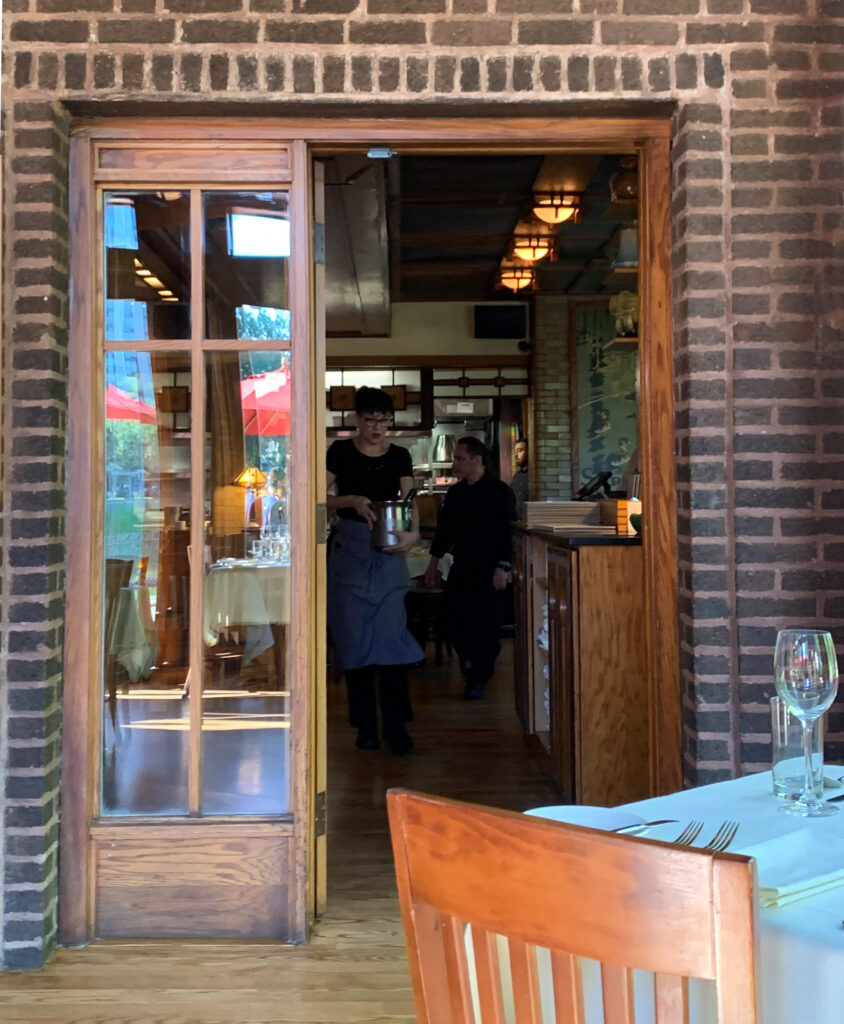
This is a great credit to the sense of ownership that has been established from top to bottom throughout North Pond’s team. Everyone feels present, totally tuned in, and like they are expressing some true sense of themselves through service. And, if the least among the staff are able to do so without fail, there is really some inspired leadership occurring.
Even Murillo, from time to time, will pop out of the kitchen to drop off a dish. His greeting—a quick “hey, guys”—may lack some of the bearing a more senior chef would bring to the table. However, it feels totally fluid and natural. It captures the very same energy you sense from the rest of the staff, and it is befitting of a professional who is in the process of making his name. Murillo wisely knows the power such a gesture—no matter how small—holds, and it is one, like the rest of the hospitality on display at North Pond, that finds its source in sincerity of emotion rather than any kind of contrived performance. The same is also certainly true of Arents, who—despite his seniority (often a double-edged sword)—leads by example and absolutely brims with positivity. He makes you feel like the restaurant is truly enthused to be hosting you, a rare feeling (and just what diners, all diners, are looking for here).
Ultimately, North Pond does not consciously brand itself as a hospitality luminary. Its founders do not posture on social media. The restaurant, as with the beverage program, just quietly pursues excellence. It possesses a strong, welcoming culture that is effortlessly expressed from top to bottom. You get the sense that everyone—especially those in the most junior roles—enjoys working there, and that makes your sojourn out in nature feel especially sublime. Harmony between man and nature, between server and served, is the order of the day.
Having made your order, the meal now begins. Though, to be honest, you neglected to mention that the kitchen actually treats you to an initial offering before the menus are even placed in your hand.
The bussers bring each diner a small glass of Murillo’s “Tepache,” a Pre-Columbian (specifically Nahuan) drink from Central Mexico. The beverage was traditionally made from a base of fermented corn and, today, is typically produced using the peel and rind of pineapples before being sweetened. For his version, the chef makes use of seasonal fruit like strawberry, cherry, rhubarb, Korean melon, and raspberry combined with a bit of vanilla. The resulting tipple is slightly cloudy with a mild degree of effervescence. It displays a pristine, intense expression of red berry fruit on the front end with a bit of roundness and depth drawn from the melon on the finish. In sum, this drink easily surpasses most artisan kombuchas and makes for a tantalizing start to the evening.
Later, once the menus are taken away and you await your first course, a busser arrives with another offering. Typically, you would expect a bread course to arrive a bit later—paired with pasta or a salad—but, considering there are only three savory dishes to come, you can see the logic in serving it early. A little bite of something, at the very beginning of the meal, helps to take the edge off and accompany those first sips of your cocktail or wine. It also allows the bread itself to command your full attention not as an accompaniment, but a full-fledged expression of the kitchen’s skill.
The ”Baked Potato Roll,” in truth, looks a lot like its namesake: displaying a brown, splotchy, slightly misshapen exterior that, especially with a sprinkle of flaky salt, looks just like a tuber. The bread does not boast much of a crust, but it is warm and dense with a decently fluffy crumb, a slight sense of chew, and a rich, faintly sweet flavor drawn from the incorporation of fennel seeds. Overall, this makes for a serviceable—if not quite stunning—bread that, thankfully, finds a greater sense of purpose once you see what it is served with.
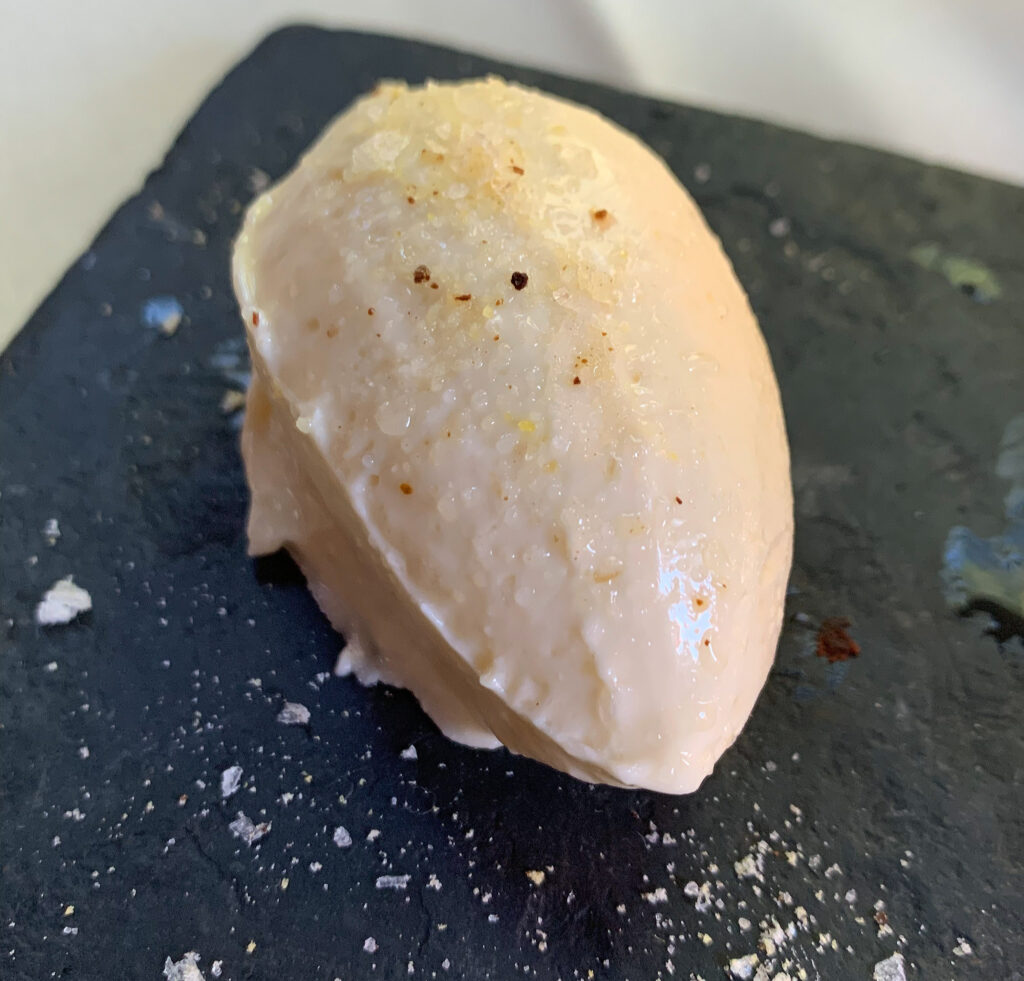
The ”Truffle-Corn Butter,” formed into a perfect quenelle, is the real star of this presentation. Topped with corn salt and tempered to a perfectly spreadable consistency, the accompaniment draws on the roll’s lasting, nuanced texture and amplifies the bite’s overall flavor. You might think, upon first encountering the butter, that it will be powerfully sweet. However, the expression of corn is decidedly savory and deep in a way that emphasizes the subtle tones of truffle and amounts to something not unlike cheesy popcorn. The only sweetness here, in fact, is drawn (via contrast) from the fennel seeds in the bread itself. What a sophisticated pairing and, truly, one of the best butters you have tasted in quite some time. It makes the whole presentation worthwhile.
Before reaching your first course, a busser appears with one last gift from the kitchen. The “Green Eggs & Ham,” as the dish is called, comprises a small lion-headed crock set within an egg carton on a leaf- and flower- strewn base. Diners pluck their respective serving—along with accompanying wooden spoon—out from its resting place, making for a charming kind of interactive centerpiece.
The ”Green Eggs & Ham” itself is composed of green beans, capers, and Cinco Jotas jamón ibérico hidden under a pale green herb hollandaise. A few tiny flowers from North Pond’s rooftop garden—an ingredient source you will see mentioned several times—complete the presentation. Texturally, the bits of green bean and caper offer an appealing, crisp crunch while the chunks of ham are softer and fattier. Each of these elements is subsumed by the remarkably airy but all-encompassing hollandaise. The sauce’s eggy richness enhances the mouthfeel of the other ingredients while blanketing them with a fresh, herbaceous flavor. This matches the grassy green beans well and allows the tangy capers and deep meatiness of the ham to assert themselves. The resulting combination is surprisingly refreshing but bolstered by savory undercurrent, making for a natural transition into the start of the meal proper. Ultimately, this makes for a fun amuse-bouche with admirable depth.
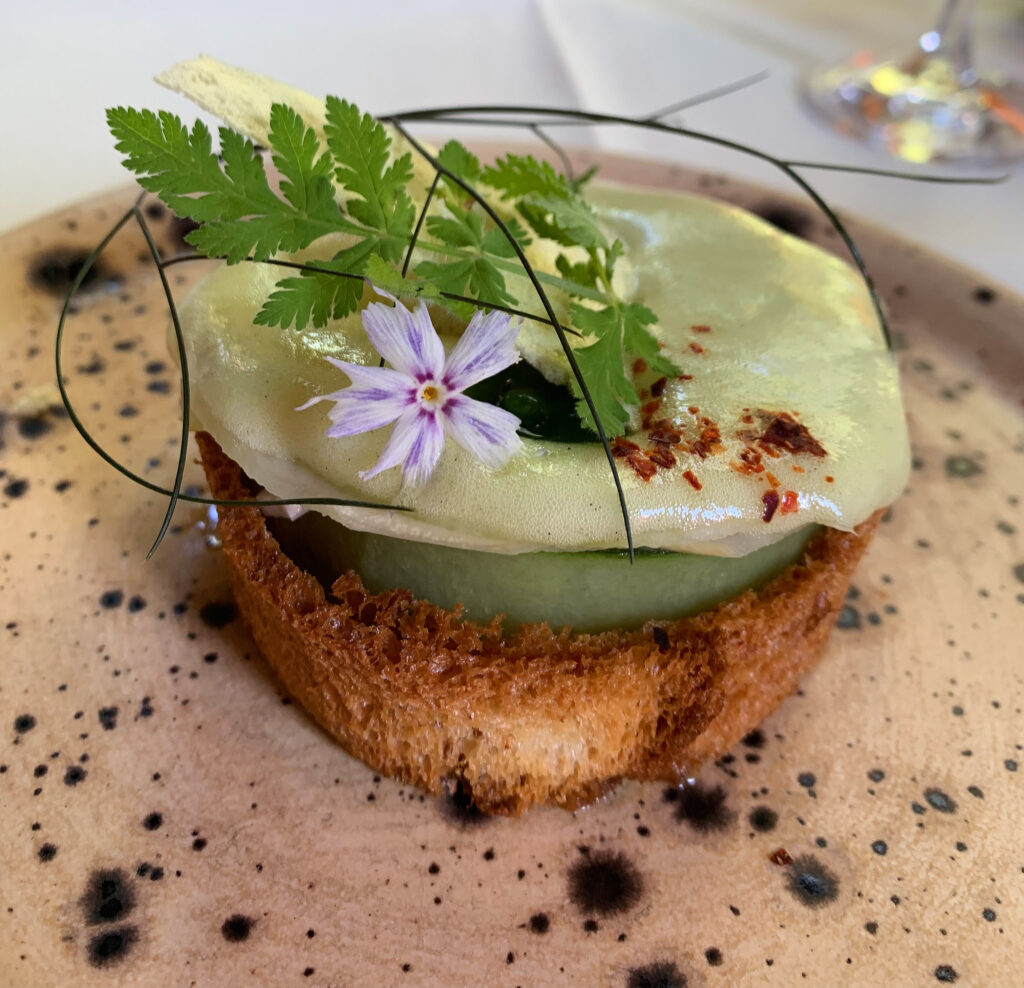
Moving on, the first item from the actual prix fixe you have sampled—being listed at the top of the “First Courses” category—is the “Cucumber, Mushroom.” While this dish sounds rather simple on paper, representing a lone vegetarian option (near-vegetarian at least) among preparations of seafood and foie gras, its construction might be the most complex of the bunch. A chilled cucumber and mushroom salad is tossed in a cucumber-jalapeño dressing, topped with smoked trout roe, and encased in a circle of crispy brioche. This combination, all neatly arranged, is topped with a bread-and-butter pickle meringue that coats the top of the dish and obscures its contents. This airy, yet self-supporting substance serves as a canvas for a topping of herbs and flowers, which lends the presentation some semblance of a dainty fruit tart.
However, attacking the dish with fork and knife, you encounter textures and flavors that are hardly shy. The brioche exterior shatters like the most perfect crouton, allowing you to segment the cucumber (wrapped within the same circular cavity), and then prick a complete bite containing those two elements along with the mushroom. On the palate, the vegetables are clean and crisp with just a bit of that refreshing, watery quality. This helps to accentuate the crunch of the bread, the pop of the trout roe, and the frothy, mouthcoating meringue. Usually, you might fear that this kind of preparation focuses too much on the pristine flavor of the cucumber and comes across as blend. Yet the bright and fruity flavor of the jalapeño dressing, combined with the sweet-and-sour character of the bread-and-butter meringue, makes for an absolutely electric combination. Supported by notes of earth, smoke, brine, and that richly bready brioche, the dish shocks you with its intensity. This is a deconstructed, reconstructed salad of great purity and finesse, making for an impressive start to the meal.
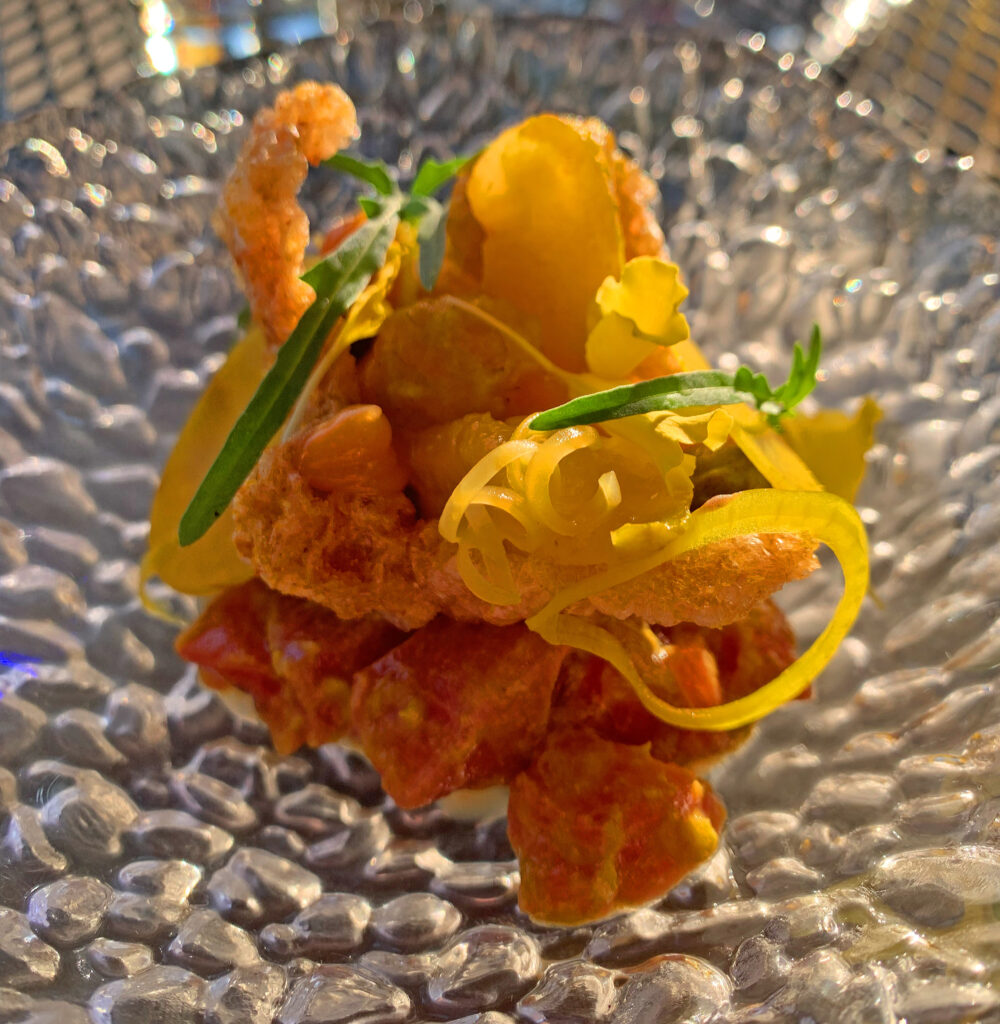
Later, the “Cucumber, Mushroom” would be replaced—in that first of the “First Courses” spot—by a “Tuna Tartare.” Such a dish, to be honest, is not even a staple in fine dining anymore. You see it all over steakhouses and other upscale à la carte concepts these days at a time when consumers, increasingly, are learning to better appreciate high-end tuna thanks to the omakase genre. Any Michelin-starred property looking to showcase the fish must do so faultless, and Murillo, you must admit, is up to the task. His version of the preparation comprises glistening chunks of blue fin tuna joined by Three Sisters black beans, golden raspberries, a wild arugula salad, some assorted flowers, and an aji amarillo chicharrón in a Shiro plum reduction. You are invited to pour leche de tigre over the dish from an accompanying carafe, ensuring that no diner’s palate is overwhelmed by what the kitchen may consider to be a reasonable amount.
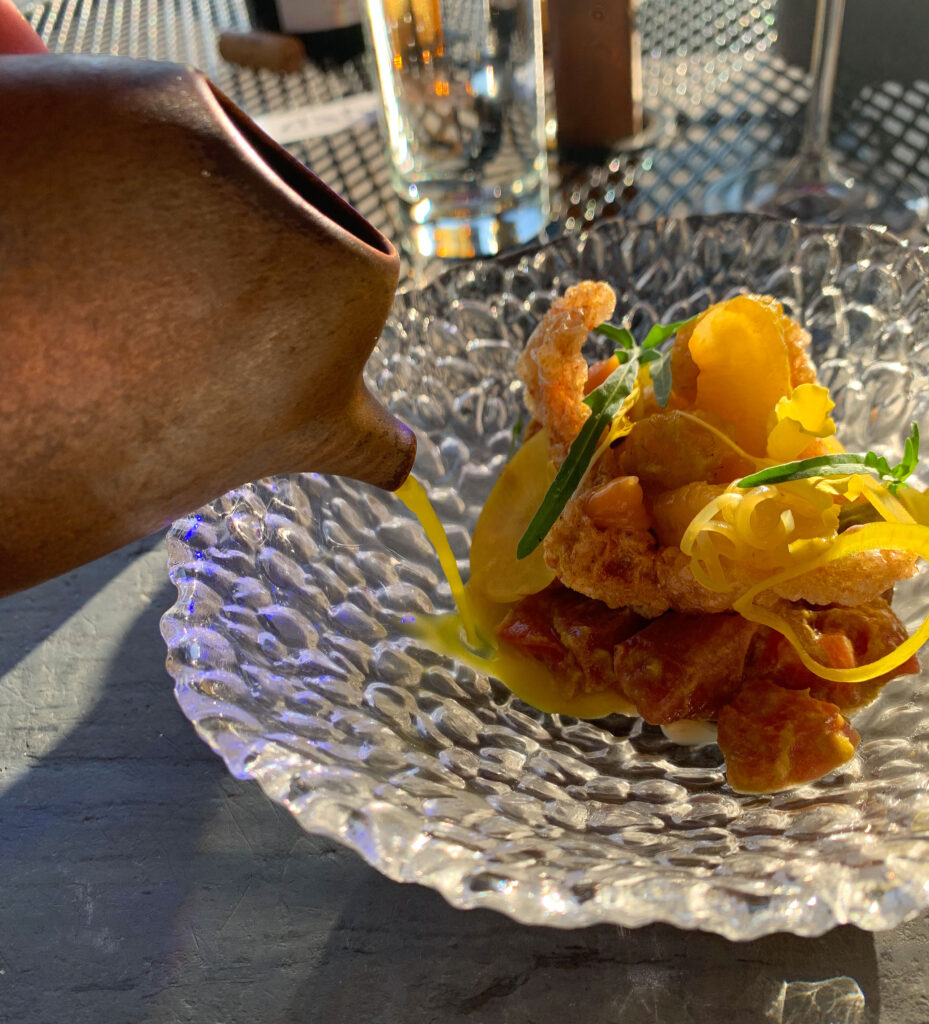
Diving in, the dish looks rather pretty with its warm tones of yellow, off-white, and faded red contrasted by the slightest burst of green in a pebbled crystal bowl. You find the chicharrón, puffed in the manner seen at places like The Aviary and Ever, to be a bit difficult to cut at first. However, rearranging some of the other ingredients provides you with the leverage required to shatter the crispy pork. Upon doing so, it is easy to scoop it—along with the tuna, the beans, and a golden raspberry—to compose a full bite. On the palate, the blue fin, despite being so generously cut, is perfectly tender. It melds naturally with the smooth black beans before the plump berries and crunching chicharrón come to the fore.
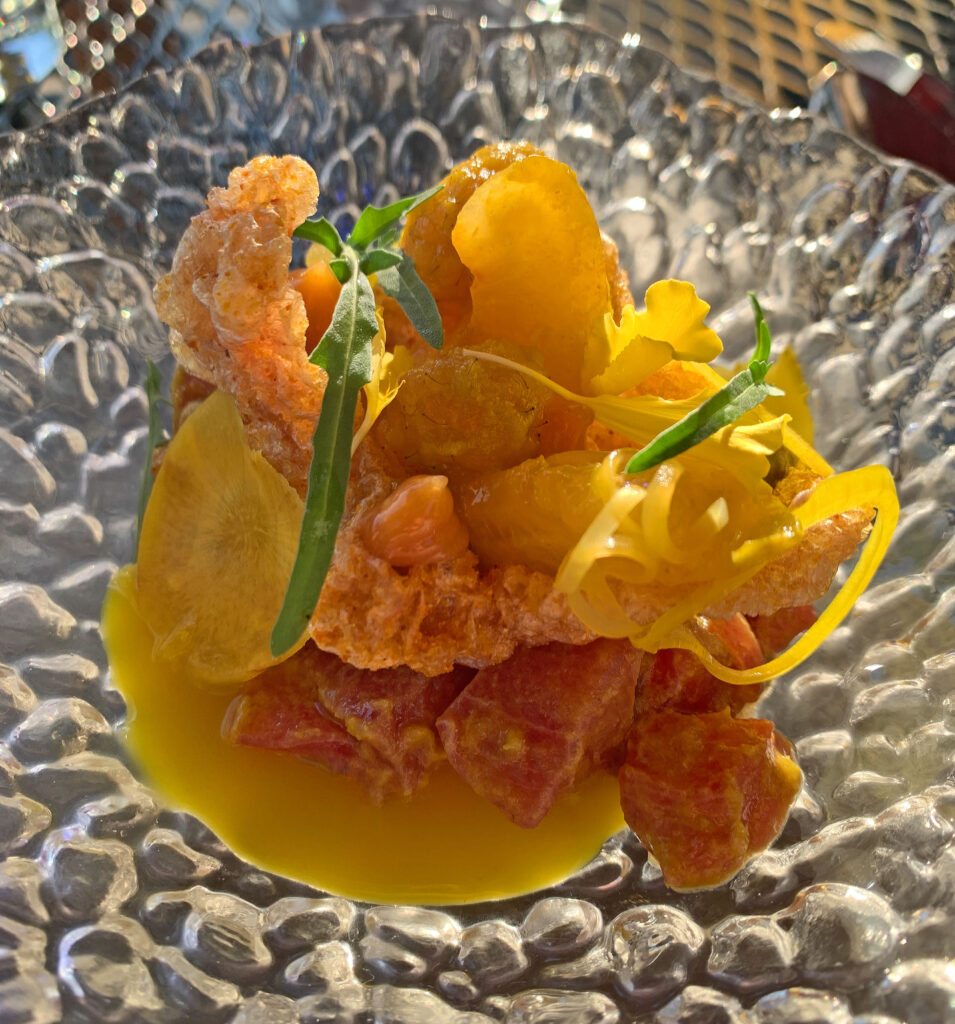
Nonetheless, it is really in terms of flavor that the dish shines. On entry, the tuna’s latent umami is accentuated by the rounded sweetness of the Shiro plum and the (only mildly tart) golden raspberry. The fruity tones of the aji amarillo help, too, to build complexity while the subtly nutty black beans and peppery arugula add a savory dimension to the fish. Overall, the level of acidity here is rather mild. But, upon introducing the leche de tigre (and, yes, you pour every drop from the carafe), the entire preparation is supercharged. The marinade’s intense citrus notes help to counteract all the sweetness and imbue the tuna with a bright, lip-smacking quality that carries through the minutes-long finish. This all makes for a showstopper of a dish—perhaps the very best of its kind in Chicago—and an absolute dream pairing with an acid-driven white wine. Bravo!
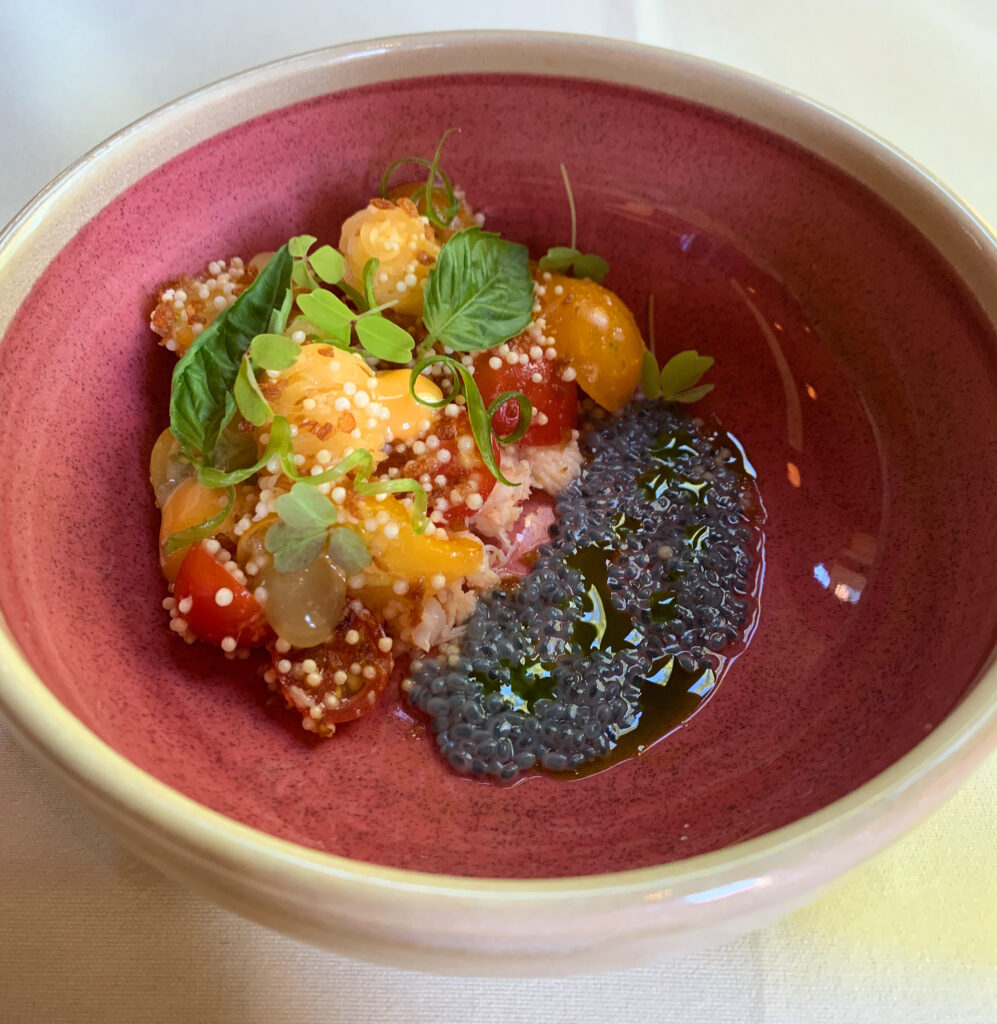
Moving on, the “Tomato, Crab” has occupied the second spot within the “First Courses” category across each of your three visits. In terms of titling alone, you like how the dish subordinates its use of “Busan” crab (typically a smaller kind of horse crab) to that of the Nichol’s Farm tomatoes: a clear expression of the North Pond philosophy that puts seasonal produce ahead of totemic luxury products sourced from further afield. Both of these ingredients are tossed in a ginger dressing. Otherwise, the bowl is composed of basil seeds, basil oil, masago arare (crispy rice pearls), and a green tomato “chip.”
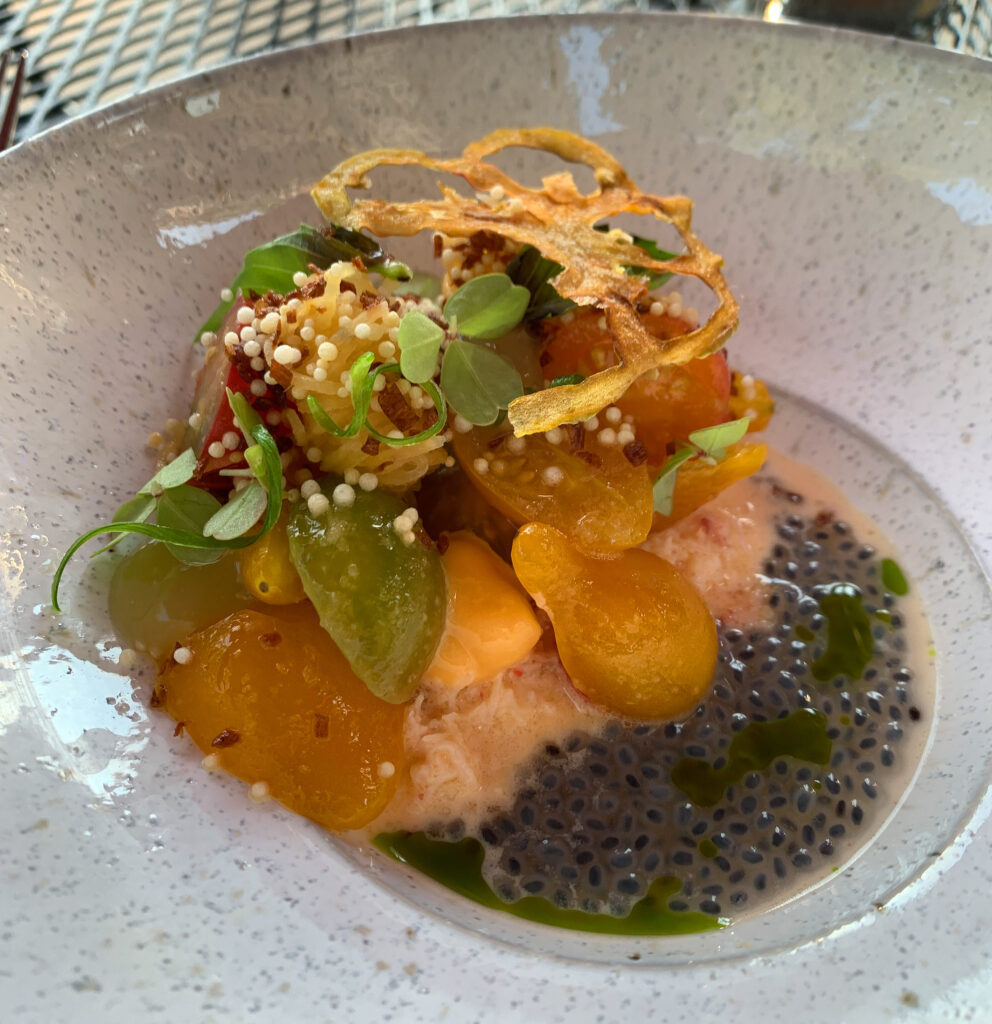
Approaching the dish with your spoon, it is easy to compose a bite. You get one of the plump, bursting halves of tomato coated with the crunching pearls of rice and the more finely crisp basil seeds. The crab, rendered as many small threads of meat, is soft and luscious while that green tomato chip, whenever you decide to incorporate it, is beautifully brittle. In terms of flavor, the tomatoes—as suggested—take center stage with their acidity and subtle sweetness. The sharpness of the ginger and faintly floral basil seeds form a fitting complement. The crab itself offers a little sweetness of its own; however, you might like it to show a bit more intensity (maybe through the utilization of something like crab stock). That being said, all the elements blend effortlessly together and serve to showcase the titular produce. This celebration of seasonal tomatoes, utilizing inventive accompaniments, is a quintessential expression of the North Pond style. It represents a nice effort (even if it is missing that last touch to truly be memorable).
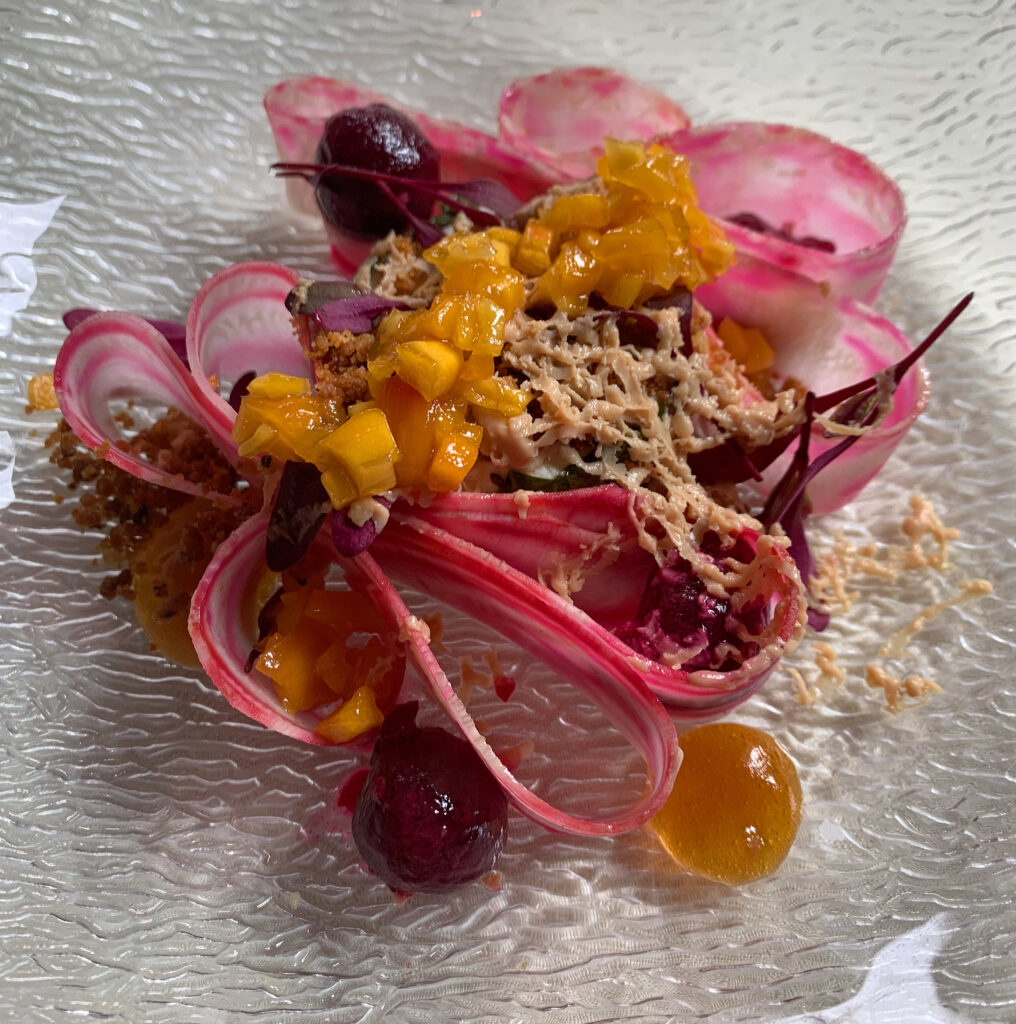
The last of the opening courses you have sampled across your visits is the “Foie Gras, Ricotta.” Seemingly, such a preparation has little to do with the restaurant’s focus on seasonality. The combination of housemade ricotta cheesecake with horseradish streusel, mango pickles, and a “snow” made from the duck liver reads like something out of the molecular gastronomy playbook. Nevertheless, it is the beets from Michigan’s Werp Farms—rendered as streaming ribbons and globules of sauce—that actually dominate the plate.
Approaching the dish, you are tasked with segmenting these long, continuous shavings of beet in order to compose your individual bites. Doing so naturally serves to mix the other elements together. Principally, the moist ricotta cheesecake and melting foie gras snow come to coat the shavings of root vegetable. The ribbons also get dragged through those globules of concentrated beet “sauce.” Thus, when a bite finally reaches your tongue, the glossy chunks of mango pickle and crunchy bits of horseradish streusel (playing the role of a graham cracker crust) give way to something unique. The crisp, subtly earthy, and mildly sweet beet feels as if it is being seasoned by the rich and creamy combination of ricotta and foie gras. The liver’s meaty undercurrent emphasizes the savory character of the vegetable while the sharp, sour, and sweet notes of the toppings and sauce ensure the dish still feels decadent. The preparation feels rather involved, and it is not quite hedonistic in the way you might expect when you read “cheesecake.” However, the ingredients join together cohesively and impart a flavor that is true to the classic foie gras and fruit combination while also emphasizing the freshness of the beet. Ultimately, this dish is more intellectual than you would ever guess but still rather pleasing. Impressive.
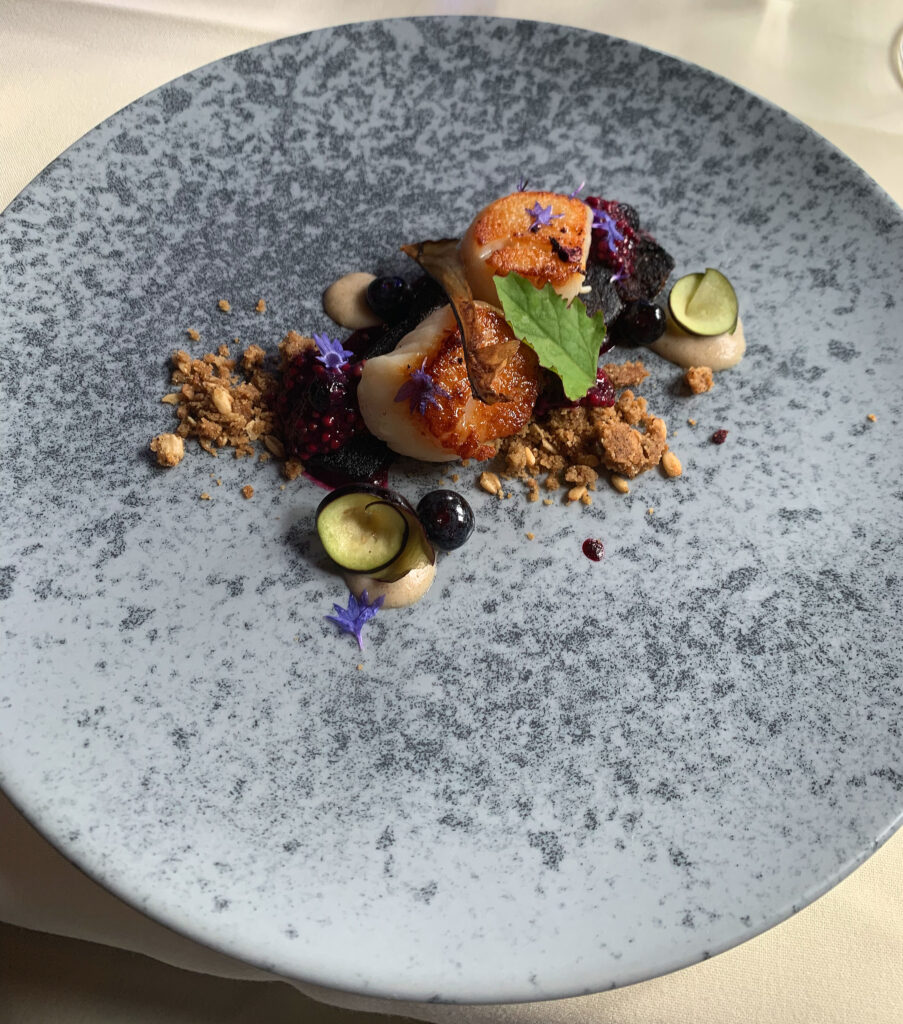
Turning toward the “Second Courses,” you begin with the “Scallop, Eggplant.” It’s a dish that, unlike the “Tomato, Crab,” seems to emphasize its titular mollusk more than the supporting nightshade. And, visually, that holds true. The bivalves, sourced from Hokkaido, are pan seared and display a perfect, golden-brown crust. They sit atop the eggplant—“Jerry’s” eggplant (in seeming reference to its grower)—which is smoked until it has turned black and wrinkled. Surrounded by a blueberry mostarda and obscured by the scallops, the nightshade is almost hard to discern. Otherwise, the plate is dressed with an oat and black pepper crumble, a couple slices of raw eggplant, a few whole blueberries, and those same tiny flowers from the restaurant’s rooftop garden.
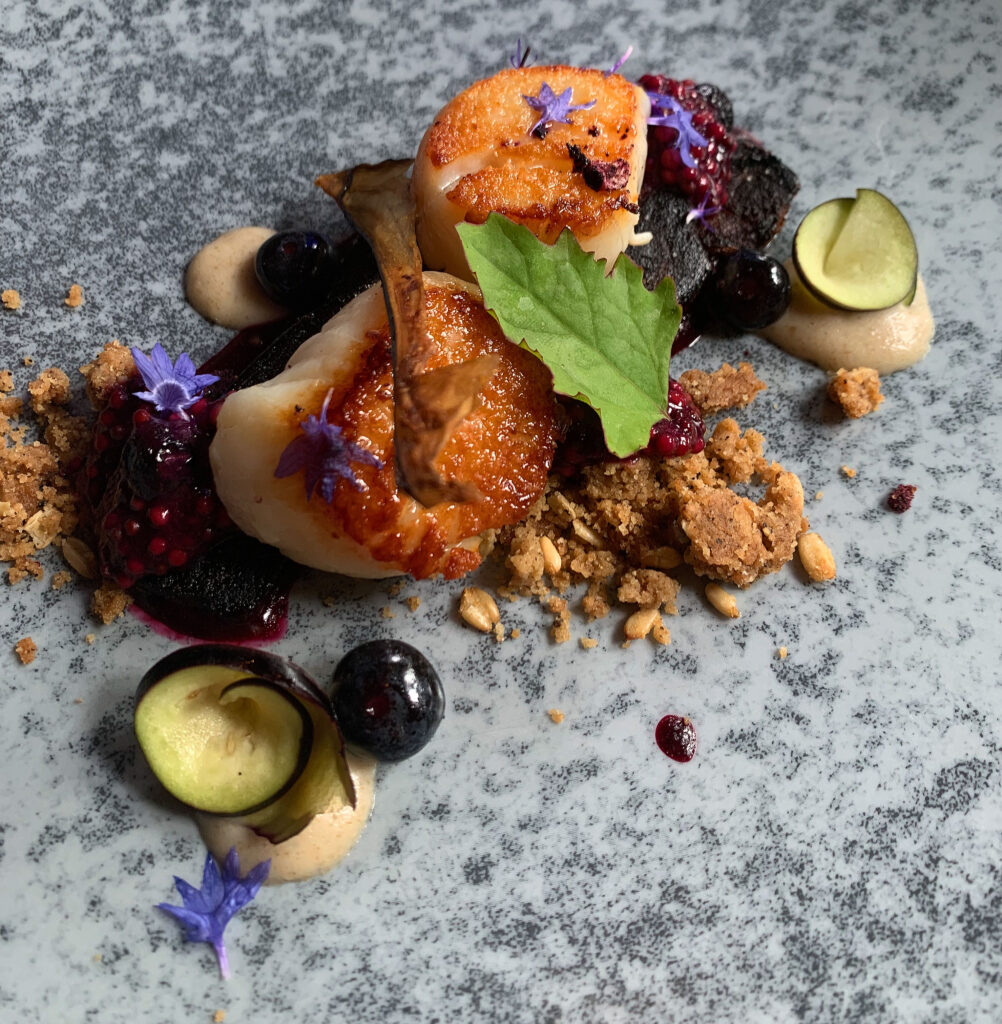
Using fork and knife, you slice through one of the mollusks and reveal its glistening interior. The eggplant, just the same, crackles as you cut it apart but feels soft and moist on the inside. Taken together, with a coating of the mostarda and some bits of the crumble, the combination offers a quintuple-decker texture with alternating crisp and tender layers that are nicely executed. Though the scallop, in truth, displays just a bit more firmness than the eggplant, the latter element—once you have chewed on the bivalve—melds perfectly and offers an amplified sense of meatiness. In terms of flavor, the blueberry mostarda seems like a bold choice on paper, yet its concentrated fruity and tangy notes are moderated by the nightshade’s hints of char and smoke. This, combined with the traces of oat and black pepper, lends the dish a complex savory character that draws out the scallop and eggplant’s own latent sweetness and emphasizes that textural sense of meatiness. Seared scallops are hardly novel when it comes to fine dining, but this is a unique composition that utilizes its seasonal component well to provide a delicious expression of its star ingredient.
The next dish offered in the “Second Courses” category, across each of your visits, has been the “Harold’s Risotto.” This preparation represents the next in a long line of risottos (like “Red-Wine Risotto,” “Butternut Risotto,” and “Potato-Leek ‘Risotto’”) that have been offered at North Pond since the early days of Diaz and Sherman. The dish is named after Harold Wilken, farmer and co-owner of Janie’s Mill, whose grains (what look to be a kind of whole wheat berry) replace the traditional rice in Murillo’s recipe. Otherwise, the dish comprises fava beans from the restaurant’s rooftop, slices of zucchini, a Marcona almond mousse, a black truffle jus, and some smoked vegetable “dust”—which is grated tableside from a carbonized brick made out of the kitchen’s dried and smoked vegetable trimmings.
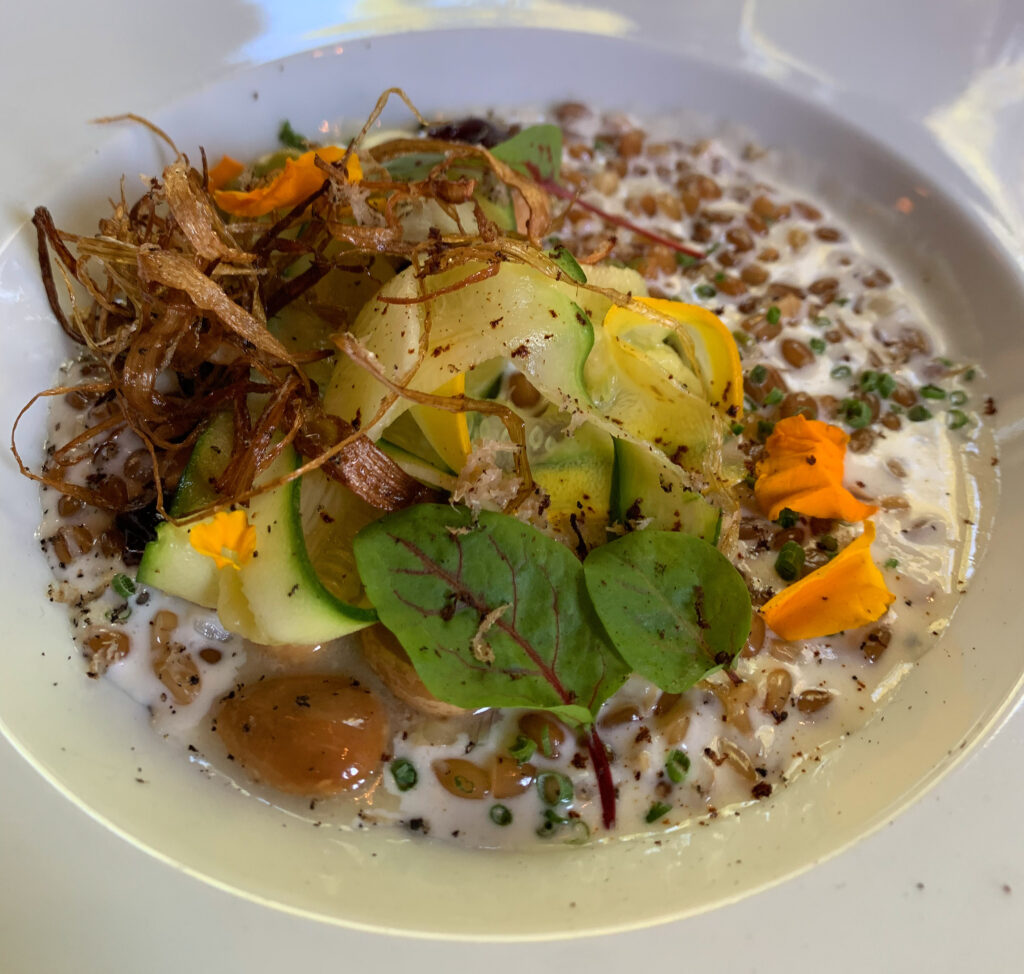
Visually, “Harold’s Risotto” looks the part of a verdant, comforting summer rice dish. The grains, peeking out from the creamy mousse, promise a delectable, al dente mouthfeel. But—and you can only say this on the basis of one encounter with the preparation—this risotto is probably the weakest item on the menu. The combination of Marcona almond mousse and black truffle jus sounds delicious in theory, but these elements are rendered in a manner that is far too fluid. They lack any weight or richness and, instead, work to emphasize the too-firm quality of the grains. Their overriding flavor, likewise, is tangy but lacks adequate nutty depth. By comparison, the fava beans are pleasantly soft, and you think the vegetable dust is an interesting addition (especially as a means of celebrating what would otherwise be considered waste product). However, the fundamentals of the dish fall flat and sink what might otherwise be an interesting idea. While not disastrous to the point of being unpalatable, “Harold’s Risotto” does not deliver on the expectation of a risotto (or, more simply, on the kind of pleasure this kind of course, orthodox or not, must deliver).
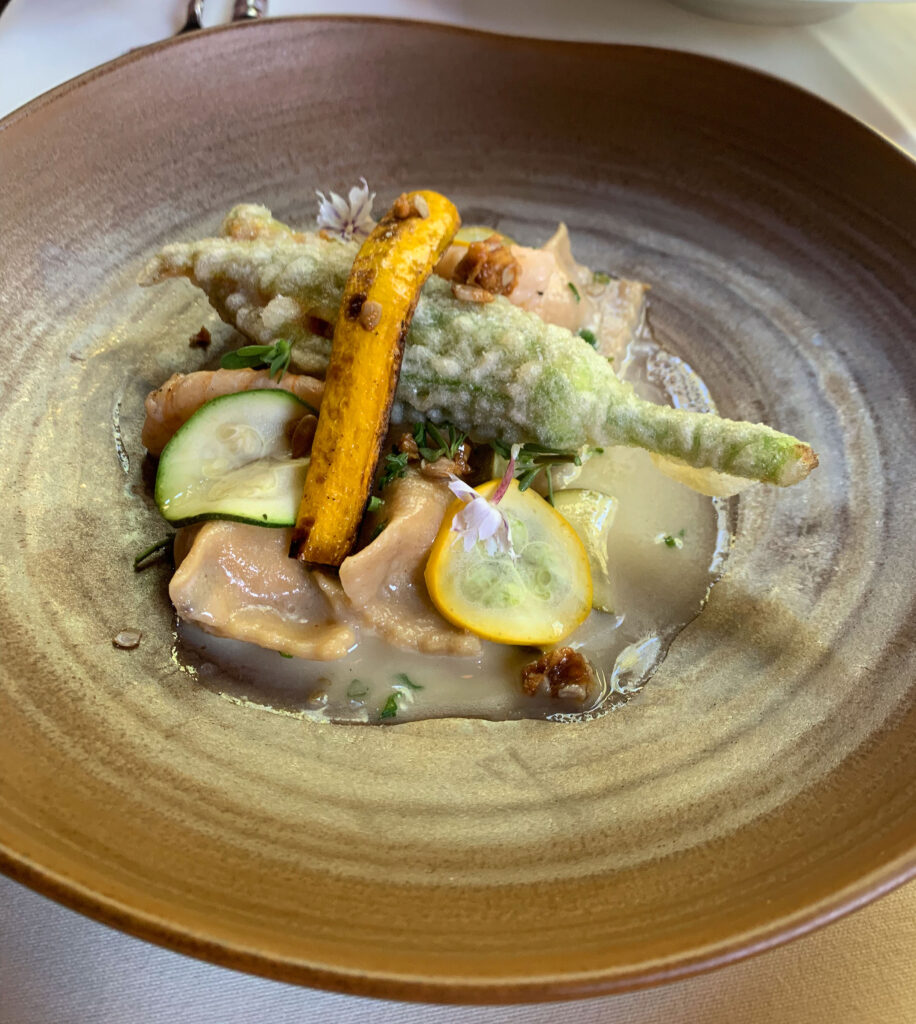
Thankfully, Murillo’s take on pasta—a form that, even more than risotto, represents one of the cores of North Pond’s identity—fares much better. His “Agnolotti, Squash Blossom” does not only represent one of the best dishes on the menu, but stands as one of the best examples of the form in Chicago (even rivaling the work of the city’s foremost experts). The chef forms his pasta—rendered as two long, ribbed pockets—out of toasted masa (a nixtamalized corn flour) and fills them with a combination of daylily and ricotta. The squash blossom is stuffed in the same manner and then fried. Both components are joined in the bowl by a long segment of roasted summer squash, a few slices of raw summer squash, a couple prawns (harvested by someone named “Grover”), some chunks of sunflower seed brittle, and a sauce of maple-sunflower cream.
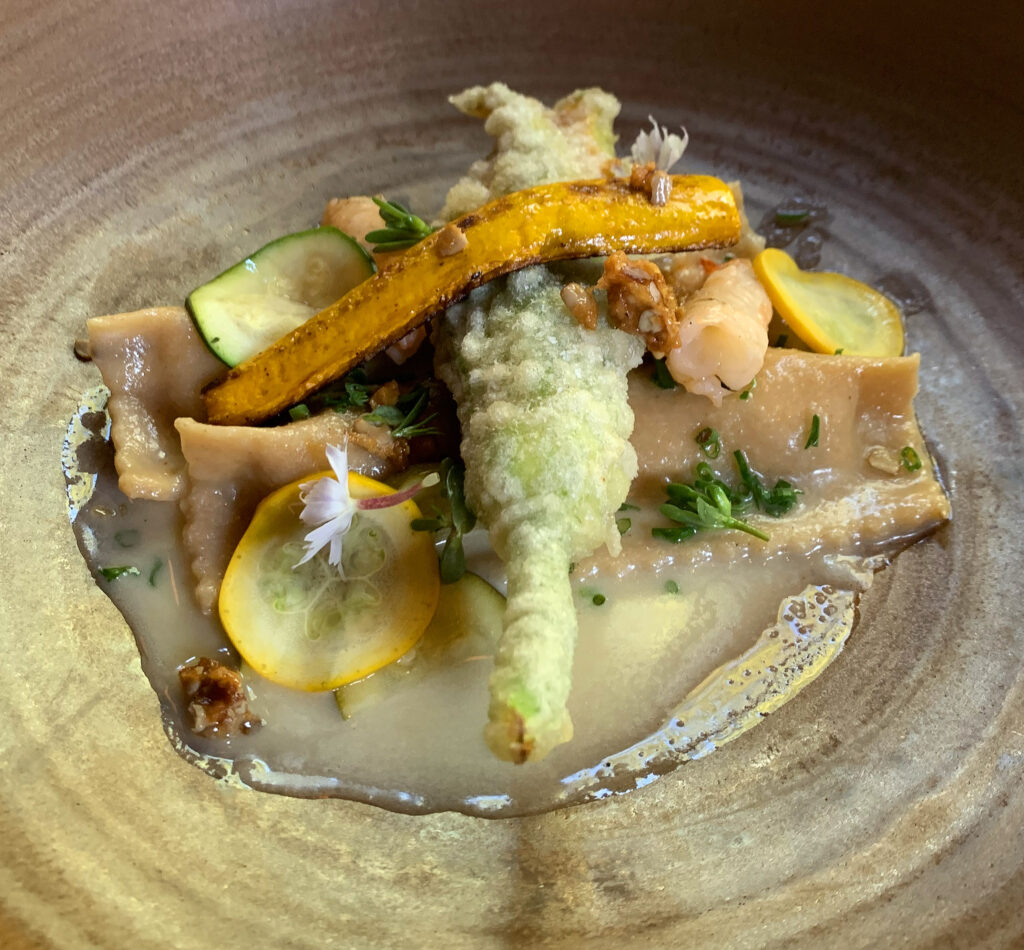
Diving in, the squash blossom breaks apart cleanly upon meeting your knife while the agnolotti, in turn, shows a faint degree of firmness before yielding. On the palate, the textures are much the same. The crisp coating of the blossom and al dente chew of the pasta mingle nicely as both elements release their creamy cheese filling. The roasted and raw pieces of squash, when incorporated, provide a heartier snap while the prawns are plump and juicy against your teeth. Of course, the sunflower seed brittle is the crunchiest component when it finds its way into the mix. Yet it is from this engaging interplay of textures that a superlative flavor takes hold: tangy ricotta combined with sweet daylily and maple, the nutty tones of the masa and sunflower seed, with buttery notes of the prawn bolstered by the creamy sauce. Yes, as disappointing as the “Harold’s Risotto” was, the “Agnolotti, Squash Blossom” fulfills all the comforting sweet and savory notes you desire from this kind of plate. There’s also a wonderful persistence here that ensures the pasta gets better and better with each bite.
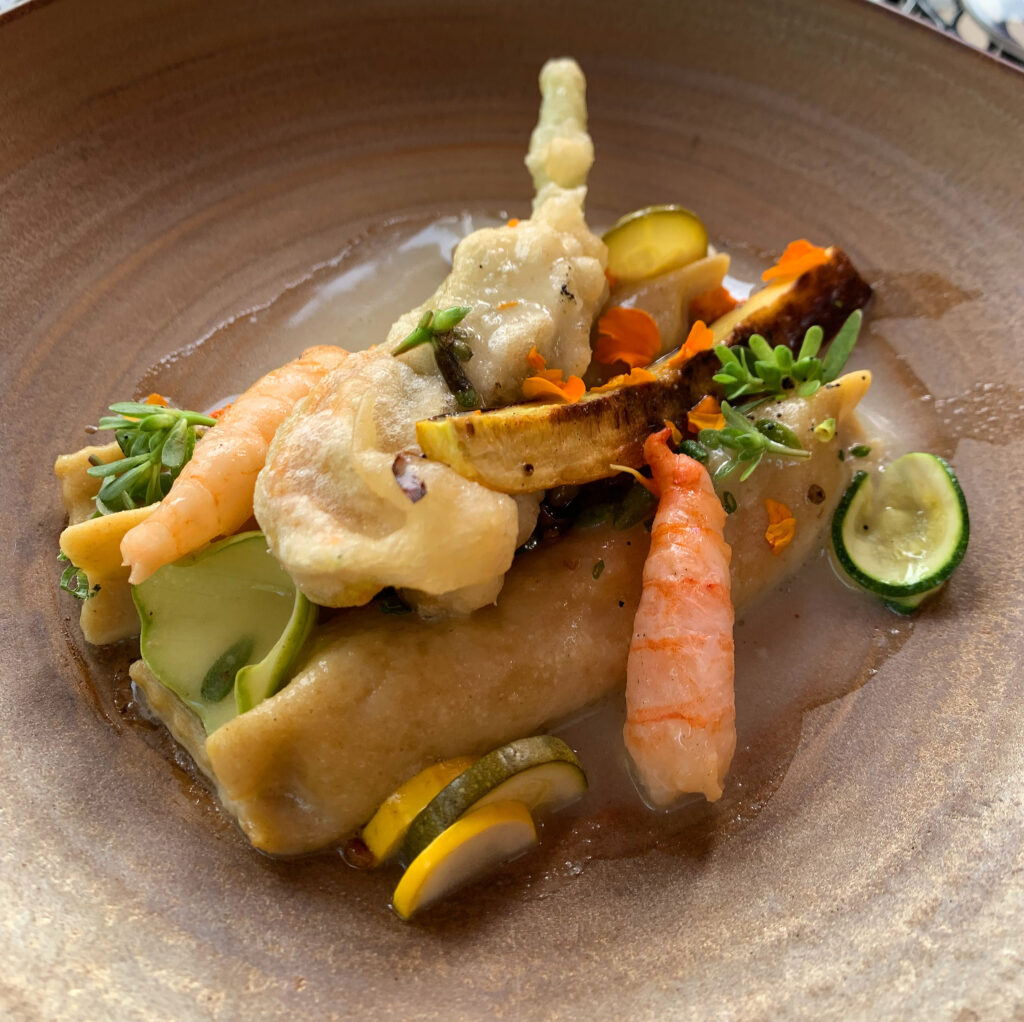
You must admit, however, that this dish was less enthralling the second time you encountered it—the squash blossom being a bit limp and the sauce less flavorful—and seemed simply “good” rather than transcendent. Such an inconsistency is concerning, but the chef still deserves credit for crafting a pasta that plays in the big leagues when executed properly.
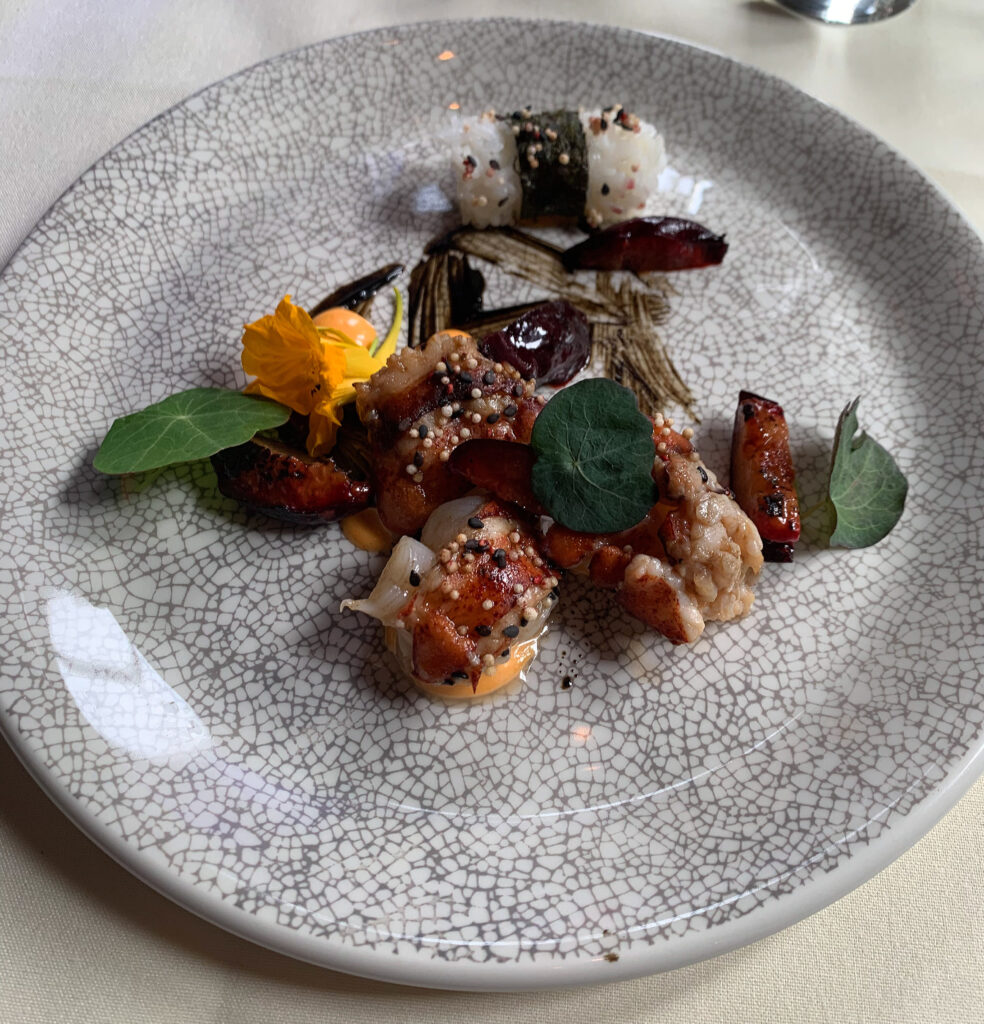
Between the “Second Courses” and the “Main Courses,” you come to the aforementioned $40 supplement: “Lobster.” While somewhat pricey in relation to the $125 prix fixe itself, this offering allows Murillo to showcase a totemic luxury ingredient (as a verbal special) without upsetting the turnkey nature of the written menu. What’s more, the chef really unleashes his creative juices when working with this coveted crustacean. The lobster is not treated like a superfluous bauble but, rather, stars in a composition that is every bit as involved as the plates already covered. Listening to your server describe the intricacies of the supplement, it becomes clear that this is something more than a mere butter-poached tail.
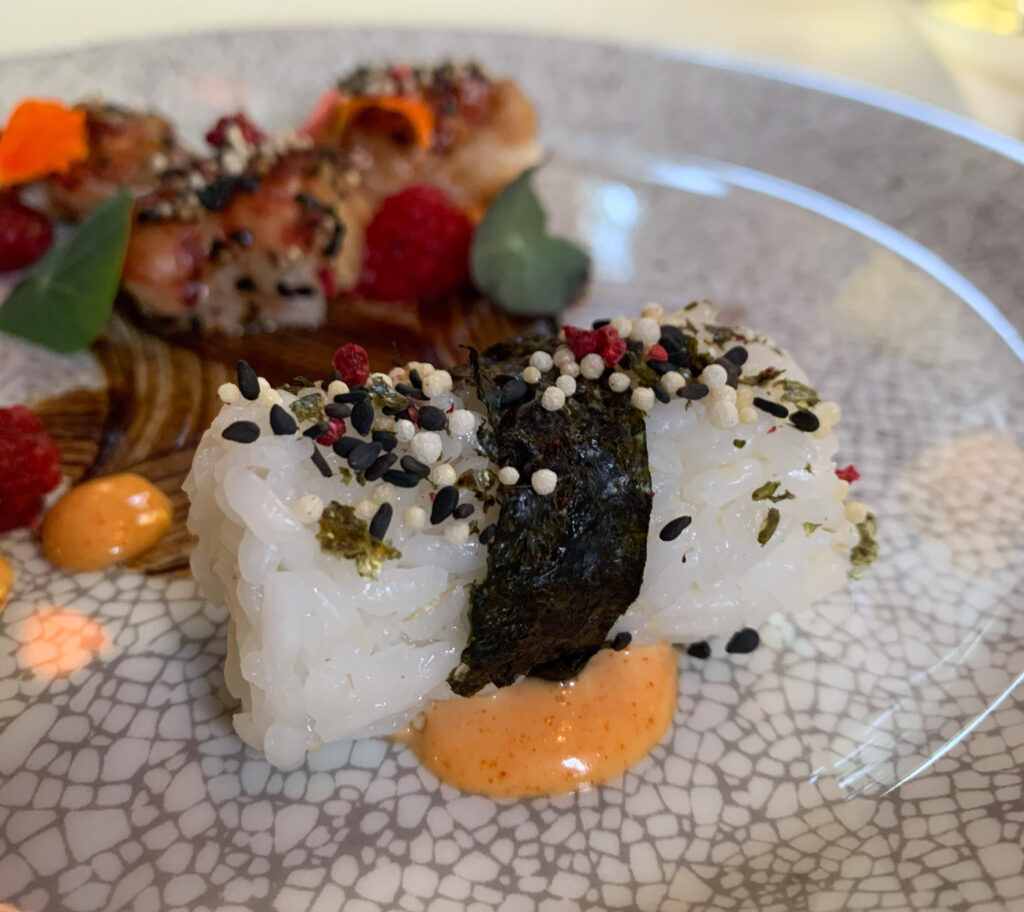
That being said, butter still has a part to play. Murillo grills his lobster, sourced from Canada and comprising what amounts to a six- or seven-ounce portion, with a coating of yuzu butter. He then places three chunks of the crustacean on a plate that has been brushed with black garlic purée. They are topped by crispy rice pearls and joined by globs of tomato aioli, slices of radish, segments of charred apricot (later substituted for raspberries), and a couple pads of nasturtium. Finally, off to the side, you find a tightly formed rectangle of sushi rice wrapped in nori.
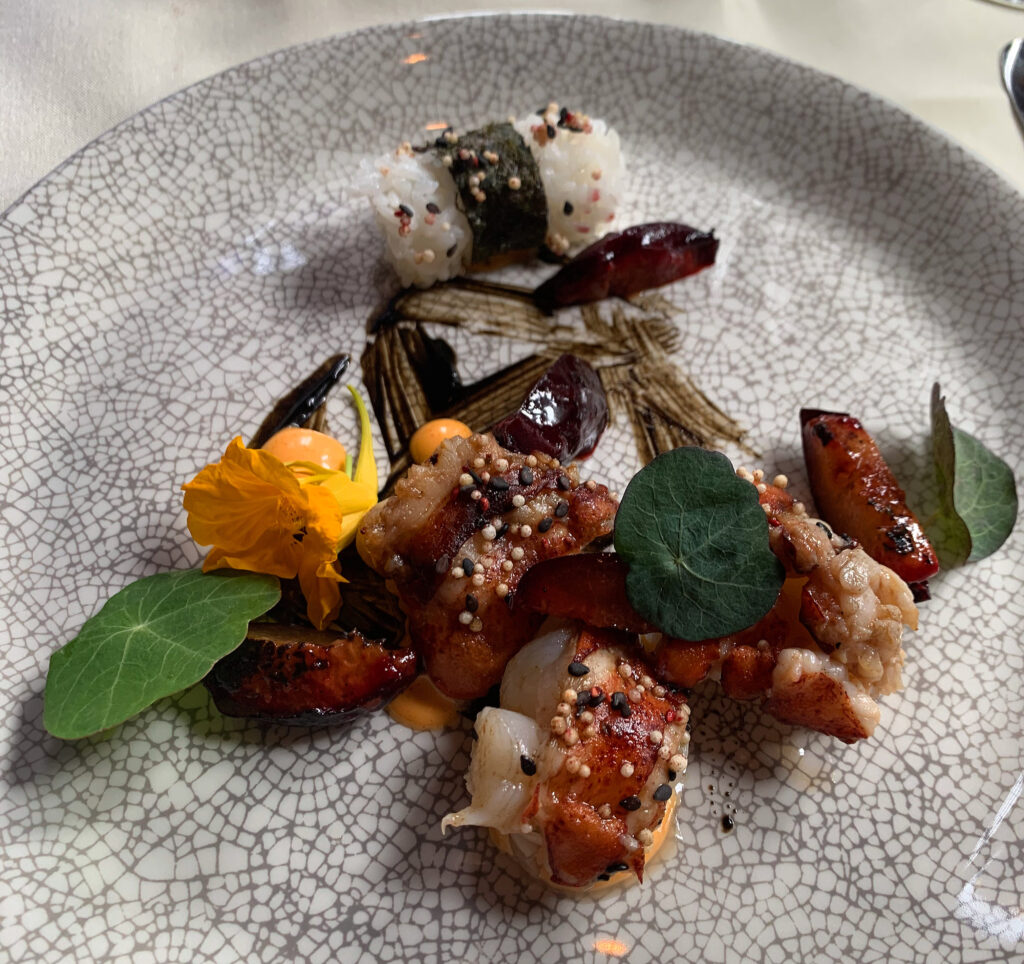
Approaching the dish, you first cut off a piece of the lobster and drag it through one of the brushstrokes of purée. The crustacean displays a subtle crunch and hint of firmness from the char on entry but reveals itself to be rather lightly cooked, retaining a pleasant sense of chew, with further mastication. You actually prefer this somewhat raw quality, which yields a pristine sweetness in the meat and allows the concentrated umami of the black garlic to really hit home. From this foundation, elements like the yuzu, apricot, and raspberry impart a burst of acid with a fruity-sweet quality that underlines the lobster’s own character. The tomato aioli is a bit more rounded and savory (complementing the black garlic beautifully) while the nasturtium offers a harmonizing peppery note. The sushi rice, to be fair, could be just a bit softer. However, it is adequately seasoned with vinegar and allows you to absorb some of the dish’s bolder flavors while increasing its overall sense of sustenance. In sum, this is a rewarding supplement that uses its star ingredient inventively without forgetting the need to satisfy those who take the $40 plunge. It is not quite a “can’t miss” offering, but you would still rank it among the best dishes on the menu. Well done.
Moving on, at last, to the “Main Courses,” you begin with what seems to be the pescatarian option. However, Murillo’s “Rainbow Trout, Corn” is much more than that. Yes, the dish centers on a perfect, pan-seared fillet of the titular fish, which is topped with a colorful summer succotash. But, mirroring the rainbow trout, you find one long Carmen pepper—referred to as “Jerry’s” Carmen pepper in honor of Jerry Jimenez, owner of Darn Hot Peppers family farm in Cobden, Illinois. This Italian heirloom variety, also known as the Corno di Toro (or bull’s horn), comes stuffed with Cahokia rice (grown in McClure, Illinois), roasted, and garnished with slivers of pickled okra. Finally, a corn cream—presented in a husk-wrapped carafe then poured tableside—completes the presentation.
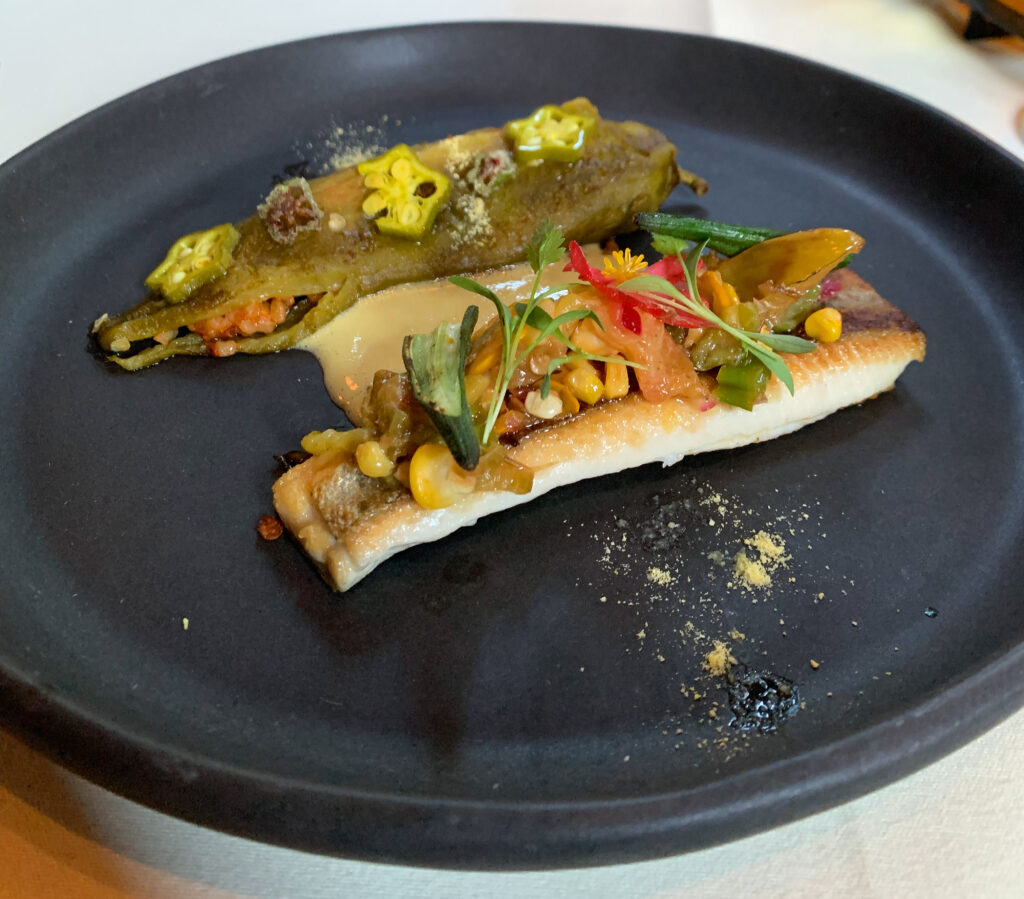
Taking your knife to the trout, you are impressed by its gentle flake. The flesh separates effortlessly from the larger fillet, allowing you to drag each bite through the accompanying cream without upsetting the components of the succotash that sit atop it. On the palate, the fish feels plump and meaty with a subtly crisp outer layer of skin and a juicy interior. The crunching bits of corn and squash add a degree of textural intrigue. More importantly, it is their sweetness—bolstered by the corn cream—that accentuates the pristine, nutty notes of the trout. The resulting combination is bold and delicious without overshadowing the delicate fish, and you would count the dish as successful based on this element alone.
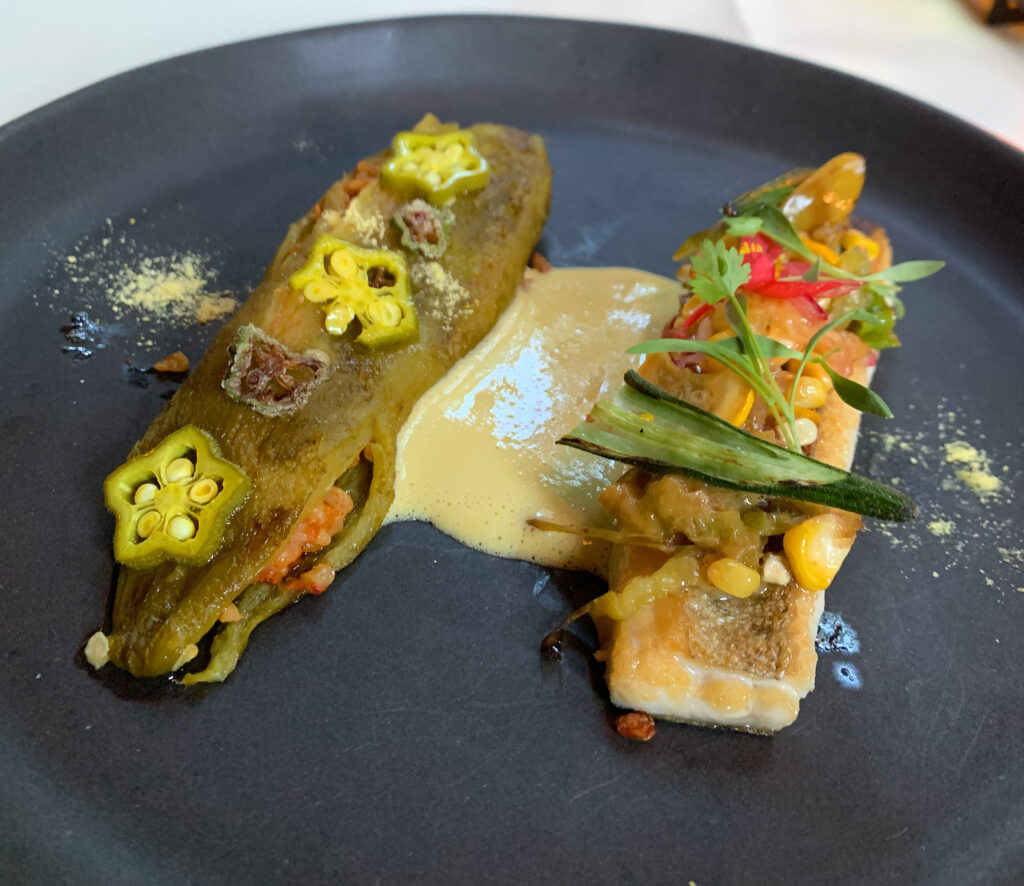
Nonetheless, turning toward that Carmen pepper, you find it also separates cleanly upon encountering your knife. Piercing its skin with your fork, you drag the rice-stuffed bull’s horn through the corn cream in the same manner as the trout (making sure not to disturb the crowning slice of okra). On the palate, the pepper displays a fleeting firmness and crispness (augmented by the crunch of the pickled component) that quickly yields to soft, comforting grains of rice. The robust, earthy quality of the Cahokia variety helps to balance—along with the fresh tang of the okra—the combination of sweet pepper and sweet cream. The resulting sensation is, as with the fish, decidedly savory but offers a lingering, hedonistic finish drawn from the corn’s natural sugars. Ultimately, both the trout and stuffed pepper excel individually and, joined by the creamy sauce, complement each other nicely. This is the rare kind of pescatarian preparation that does not leave you wanting for flavor but, quite the opposite, may actually make carnivores at your table jealous. It represents a great effort.
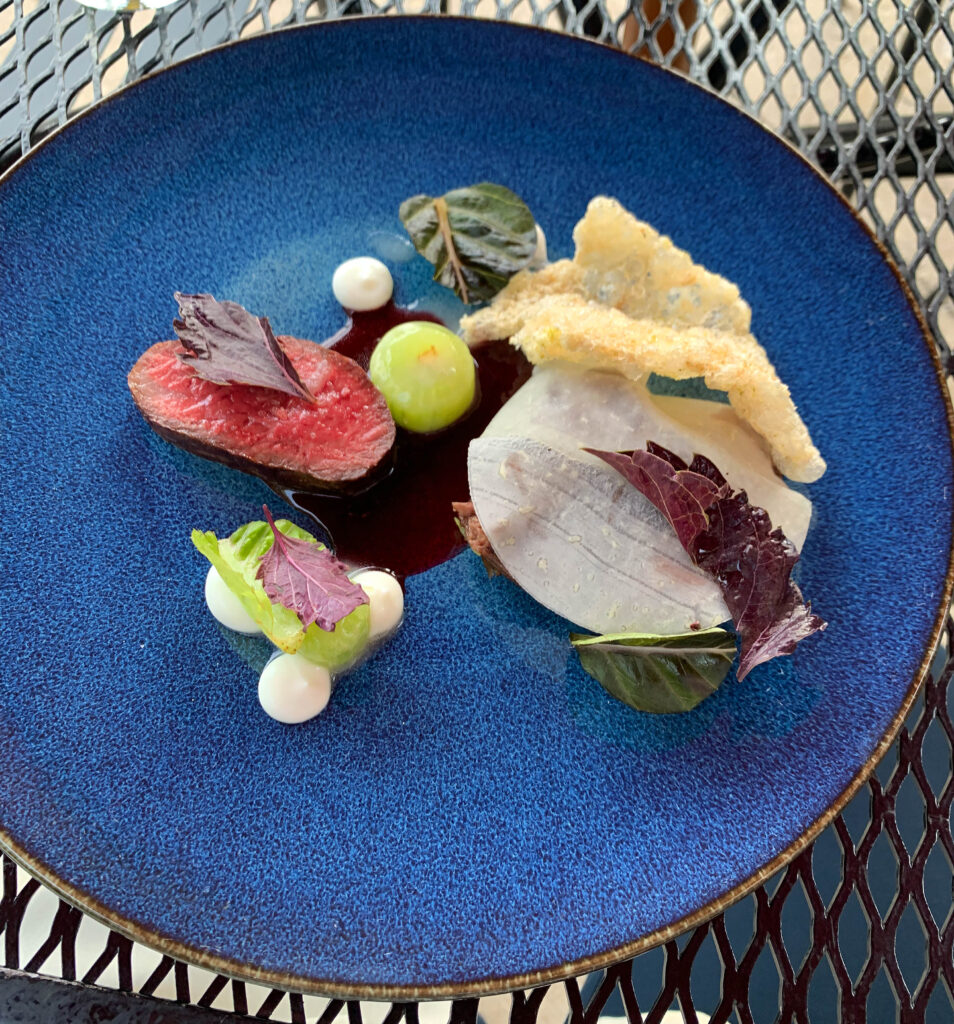
All that being said, North Pond’s more carnivorous patrons have nothing to be worried about. The next of the “Main Courses,” titled “Wagyu, Celtuce,” is actually quite satisfying. You even say that as a longtime critic of those ubiquitous A5 Miyazaki striploins—gossamer servings of that one totemic luxury ingredient chefs love to use as a crutch but that, so often, falls short of delivering what steak lovers really want. Murillo does not reveal exactly where the wagyu is from. However, the chef does indeed serve a cut of striploin that is joined by a piece of puffed tendon in a manner that can only remind you of his time working for Curtis Duffy. The beef is joined by a couple glistening chunks of the celtuce (also known as stem lettuce), some globules of buttermilk cream, and a drizzle of shiso sauce. Yet, it is underneath a thin piece of radish paper that you discover the preparation’s star attraction: a generous portion of braised beef cheek.
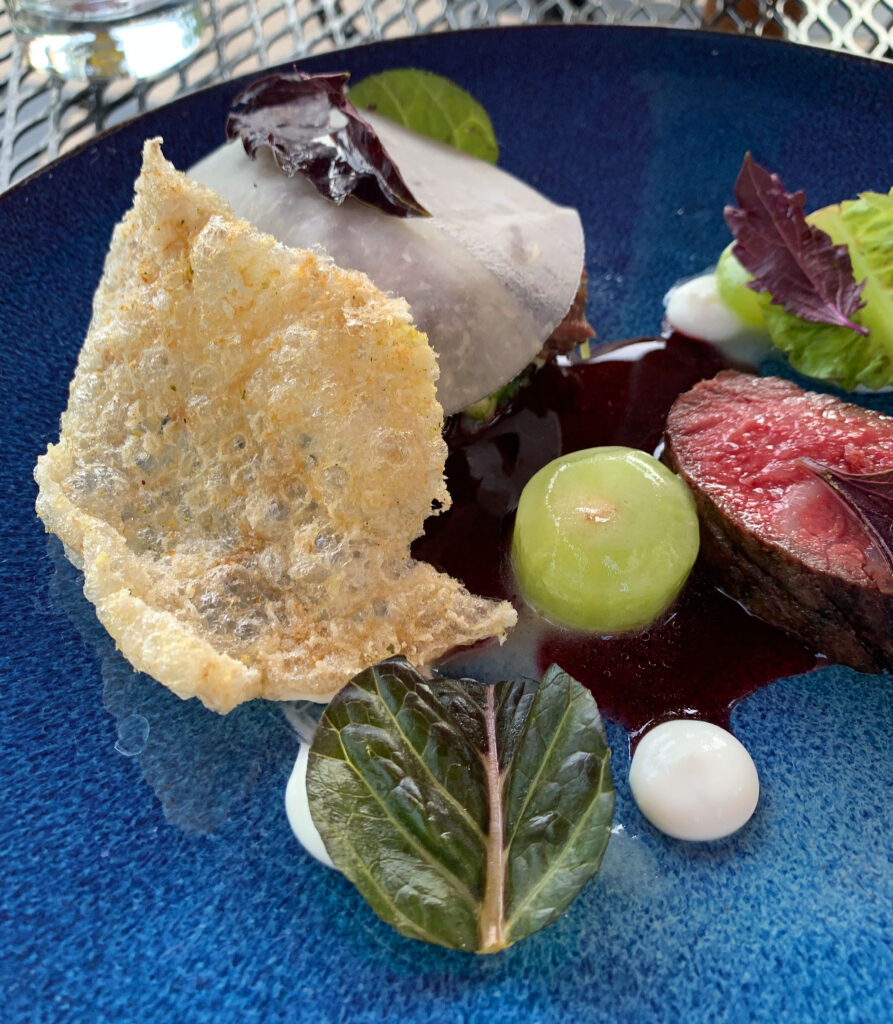
Slicing into the striploin, you are impressed by its marriage of a firm, well-seared exterior and a totally juicy interior. The meat, otherwise, does not appear marbled to any extreme amount but remains nicely tender with enough of a chew to actually feel substantial. Much of the dish’s flavor is drawn from that shiso sauce, which ostensibly features its namesake bright and minty herb but offers all the savory power of a Bordelaise. The rich and tangy buttermilk cream, when incorporated, adds to the pleasure. But the celtuce, despite its starring role, is rather cucumber-like and only faintly nutty. It crunches and serves almost as a cleansing presence rather than providing any decisive flavoring. Likewise, while the puffed tendon is texturally pleasing, that is the limit to its thrill.
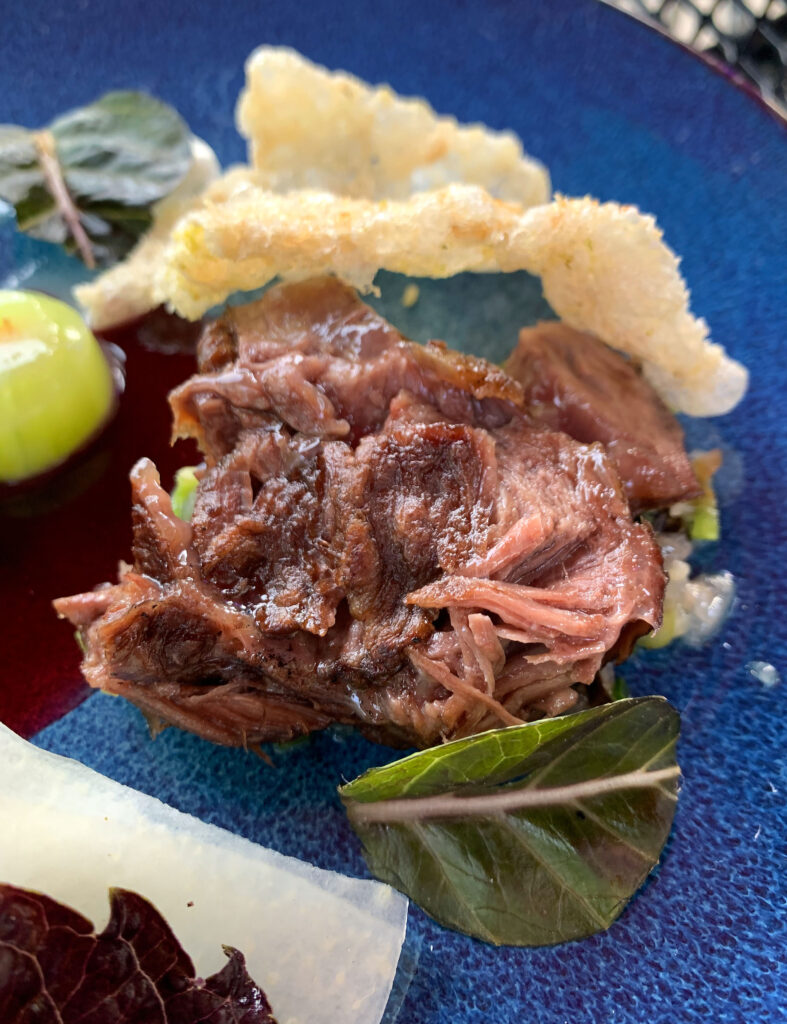
Nonetheless, when you unveil the braised cheek meat and take your first bite, time stops. As good as the striploin is, this portion of the beef is so concentrated in its juiciness and so richly flavored that it puts the wagyu to absolute shame. Coated with a bit of that same shiso sauce, the cheeks achieve a degree of decadence that surpasses just about any traditional steakhouse steak (to say nothing of its dainty fine dining doppelgänger). In the end, you are not sure if it is Murillo’s intention to upstage the striploin with this hidden element, but both cuts of beef certainly impress. Some of the other supporting ingredients, by comparison, seem a bit superfluous (incorporated, no doubt, for the sake of seasonality). Still, the “Wagyu, Celtuce” is the rare dish of its kind that will actually please fine dining skeptics. It demonstrates the chef’s ability to expertly prepare beef and, moreso, to tap into the essential, carnal desire that should always be satisfied when offering the same animal protein as everyone else. Well done.
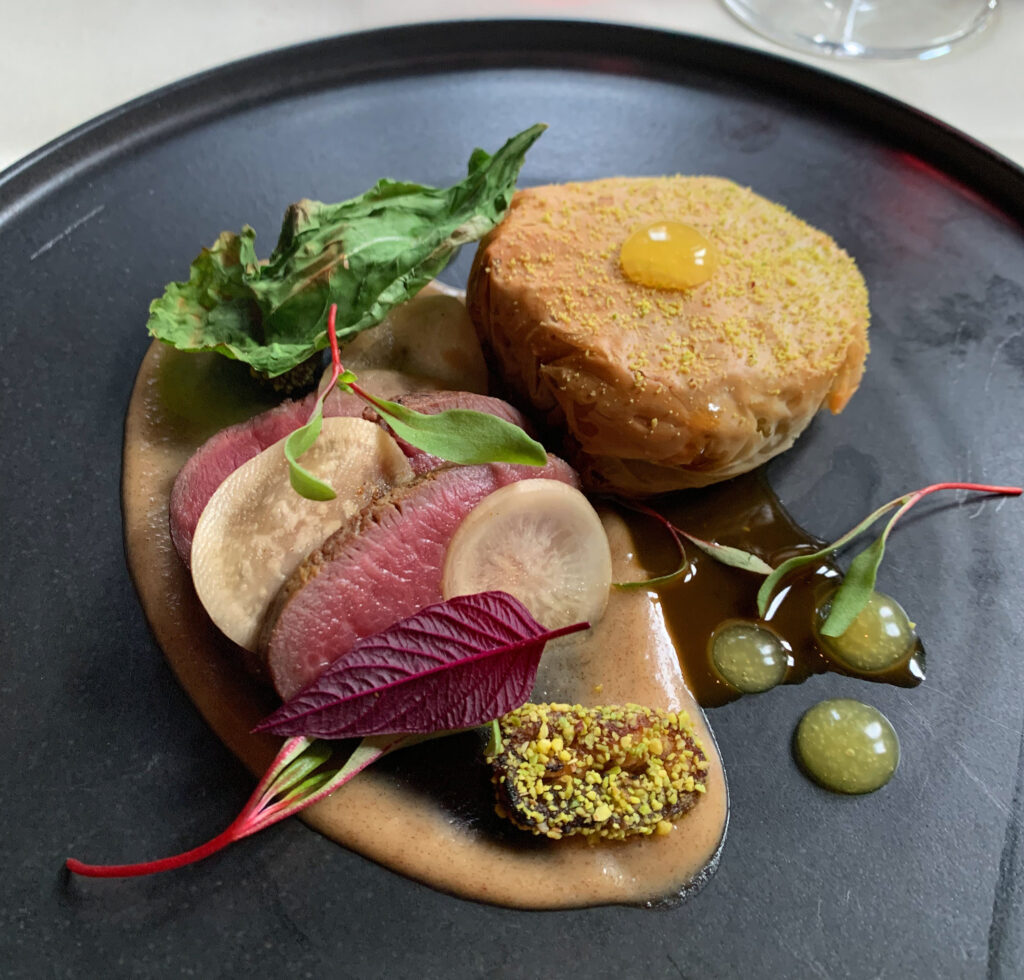
The last of the “Main Courses” ups the carnivorous ante one degree further by delving into game. “Lamb, Date,” as the dish is called, focuses on a few pieces of spice-rubbed loin that are blanketed by slices of Hakurei turnip and paired with a pastilla (or North African pie) filled with the same meat. These elements sit atop an amlou (a type of Moroccan spread made, in this case, from toasted pistachios and honey) that has been laced with a drizzle of lamb jus. Finally, a few dots of orange blossom gel and a couple of those titular charred dates, coated in ground nuts, complete the presentation.
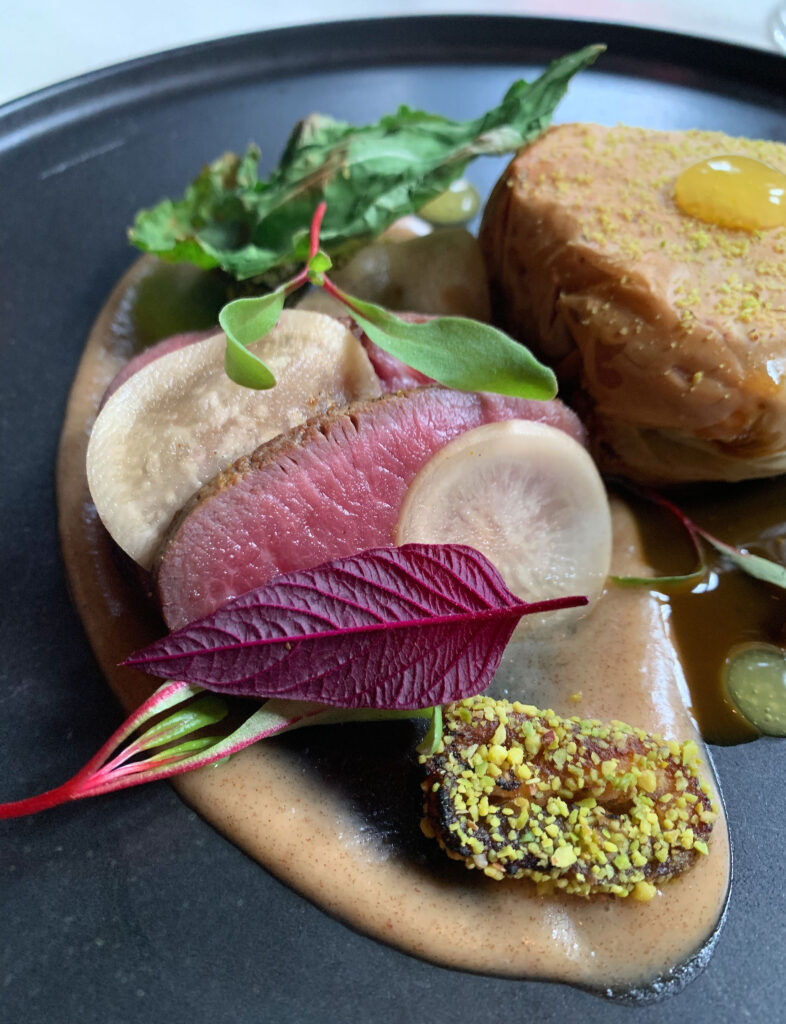
Much like the wagyu striploin, the lamb loin displays a gorgeous gradient going from its slightly crisped exterior, to the faint gray of the immediate subcutaneous flesh, to the glistening red of its center. Blanketed by one of the turnips, the meat is crisp, then firm, and increasingly tender as you chew through it. The lamb’s spice rub is decidedly warm in the classic North African style and works nicely with the robust flavor of the flesh. The Hakurei turnip—a bit like the celtuce—is crunchy and cleansing, yet it contains a subtle natural sweetness that works well with the combination of pistachio and honey as well as with the more floral orange blossom gel. The same goes for those charred dates: beautifully chewy with a candied expression of fruit that acts as a flavorful glaze for the lamb.
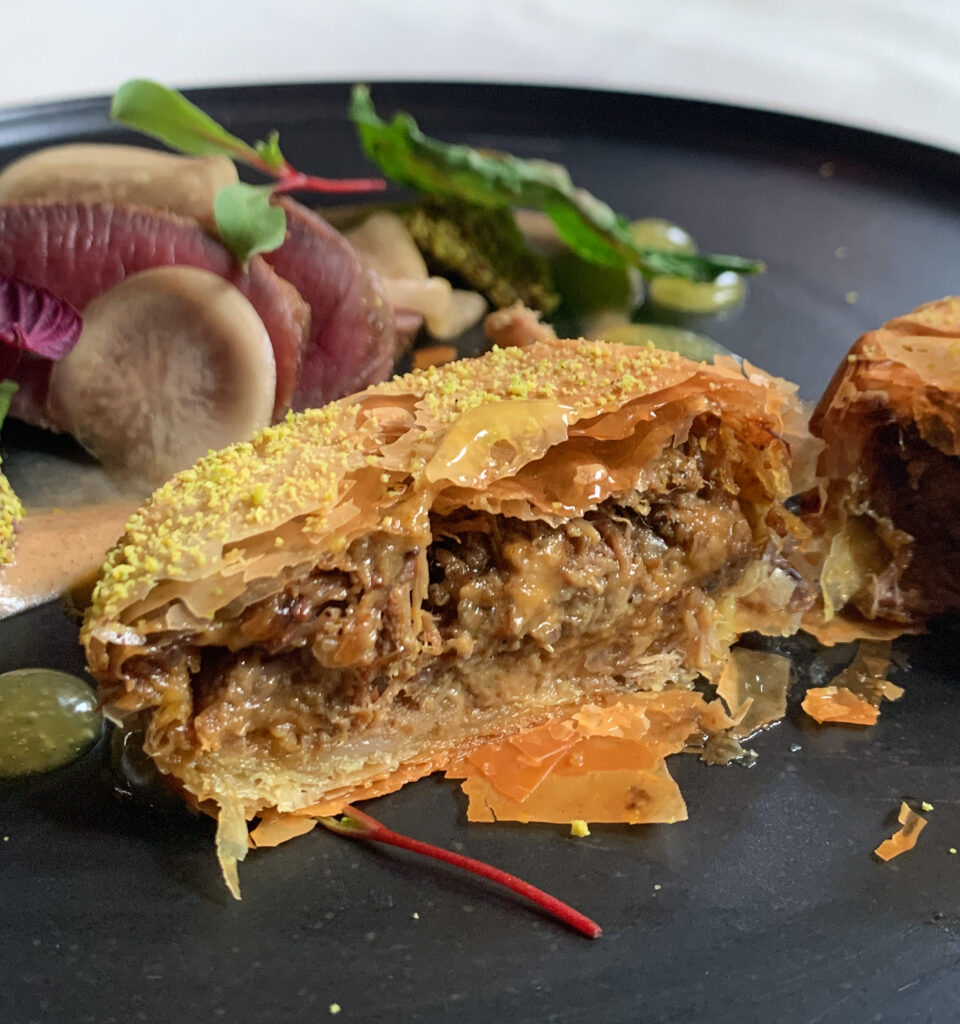
Each of these ingredients harmonize in a manner that might be called conventional. However, shattering through the flaky phyllo of the pastilla and revealing its moist meat filling strikes you just as powerfully as unveiling the beef cheek did. Compared to the straightforward chew of the lamb loin, this savory pie offers crispy, buttery, melt-in-your-mouth textures that build to a sweet, nutty, and also expertly spiced flavor experience. In that sense, the pastilla really acts as a microcosm of all the elements seen elsewhere on the plate but concentrates and refines their essence into a perfect package. Thus, after enjoying a heartier bite of loin, turnip, date, and sauce, you can find in the pie a contrasting texture that actually works to underscore all the same flavors. This back and forth between the two preparations of lamb is more engaging than the interplay of wagyu striploin and beef cheek, whose supporting ingredients lacked a bit of personality. The pastilla, by comparison, boldly wraps the entire preparation up with a bow: bringing its diverse threads together in a way that feels streamlined and sublime. While each of the “Main Courses” clearly have their charms, the “Lamb, Date” might—by a hair—be the winner.
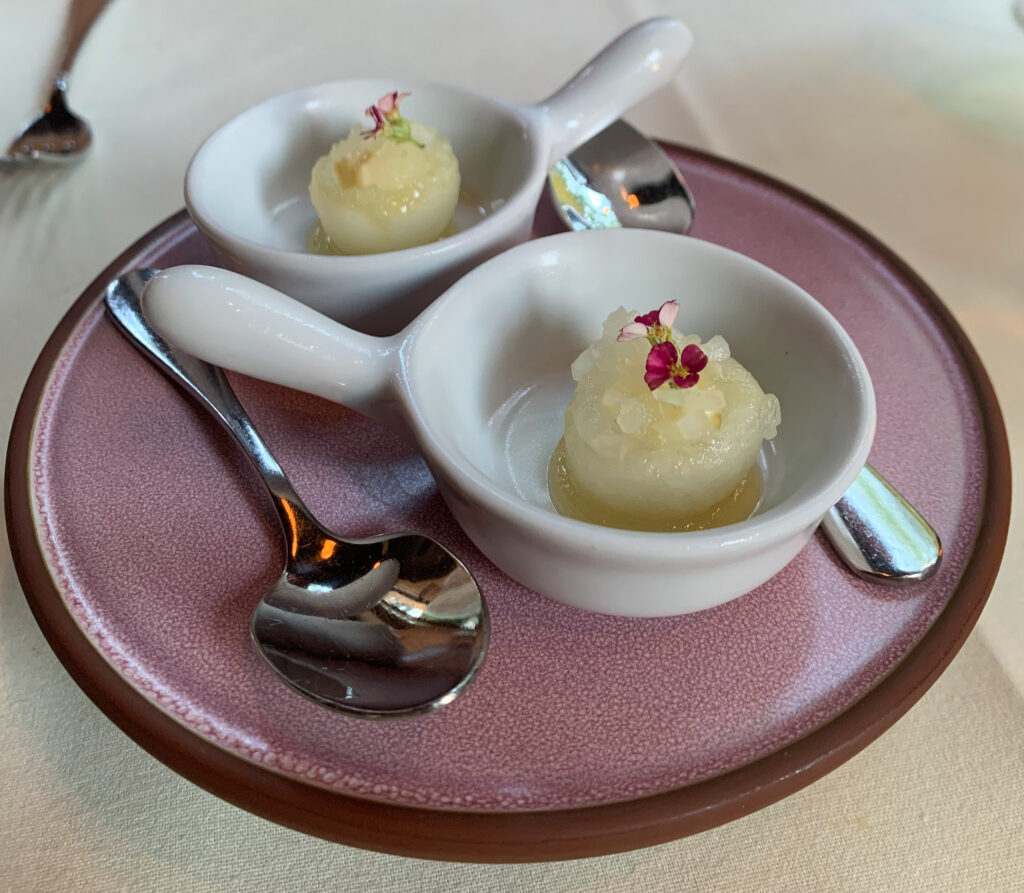
Turning toward the “Desserts,” Thomasson starts by tantalizing guests with a palate cleanser before they receive their chosen dishes. This, at present, takes the form of a tiny ball of Korean melon (the very same fruit Murillo drew upon as part of his opening “Tepache”) that is filled with honey sorbet and that sits atop a small dollop of honey cream (both utilizing product drawn from the restaurant’s rooftop beehives).
The bite, topped with those ever-present tiny flowers, is pleasantly dainty. Approached with your spoon, the melon breaks apart cleanly and can then be dragged through the bottom layer of cream. On the palate, the fruit feels crisp and clean against your teeth before yielding to the melting shards of ice and its thick, sticky coating. The melon’s flavor, likewise, is only subtly sweet and a bit musky. However, the double dose of honey—especially that drawn from the cream—is wonderfully intense. These notes supercharge the character of the fruit and carry on through a lasting finish. Overall, this makes for a refreshing transition with enough concentration to shine in its own right. The bite not only bookends the melon flavor from the beginning of the meal but leaves you with the perfect glimpse of the greater sweetness that is soon to come.
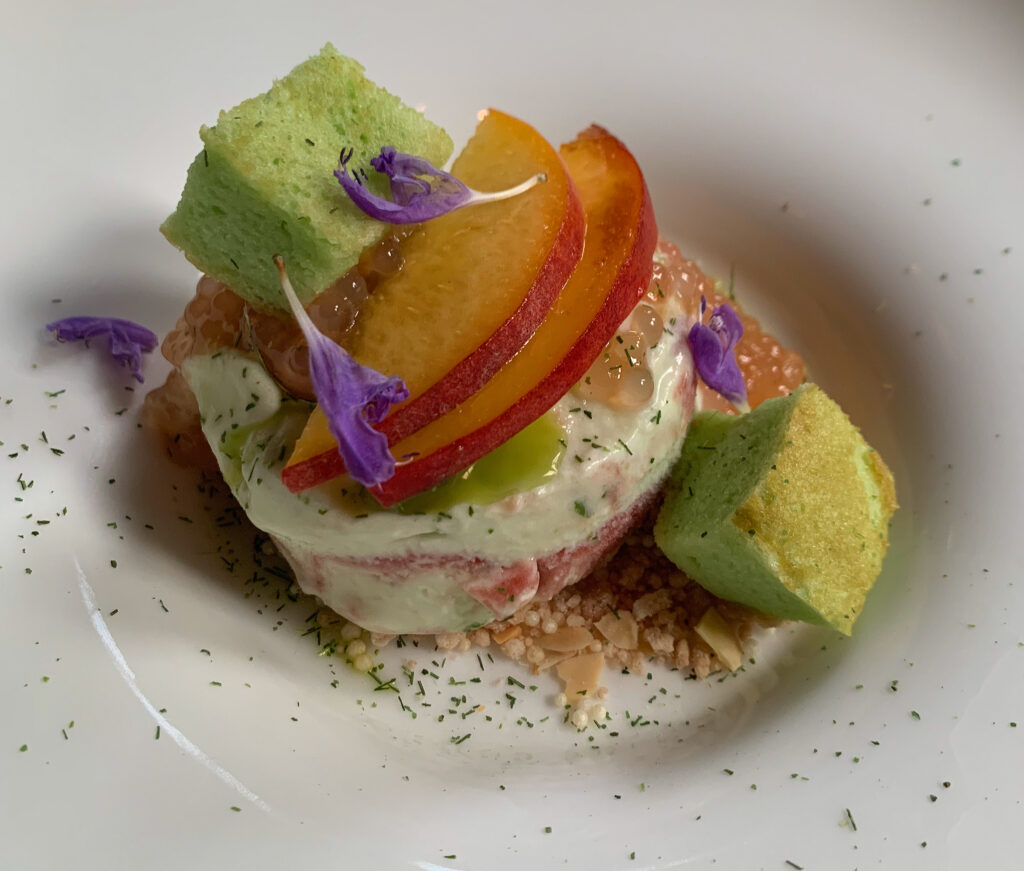
The first dish listed as part of the “Desserts” category is titled “Peach, Basil.” However, the preparation also makes prominent use of pandan: a tropical plant that is prized in Southeast Asian cuisines for its grassy, nutty, and vanillin notes (that some also compare to coconut). Thomasson draws on the pandan to make her version of a castella, a moister variant of sponge cake introduced to Japan by Portuguese merchants. Cubes of this baked delight, whose crumb is tinted green by the plant, top a disc-shaped serving of Thai basil and peach swirl ice cream. Some fresh slices of the fruit also serve as a topping while tapioca pearls, bits of almond crunch, and a pandan “dust” form the finishing touches.
At core, the “Peach, Basil” is really a kind of sundae, with the ice cream itself offering a tangy-sweet expression of fruit with an uplifting licorice quality drawn from the herb. Yet, while this flavor profile almost sounds more appropriate for a sorbet, there’s a nice creaminess that joins with the moist cubes of cake, slick-starchy tapioca, and crisp pieces of almonds to make for an engaging textural experience. The pandan, too, has a decisive influence when it comes to flavor. The plant, via the castella and “dust,” accentuates the nutty crunch at the bottom of the bowl and imbues the peach with a greater depth of sweetness. This ensures the dish’s bright and fruity quality is balanced by a degree of decadence befitting a final course—one that announces itself through the moderate, lip-smacking finish. Ultimately, this is a good effort and a preparation that has also displayed increasing textural refinement across subsequent encounters.
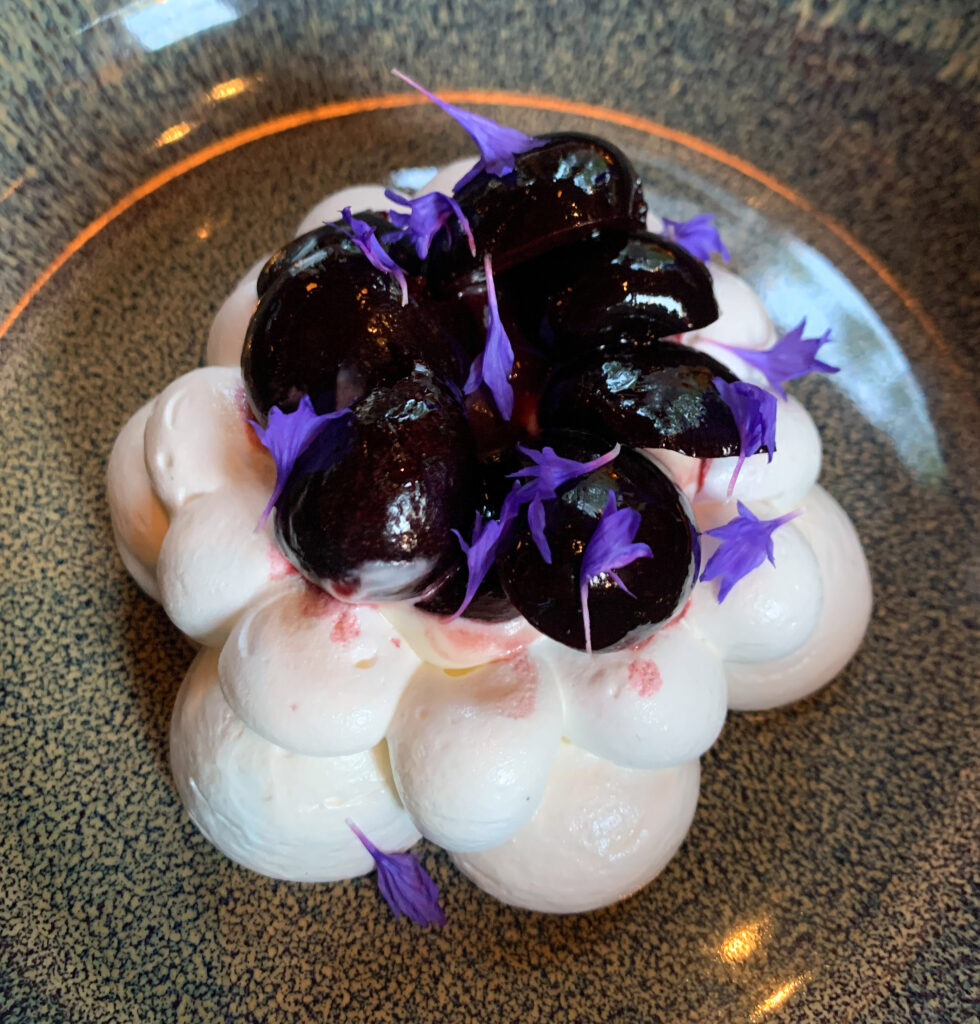
The next dessert offered is the “Cherry Pavlova,” whose name may be invoked by the server when explaining why exactly the kitchen requires your full order (sweets included) at once. The dish, which they tend to favor when asked for a recommendation, makes use of a fresh meringue that demands 45 minutes of lead time. This element serves as the base for the titular fruit, plump and slick with a coating of Seedling cherry coulis, along with a cream cheese Chantilly and a central scoop of Amarena cherry gelato. A scattering of purple flower petals then forms a dramatic final flourish.
Diving in, the meringue displays a crisp exterior with a luscious, marshmallowy interior that melds beautifully with the lighter whipped cream and tempered gelato. These smooth, slick textures are a natural foil for the plump, gushing cherries; however, they also possess a good degree of weight that ensures the dish feels satisfying for those who have chosen it. In terms of flavor, the cherry understandably takes center stage. Nonetheless, there is a nice interplay between the tart, fresh fruit, the subtly bitter (but darkly concentrated) gelato, and the pure intensity of the coulis. Meanwhile, the Chantilly, flavored with cream cheese, matches the sour quality of the fruit and further emphasizes its sweetness. But it is the meringue, which incorporates black pepper, that surprises you with its sharpness. This sensation helps the mouth-coating element stand out a bit more among its bolder toppings and yields, once everything combines, to a pleasing citric finish. In sum, the “Cherry Pavlova” is rather classically conceived but executed with skill and offers an attractive layering of pleasing textures and flavors.
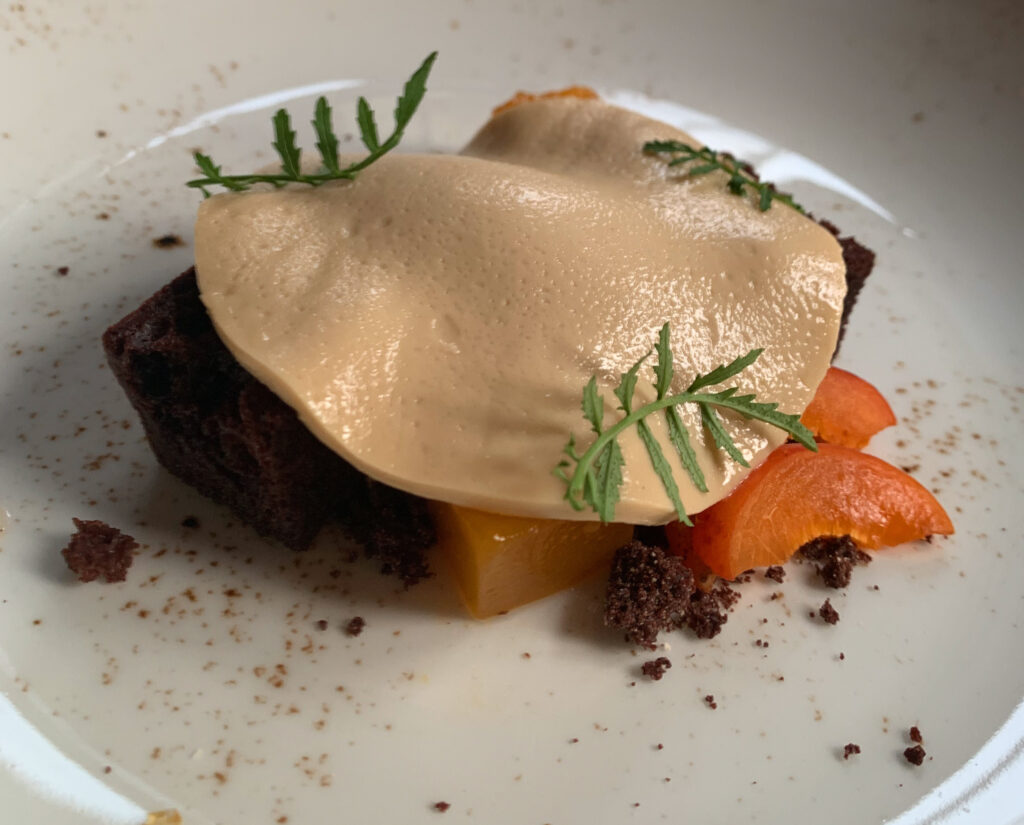
Next, with the “Chocolate, Apricot,” you come to a dish that may represent any easy choice for many diners. Just as the “Wagyu, Celtuce” soothes skeptics with the promise of a proper steak, the presence of chocolate in the title seemingly marks this as Thomasson’s most decadent dessert. That may be true, but the pastry chef’s work with the ingredient is far from straightforward. The preparation centers on a generous slice of citrus-soaked chocolate pound cake that is joined by an apricot kernel ice cream and a presentation of “apricot three ways,” which includes fresh slices of the fruit, a kind of gummy, and some globules of sauce. Most of these elements are veiled by a disc of caramelized chocolate namelaka, an “inverted ganache” made with milk, cream, and gelatin.
Approached with your spoon, that latter element breaks apart effortlessly and works to coat the moistened pound cake with a layer of melting cream. This combination melds well with the slick ice cream while the crisp apricot slices and bouncing jellies, in turn, provide a bit more contrast. With regard to flavor, the dish is defined as much by chocolate as it is by the buttery namelaka and several expressions of sweet-sour fruit. This is particularly true of the pound cake, whose citrus soaking really opens the door for the apricot elements to not seem so jarring. You might even say that those diners expecting a concentrated dose of chocolate will be a bit disappointed, but the various ingredients do blend together nicely with some distinguishing floral, nutty, and bitter notes coming to the fore. The only major fault is an errant apricot pit that found its way into the dish and startled you when it hit your teeth. Such errors happen—even at top restaurants—but must be noted for their potential to ruin someone’s meal.
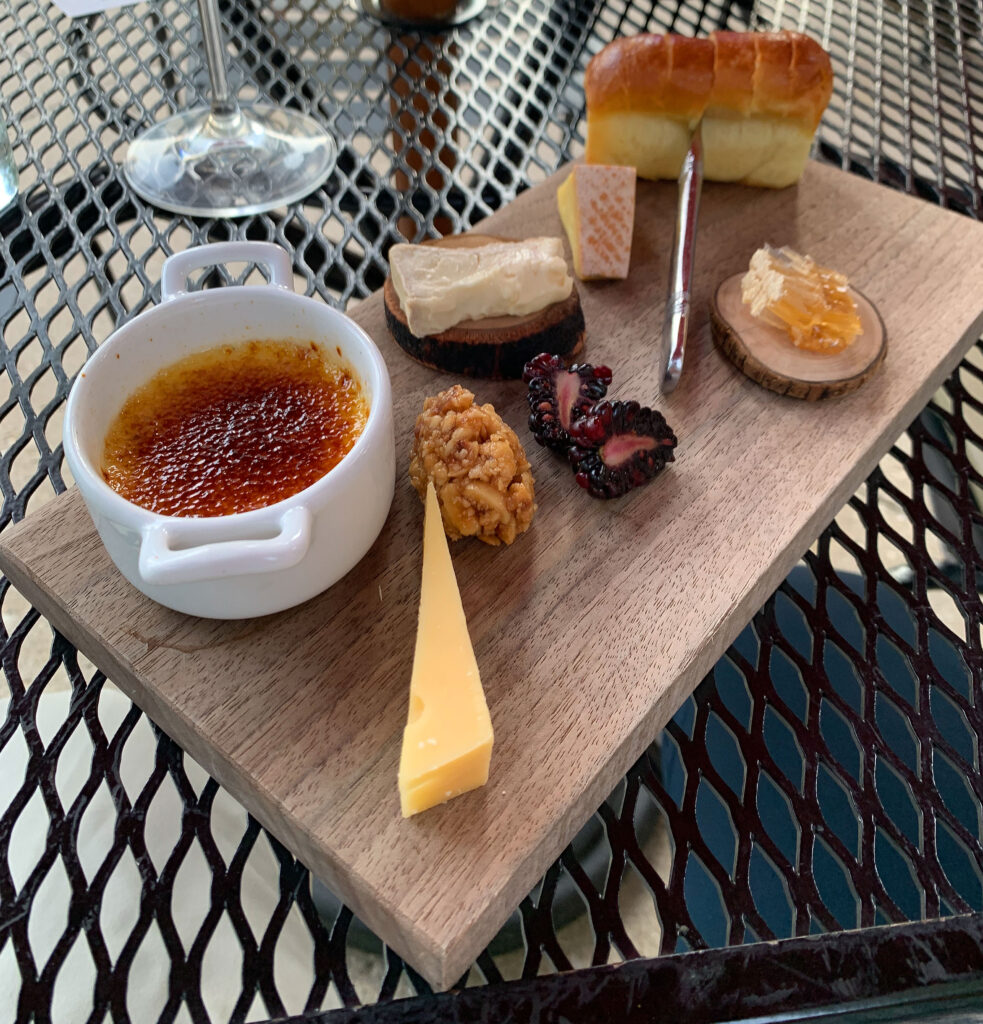
The last of the desserts offered is, without a doubt, the star. Strangely enough, you refer to a mere “Cheese Plate,” which is not only rarely done well but hardly qualifies as a composed dish in most cases. Thomasson, nonetheless, takes this composition seriously by pairing a set of three cheeses with housemade bread, a “hazelnut relish,” some honeycomb, and a halved blackberry. More specifically, there’s the Gouda-style “Old Farmdal” from Belgium, the Taleggio-style “Grayson” from Virginia’s Meadow Creek Dairy, and the Dongé “Brillante” Brie de Meaux. But the real showstopper is the truffle-Grana Padano brûlée served in its own ramekin.
Diving in, you enjoy the natural contrast between the crystalline, fruity “Old Farmdal,” the pungent, somewhat beefy “Grayson,” and the classic, soft-ripened Brie. These differences in personality are further accentuated by the notes of nut, berry, and honey provided as companions. However, the Grana Padano—a cheese likened to Parmigiano Reggiano—impresses you most with the shocking degree of umami power packed into its brûléed form. You cannot say that you even note the presence of the truffle all that much (its faint earthiness, no doubt, being a bit overshadowed). Yet the layering of caramelized, nutty, and salty flavors—especially when introducing the hazelnut or honeycomb into the mix—is absolutely sublime. This component, along with the rest of the cheeses and the soft bread, achieves a degree of hedonism that goes well beyond the other desserts and matches the best bites of the entire meal. Some of that, no doubt, has to do with the brighter seasonal fruit the pastry chef draws upon at present. But this “Cheese Plate” would be a triumph during any time of year. Incredible!
With the end of the “Desserts” section, the meal draws to a close, yet Thomasson has one more treat in store. Her “Mignardises” have changed with each of your successive dinners and comprised a “Strawberry Pâte de Fruit,” a “Passion Fruit Pâte de Fruit,” and a “Brown Butter Madeleine” (the latter technically a petit-four).
Both pâte de fruits arrive topped with the masago arare (crispy rice pearls) used throughout the savory side of the menu. They have offered a nice degree of chew with a contrasting crispness to pair with their conventionally fruity-tangy flavor. By comparison, the madeleine is a bit more impressive. The pleasantly crumbly cake comes topped with freeze-dried strawberries and a corn cream—which, apart from a bit of textural intrigue, provide the bite with a sweet, tart note that helps the nutty brown butter element really shine. What a delightful morsel!
On that note, your server arrives to inquire about how everything was and to then present you with the check. It comes with a set of North Pond branded heirloom lettuce seeds and instructions on how to sow them for your garden—an invitation (though you wonder what percentage of guests really plant them) to engage with the restaurant’s ethos back at home. In due time, the check is returned, and you are bid a final goodbye. The bussers and managers, too, offer smiles and salutations as you head to the door. Well fed, you cross the boundary that separates the old warming shelter from the surrounding wilderness. It’s a subtle transition—between the civilized world of fine dining and the full embrace of the North Pond Sanctuary—and you begin to think that you might not have left nature behind at all.
Looking back across its 25 years of operation, North Pond tells a story of permanence—timelessness—counterbalanced by a careful approach to change. You can apply such a narrative to the body of water itself and the surrounding park, carefully nurtured by the Conservancy for more than a century but meaningfully adapted to better suit the needs of aquatic, plant, bird, and human life. There’s the old 1912 structure itself, whose walls tell the tale of the building’s myriad uses but, on the back of two renovations by Nancy Warren, have now housed one of Chicago’s most singular dining rooms for more than two decades. There’s Mott, the owner who went from campus eats and hot dog stands to successive Michelin stars. He’s witnessed Diaz set the restaurant’s foundation as a seasonal café, Sherman transform it into a gastronomic destination, Vidrio preserve his former boss’s legacy during a key transitional stage, and Murillo, now, doing the same while expressing his own voice.
You can also speak of North Pond’s long-term farm partners (like Kinnikinnick) and patronage of the Green City Market. Certain culinary forms—like handmade pastas, soups, and dishes utilizing those fresh farm eggs—have proven resilient. And the wine list, though producers have cycled in and out over the years, has always showcased top artisan estates (before they make it big and those allocations, no doubt, go poof). There are also, of course, innumerable hospitality professionals past and present (of which Arents forms a living link) that have helped define the restaurant’s “special occasion” status across countless anniversaries, birthdays, graduations, and proposals.
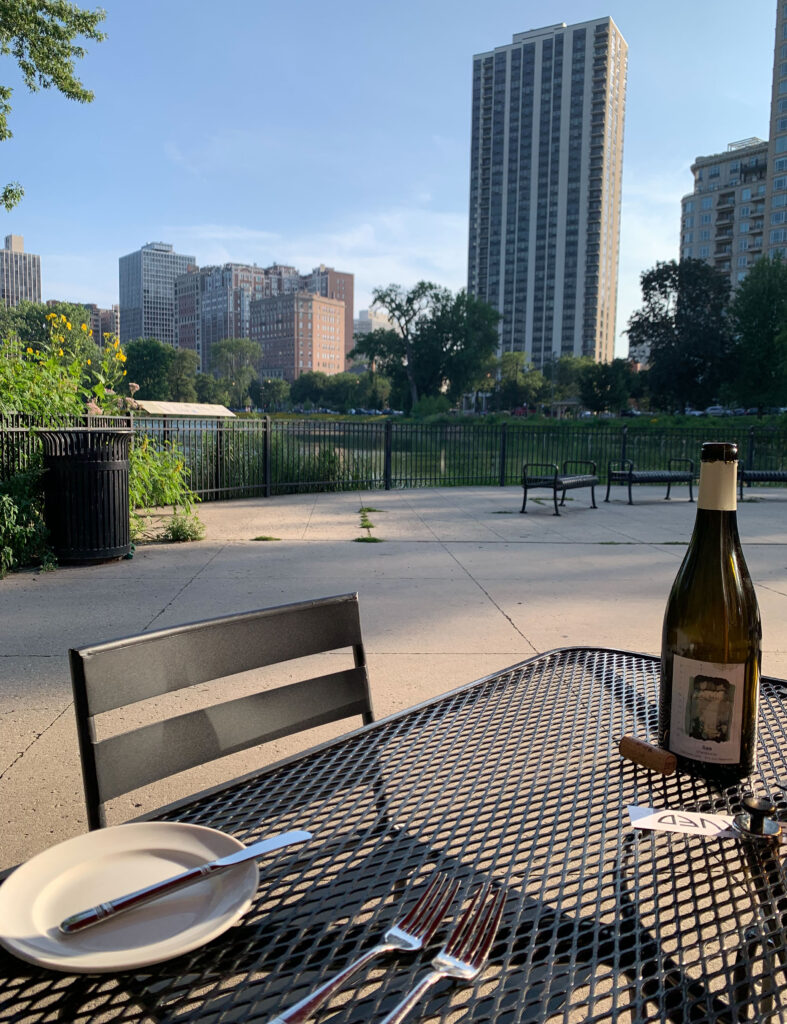
This is all to say, it is enriching to sit at North Pond and ponder the place’s history. Frankly, sitting alone on the restaurant’s patio—enjoying the prix fixe and patiently imbibing your bottle of Labet as the city’s park-going public passes you by—ranks as one of the peak aesthetic experiences you have ever had in Chicago. Yet you cannot expect all modern diners, naively following Bibendum’s recommendation with no concern for the establishment’s larger story, to be struck by the same sense of romance. Some star chasers, just as one example, find the restaurant’s timeworn structure and humble amenities to fall far below their expectations of what a Michelin-starred establishment should offer. Such a complaint betrays an essential superficiality to their character—revealing something of a narrow, conspicuous consumptive, “luxury lifestyle” mindset—but, you must admit, is still valid. Thus, as with your evaluation of Boka, it is important to untangle what North Pond represents for the initiated and the nostalgic from how it might strike a first-time, aspirational fine diner today.
Arriving at the Nature Sanctuary, you may struggle to find parking or even get a sense of where the restaurant is located. A moment of confusion is not entirely new for this level of dining (you think of the poor souls you still see wandering Armitage Avenue looking for Kyōten’s entrance), but it also hardly accords with rolling up to one of West Loop’s bastions of gastronomy. Still, North Pond’s signage ensures you eventually find your way. With proper footwear (hopefully), you take the winding path through the trees and toward the edge of the water. Amid the dogs, amateur photographers, and marathon trainees you see what amounts to a stone and brick shack with windows galore and a wraparound patio.
This is no Lawton Stanley designed palace—that’s for sure. And just what does the Arts and Crafts style amount to other than faded wood, that weird central mural, and a bunch of other bric-a-brac? The bar area, for sure, is cozy, and the greeting you receive is a warm one. There are white tablecloths, and, if you find yourself in the front room (or out on the patio), the view from your table is quite nice. However, should you be shuttled off somewhere in the back (and especially if the flies are buzzing), it may feel like you are dining at a campsite.
The bussers, whose youthful exuberance and conscientiousness struck you as charming, may very well seem clunky and awkward to a less charitable soul. Yet the servers show a more conventional kind of polish that befits Bibendum’s praise. Cocktails are enjoyable, and the wine list—while not ranking among the largest selections at this level—features bottles that are both broadly representative and highly distinctive at lower markups than nearly anywhere else in town. The $67 pairing also presents a great value, just as the $125 prix fixe ranks among the most accessible entry points to Michelin-starred cooking.
For that price (and notwithstanding the “Lobster” supplement), you get that opening “Tepache,” the “Baked Potato Roll” (with sublime “Truffle Corn Butter”), the “Green Eggs & Ham,” the Korean melon palate cleanser, and the “Mignardises” as freebies. Otherwise, you pick three savory courses from a series of three options and one dessert from a range of four options. Guests harboring larger appetites are more than welcome to order additional dishes à la carte, but, otherwise, you can expect the meal to last just under two hours.
According to the servers, Murillo changes his menu every two to three weeks, and you have found that to be true—albeit one dish at a time. Smaller components within preparations may change more frequently, but you are talking about introducing some entirely new idea.
Considering that there are only nine savory options at any given moment, this degree of dynamism is consequential. More particularly, you tasted the “Tuna Tartare” only one day after its debut and found it to be one of the best things the chef has served. Such quality speaks to the level of refinement Murillo brings to each of his new recipes, and you think it helps to justify the three-week timeframe. North Pond, despite its devotion to hyperseasonality, is not empowered to take risks in the same manner Smyth or Atelier does with their elongated formats. The chef must put out three digestible savory courses for the “special occasion” crowd while remaining true to those who have supported the restaurant’s philosophy from the beginning (or, at least, over the course of Sherman’s two decades).
This idea of customer loyalty begs a comparison to Boka, which looked to become less of a “special occasion” place with its transition from Tentori to Wolen in order to host its regulars more often. The restaurant’s cuisine, in turn, retained a seasonal focus but became less complicated and, by your measure, less bold. The tasting menu was (temporarily) jettisoned, and perennial preparations of crudo, pasta, duck, and short ribs took hold. Boka did undoubtedly succeed in becoming a friendly “anytime you have spot,” yet the pricing of the wine list makes this whole maneuver feel predatory. The switch to safer, more everyday fare has certainly undermined the creativity of a kitchen that should stand as one of the city’s most inspiring but seems totally content to sit around and earn a paycheck.
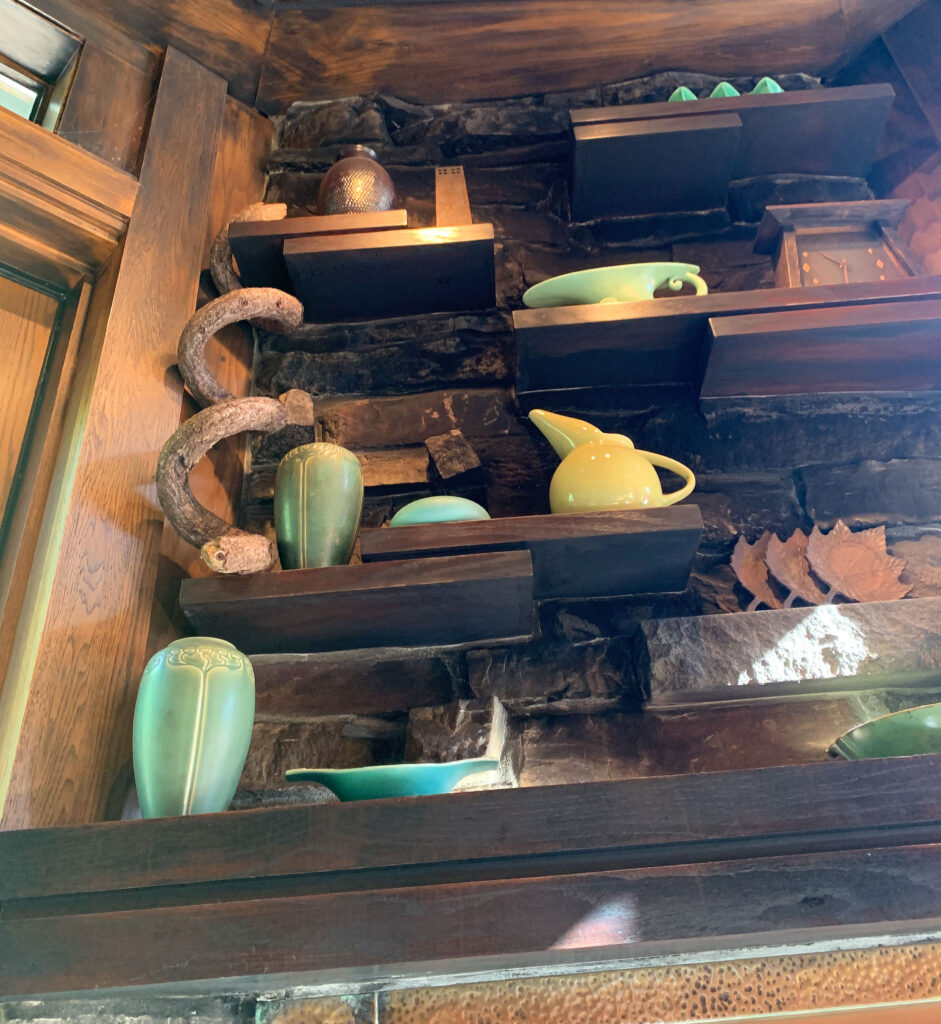
Returning to North Pond, some diners complained that Sherman’s dishes—over the course of a long career—were too fussy, too much of a senseless hodgepodge of ingredients. Looking across so many years of his work, many of his creations can seem quite wordy on paper. However, comparing menus from year to year, you might actually be tempted to term certain reoccurring recipes as modular (in the same manner you have criticized Boka). The soups, fresh eggs, pastas, fish, meat, and game are going to be stuffed or sauced with the fruit or vegetable of the moment and topped with the latest, greatest herb or flower. Seasonal, ingredient-focused cooking begins to feel like mere variations on a theme when the substance of the dish (especially when it comes to protein) must remain consistent and approachable. Does fresh produce not then become something more like window dressing than the decisive element in a given dish?
Yet, Sherman’s eclectic streak cannot be discounted. The chef was bound to use some of the same products season after season, but he also used hyperseasonality to explore the line between American and global cuisines in a manner that you still find cutting edge today. Rather than encouraging a mere paint-by-numbers approach (crafting classic combinations in a straightforward American style), a deep passion for ingredients from your own “terroir” should inspire a personal, reflexive process of honoring them in accordance with one’s nostalgias and proclivities. To this point, Sherman brought incredible life experiences to the kitchen when starting off but retained a larger curiosity and continued to grow in his influences over the years. That meant the range of techniques in the North Pond kitchen continued to multiply, and, fitted with the other moving pieces (changing ingredients and the restaurant’s classic forms), so-called “modular” cooking could always seem fresh.
Sherman established this standard of dynamic, worldly (but still, at core, local) cuisine over a long period while Boka has had to contend with clearer stylistic shifts between chefs as well as its choice to become more of a neighborhood place. North Pond, no doubt, has benefitted from such a long period of stability, but the restaurant has finally—with Murillo (and with Vidrio’s tenure marred by the pandemic)—had to reckon with real change.
It must be kept in mind that Sherman, in his era, offered an extensive à la carte menu (alongside the tasting) through which he could explore many more ideas at a given time. Murillo, instead, is working in a prix-fixe format that offers little room for error: just nine savory dishes, plus a few extra bites and a supplement, that look to keep North Pond’s longstanding identity alive (and retain that Michelin star) while pleasing a new generation of “special occasion diners.” It is too early to state decisively whether this format represents a step backward for the restaurant creatively or is simply the best way to ensure its success during a tricky (post-pandemic and also transitional) period. However, Murillo is already showing himself to be a worthy successor to Sherman.
While it may be tempting to point to Murillo’s Mexican identity as the key to understanding his work, the chef’s experience with his own culture is only one of a great many lenses he uses to approach seasonal cuisine. More specifically, he thoughtfully wields the “molecular” techniques seen at Grace and embraces Eastern European, French, Indian, Japanese, Korean, Mexican, and North African influences while being led, as always, by what is at its best locally. His food is intricate but intensely flavored (in most cases) and maintains a good sense of satiation. The more exotic techniques, thus, are balanced in a way that preserves North Pond’s broad appeal, yet there is no question that the chef’s kaleidoscopic layering of textures and flavors calls Sherman’s food to mind.
Of the dishes you sampled as part of this analysis, only one (“Harold’s Risotto”) really fell flat but still displayed some interesting ideas (like the smoked vegetable “dust”). The remaining items, despite boldly blending fresh fruit, vegetable, and flower components to accentuate everything from tuna, scallop, crab, and trout to foie gras, wagyu, and lamb, all came off quite well. You would label the weakest of these preparations as “above average” or “good” at their worst. You would even describe three of them (the “Foie Gras, Ricotta,” “Rainbow Trout, Corn,” and “Lamb, Date”) as “very good” and another three (the “Tuna Tartare,” “Agnolotti, Squash Blossom,” and “Wagyu, Celtuce”) as close to “superlative.”
This is an admirable “batting average” when you consider how unconventional many of Murillo’s ingredient combinations really are. The chef largely centers the prix fixe on proteins that mainstream consumers will recognize but by no means plays it safe when it comes to what makes up the rest of his plates. In that sense, he again echoes Sherman.
It should be mentioned that Thomasson, too, maintains a high standard across all her pastry work. None of the desserts, though also bold in their flavor combinations, are underwhelming. Some (like the Korean melon palate cleanser and “Peach, Basil,”) are even quite impressive. Yet, for now, only the truffle-Grana Padano brûlée component of the “Cheese Plate” really strikes you as superlative.
In the final analysis, it would be easy for North Pond, boasting such a singular setting, to get by serving Boka’s menu with Boka’s wine pricing—becoming, in the process, a totally Disneyfied “special occasion restaurant.” Admittedly, rising to the caliber of service at BRG’s mothership would probably represent a legitimate improvement in the eyes of many diners. But, thinking back to that raw, strikingly sincere energy North Pond’s bussers bring to the table, you can sense a common thread.
It starts with Mott, being crazy enough to partner with the Park District to revitalize the old warming shelter, and Warren, who transformed the structure into a work of art. It flows through Diaz, who set the stage for seasonal cooking before realizing her higher calling, and Sherman, who crafted a personal, inimitable cuisine over a period of 20 years that Chicago today sorely lacks. There’s Vidrio, who carried the torch, and now Murillo, wielding new techniques in the same uncompromising fashion to redefine how chefs use the local bounty. There’s Thomasson, following in a long line of pastry chefs expressing seasonality with the same care seen on the savory side, and Arents, a living link to an older era who ensures (apart from setting the tone of service) the wine program feels unique and celebratory.
North Pond exudes the kind of quiet confidence that can only come from doggedly, wholeheartedly pursuing a common passion. For, when a team is truly united around a shared vision, everything else just seems to fall into place. You are not speaking of the trite, self-aggrandizing Welcome Conference style of prefabricated brand narrative, but something infinitely more simple—something true.

Just because a restaurant is located in nature does not necessarily mean it is of nature. As you just said, it would be all too easy for North Pond to be an abominable “destination restaurant” that fleeces customers in exchange for a pretty view. But the concept has always been characterized by a certain sense of restraint, honesty, generosity, and pride that flows, no doubt, from an understanding that it is but one link in a larger chain that starts with the farmer and ends with the customer. Such a chain starts, in truth, with nature herself—the very landscape that surrounds the restaurant and serves as a constant reminder of just whom the team is really working to honor.
North Pond, under Murillo, is not perfect, but it is totally at peace with itself. It is totally devoted to a vision and a process that does not yield obvious fireworks but still generates novel, thoughtful seasonal cuisine. Yes, as with many forward-thinking restaurants, hedonic pleasure is here more of a byproduct than a goal. The chef expresses his prized local ingredients intellectually, composing plates of varied textures and flavors that achieve an uncommon harmony. He leaves enough on the plate to please entry-level diners—particularly the perfectly cooked proteins—while revealing a side of fresh produce that even experienced eaters have not encountered before.
Murillo makes this balancing act seem deceivingly simple, but it is really essential work: getting mainstream consumers through the door, at a reasonable price, and opening their eyes to the bounty in their own backyard while ceaselessly advancing the kitchen’s own craft. You are a true believer in this mission—you will admit that—and it is easy to admire North Pond as one of just a few shining restaurants (Lula Cafe, Atelier, Smyth) totally devoted to the expression of Midwestern terroir.
Nonetheless, prizing the faithful representation of local ingredients over all else can be contentious. It means abandoning the carrots chefs use to charm to transient “foodies” and, as a result, handicapping the restaurant’s social media appeal. Yes, Murillo’s plates are pretty—in a naturalistic sort of way—but they are not equipped to go viral. The chef uses his “molecular” Grace techniques for good, and the resulting dishes are completely removed, even when invoking foie gras or wagyu, from what conspicuous consumers would consider trendy. They also do not aim unabashedly for decadence in the manner that some diners, equating Michelin stars purely with the expression of pleasure, expect. When you also consider the misgivings some people have regarding the restaurant’s lack of “luxurious” trappings, it is easy to see why a certain demographic might leave dissatisfied.

North Pond’s philosophy and the kind of cooking it entails may be impenetrable for an outsider. The restaurant’s setting may mean nothing to someone who has dined on the Côte d’Azur. The wine list, however well priced, may lack the towering labels that a real snob would wish to see. So, with only nine savory dishes (and three courses in a given meal) to work with, Murillo must make his food faultless. It must be convincing for those who are not predisposed to care about any of the valuable work his team is doing—that North Pond has done—for decades.
The cuisine is not quite there yet but, undoubtedly, has shown flashes of brilliance. More importantly, the chef has demonstrated his commitment to a dynamic creative process, one that fearlessly excises successful dishes in order to empower further, bolder explorations of texture, flavor, and seasonality. If Murillo continues to run his kitchen in this fashion, it is only a matter of time before the restaurant’s full range of dishes—at any given time—displays the kind of mastery his best preparations have already suggested.
In the meantime, North Pond shines as one of Chicago’s most singular, captivating restaurants for those who can open themselves up to a more considered kind of gastronomy. The former warming shelter invites you to engross yourself in nature, to recognize the chef not as a manipulator of its bounty but a mere translator. The resulting cuisine touches you not with its egotistic pursuit of pleasure. Rather, it works to showcase a moment in time—one fleeting moment in time—that all living things share. Doing so, it affirms the essential bond between you and all organisms outside of yourself. And it helps you understand, just a little bit better, your small but interconnected place in this vast universe. No doubt, not everyone will feel that connection, but the restaurant works hard to make it accessible to all who are equipped to do so.
25 years on, North Pond transcends time and, should patrons continue to support its new chef, may very well shape the future of Chicago dining.


